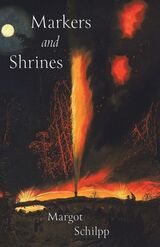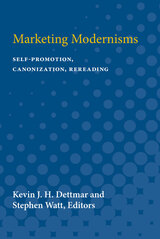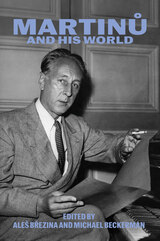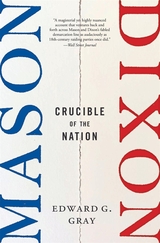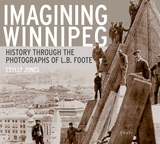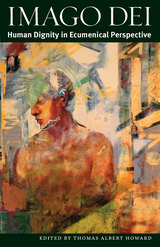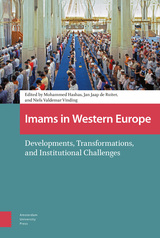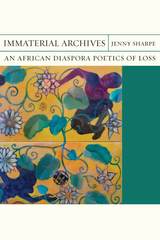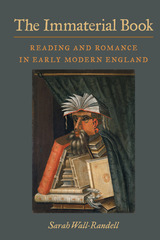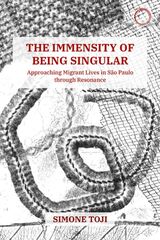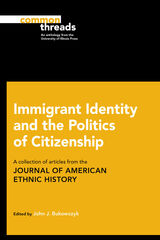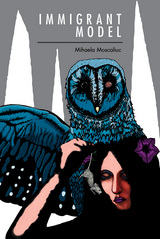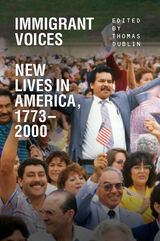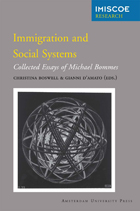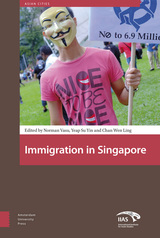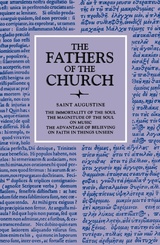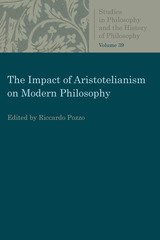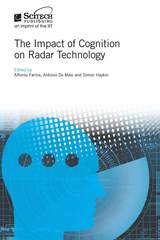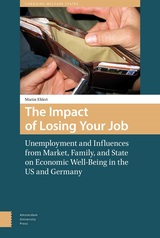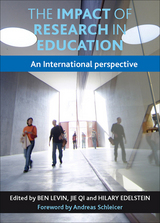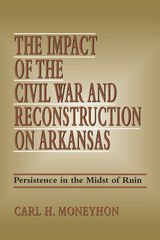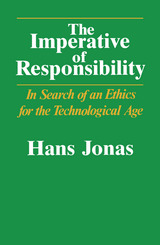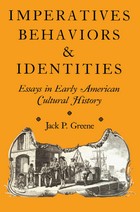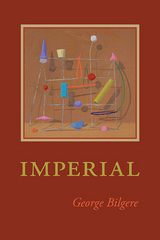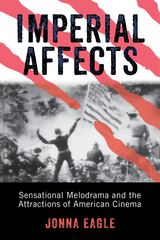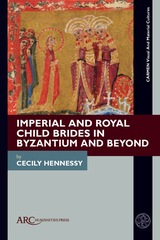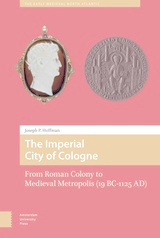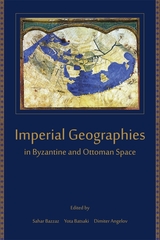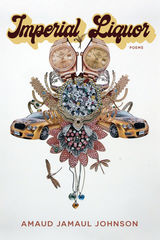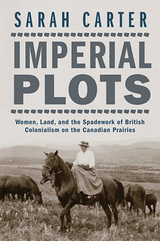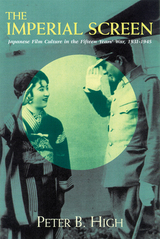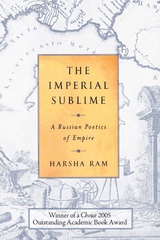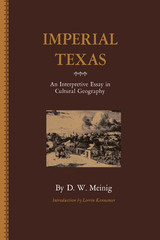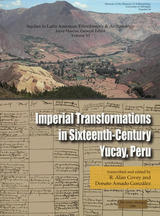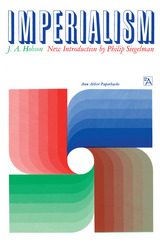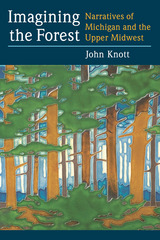 Imagining the Forest: Narratives of Michigan and the Upper Midwest
John Knott
University of Michigan Press, 2011 Forests have always been more than just their trees. The forests in Michigan (and similar forests in other Great Lakes states such as Wisconsin and Minnesota) played a role in the American cultural imagination from the beginnings of European settlement in the early nineteenth century to the present. Our relationships with those forests have been shaped by the cultural attitudes of the times, and people have invested in them both moral and spiritual meanings. Author John Knott draws upon such works as Simon Schama's Landscape and Memory and Robert Pogue Harrison's Forests: The Shadow of Civilization in exploring ways in which our
relationships with forests have been shaped, using Michigan---its history of settlement, popular literature, and forest management controversies---as an exemplary case. Knott looks at such well-known figures as William Bradford, James Fenimore Cooper, John Muir, John Burroughs, and Teddy Roosevelt; Ojibwa conceptions of the forest and natural world (including how Longfellow mythologized them); early explorer accounts; and contemporary literature set in the Upper Peninsula, including Jim Harrison's True North and Philip Caputo's Indian Country. Two competing metaphors evolved over time, Knott shows: the forest as howling wilderness, impeding the progress of civilization and in need of subjugation, and the forest as temple or cathedral, worthy of reverence and protection. Imagining the Forestshows the origin and development of both.
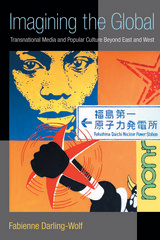 Imagining the Global: Transnational Media and Popular Culture Beyond East and West
Fabienne Darling-Wolf
University of Michigan Press, 2014 Based on a series of case studies of globally distributed media and their reception in different parts of the world, Imagining the Global reflects on what contemporary global culture can teach us about transnational cultural dynamics in the 21st century. A focused multisited cultural analysis that reflects on the symbiotic relationship between the local, the national, and the global, it also explores how individuals’ consumption of global media shapes their imagination of both faraway places and their own local lives. Chosen for their continuing influence, historical relationships, and different geopolitical positions, the case sites of France, Japan, and the United States provide opportunities to move beyond common dichotomies between East and West, or United States and “the rest.” From a theoretical point of view, Imagining the Global endeavors to answer the question of how one locale can help us understand another locale. Drawing from a wealth of primary sources—several years of fieldwork; extensive participant observation; more than 80 formal interviews with some 160 media consumers (and occasionally producers) in France, Japan, and the United States; and analyses of media in different languages—author Fabienne Darling-Wolf considers how global culture intersects with other significant identity factors, including gender, race, class, and geography. Imagining the Global investigates who gets to participate in and who gets excluded from global media representation, as well as how and why the distinction matters.
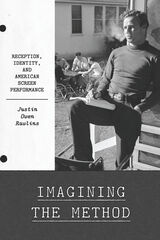 Imagining the Method: Reception, Identity, and American Screen Performance
Justin Owen Rawlins
University of Texas Press, 2024 A revisionist history of Method acting that connects the popular reception of “methodness” to entrenched understandings of screen performance still dominating American film discourse today.
Only one performance style has dominated the lexicon of the casual moviegoer: “Method acting.” The first reception-based analysis of film acting, Imagining the Method investigates how popular understandings of the so-called Method—what its author Justin Rawlins calls "methodness"—created an exclusive brand for white, male actors while associating such actors with rebellion and marginalization. Drawing on extensive archival research, the book maps the forces giving shape to methodness and policing its boundaries. Imagining the Method traces the primordial conditions under which the Method was conceived. It explores John Garfield's tenuous relationship with methodness due to his identity. It considers the links between John Wayne's reliance on "anti-Method" stardom and Marlon Brando and James Dean's ascribed embodiment of Method features. It dissects contemporary emphases on transformation and considers the implications of methodness in the encoding of AI performers. Altogether, Justin Rawlins offers a revisionist history of the Method that shines a light on the cultural politics of methodness and the still-dominant assumptions about race, gender, and screen actors and acting that inform how we talk about performance and performers.
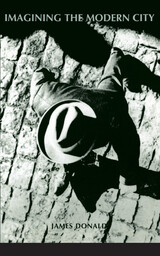 Imagining The Modern City
James Donald
University of Minnesota Press, 1999 An engaging look at the cultural legacy of the twentieth-century city and how it affects our ideas of community and democracy.
Paris, Berlin, London, Singapore, New York, Chicago, Los Angeles--these define "the city" in the world's consciousness. James Donald takes us on a psychic journey to these places that have inspired artists, writers, architects, and filmmakers for centuries. Considering the cultural and political implications of the "urban imaginary," Donald explores the pleasures and challenges of modern living, contending that the imagined city remains the best lens for a future of democratic community.
How can we think of Chicago without recalling the grittiness of The Asphalt Jungle's back alleys, or of London without the dank, foggy atmosphere so often evoked by Dickens? When de Certeau explores what it means to walk through a city, or Foucault dissects the elements of the modern attitude, what are they telling us about modernity itself? Through a discussion of these and many other questions about urban thought, Donald demonstrates how artists and social critics have seen the city as the locus not just of vanity, squalor, and injustice, but also of civilized society's highest aspirations.
Imagining the Modern City also looks at how artists have shaped cities through their creation of public spaces, sculpture, and architecture--art forms that help determine our ideas about our place in the urban environment. Planners and architects such as Otto Wagner, Le Corbusier, and Bernard Tschumi present us with real and possible cities, showing a way forward to alternative social futures, Donald asserts.
The modern city provides both a culturally resonant imagined space and a physical place for the everyday life of its residents. Imagining the Modern City is a rich and dazzling exploration of the ways cities stir and shape our consciousness.
"In Imagining the Modern City, Donald, a British professor of communications and cultural studies based in Australia, seeks to explain the uneasy interaction between city and citizen by drawing together literary, cinematic, architectural, and sociological evocations of the metropolis from the past two centuries. He begins with the stratified geography of Dickens' London, in which neighborhood determined social position, then moves on to Baudelaire's changing Paris, the German-Jewish sociologist Georg Simmel's imperial Berlin, the seedy Chicago of The Asphalt Jungle, Joyce's Dublin, and finally, the hallucinatory visions of Fritz Lang's Metropolis, Tim Burton's Gotham City, and modern-day Singapore. Donald believes that all of these cities are not so much physical places as constructs of media and mind." Liesl Schillinger in Metropolis
"Donald's fluid writing weaves familiar scholarly territory into a warm and inviting narrative that reflects his own passion for the city. A most important contribution, the sort that ends in a question mark rather than a period." Environment and Planning D: Society and Space
"Cities are back in fashion, at least in theory. Imagining the Modern City juxtaposes imagination an politics, the city and modernity. The panache of Donald's writing and his integration of biography and fiction, visual images and critical reflection on the vast array of popular cultural versions of the modern city make Imagining the Modern City both page turning and illuminating. A quirky and personable style combined with a judicious use of photos, drawings, and films adds interest and critical insight." Thesis Eleven
"A stimulating and engaging meditation on the city and the urban imaginary that explores both the pleasures and the challenges of modern living. Donald uses the culture of cities to open up important questions about modernity and, particularly, modern political culture." Kevin Robins
"The city tugs at the imagination and the imagination tugs the city. In an exemplary fashion, Donald shows the truth of this statement. An acute and often surprising book that shows real sympathy for the city, warts and all." Nigel Thrift
"To dare to rewrite the political map of the city as a poetic one, as Donald does, is to insist that this other, imaginative side of the metropolis is as important to how we live the city, walk its streets and dream our selves, as are the political expectancies we think it embodies."
Iain Chambers
James Donald is professor of communications and cultural studies at Curtin University of Technology in Perth, Australia.
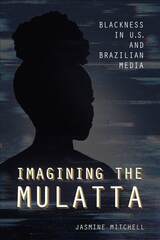 Imagining the Mulatta: Blackness in U.S. and Brazilian Media
Jasmine Mitchell
University of Illinois Press, 2020 Brazil markets itself as a racially mixed utopia. The United States prefers the term melting pot. Both nations have long used the image of the mulatta to push skewed cultural narratives. Highlighting the prevalence of mixed race women of African and European descent, the two countries claim to have perfected racial representation—all the while ignoring the racialization, hypersexualization, and white supremacy that the mulatta narrative creates. Jasmine Mitchell investigates the development and exploitation of the mulatta figure in Brazilian and U.S. popular culture. Drawing on a wide range of case studies, she analyzes policy debates and reveals the use of mixed-Black female celebrities as subjects of racial and gendered discussions. Mitchell also unveils the ways the media moralizes about the mulatta figure and uses her as an example of an ”acceptable” version of blackness that at once dreams of erasing undesirable blackness while maintaining the qualities that serve as outlets for interracial desire.
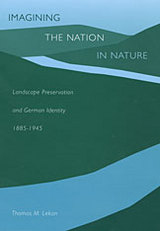 Imagining the Nation in Nature: Landscape Preservation and German Identity, 1885–1945
Thomas M. Lekan
Harvard University Press, 2004 One of the most powerful nationalist ideas in modern Europe is the assertion that there is a link between people and their landscape. Focusing on the heart of German romanticism, the Rhineland, Thomas Lekan examines nature protection activities from Wilhelmine Germany through the end of the Nazi era to illuminate the relationship between environmental reform and the cultural construction of national identity.
In the late nineteenth century, anxieties about national character infused ecological concerns about industrialization, spurring landscape preservationists to protect the natural environment. In the Rhineland’s scenic rivers, forests, and natural landmarks, they saw Germany as a timeless and organic nation rather than a recently patchworked political construct. Landscape preservation also served conservative social ends during a period of rapid modernization, as outdoor pursuits were promoted to redirect class-conscious factory workers and unruly youth from “crass materialism” to the German homeland. Lekan’s examination of Nazi environmental policy challenges recent work on the “green” Nazis by showing that the Third Reich systematically subordinated environmental concerns to war mobilization and racial hygiene.
This book is an original contribution not only to studies of national identity in modern Germany but also to the growing field of European environmental history.
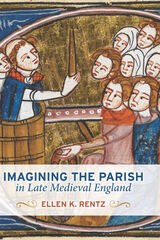 Imagining the Parish in Late Medieval England
Ellen K. Rentz
Ohio State University Press, 2015 Collective worship and the ritual life of the local parish mattered deeply to late medieval laypeople, and both loom large in contemporary visual and vernacular culture. The parish offered an important framework for Christians as they negotiated the relationship between individual, community, and God. And as a place where past, present, and future came together, the parish promised an ongoing relationship between the living and the dead, positioning the here and now of the local parish in the long trajectory of eschatological time.
Imagining the Parish in Late Medieval England explores the ways in which Middle English literature engages the idea of lay spiritual community and the ideal of parochial worship. Ellen K. Rentz pairs nuanced readings of works such as Piers Plowman,Handlyng Synne, and the Prick of Conscience with careful analysis of contemporary sermons, spiritual handbooks, and liturgical texts as well as a wide range of visual sources, including wall paintings and stained glass. This new study examines how these texts and images locate the process of achieving salvation in the parish and in the work that parishioners undertook there together.
Imagining the Penitentiary: Fiction and the Architecture of Mind in Eighteenth-Century England
John Bender
University of Chicago Press, 1987 This brilliant and insightful contribution to cultural studies investigates the role of literature—particularly the novel—and visual arts in the development of institutions. Arguing the attitudes expressed in narrative literature and art between 1719 and 1779 helped bring about the change from traditional prisons to penitentiaries, John Bender offers studies of Robinson Crusoe, Moll Flanders, The Beggar's Opera, Hogarth's Progresses, Jonathan Wild, and Amelia as well as illustrations from prison literature, art, and architecture in support of his thesis.
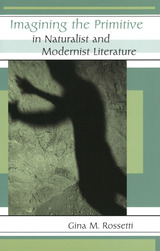 Imagining the Primitive in Naturalist and Modernist Literature
Gina M. Rossetti
University of Missouri Press, 2006
From Herman Melville’s Queequeg to Ken Kesey’s Chief Bromden, primitive characters have played key roles in literature and have generally emerged as enduring and sympathetic figures. In this book, Gina M. Rossetti focuses on works by Jack London, Frank Norris, Eugene O’Neill, Theodore Dreiser, Willa Cather, Ernest Hemingway, Gertrude Stein, and Nella Larsen, arguing that primitive literary characters reveal complex and culturally based assumptions.
In the period of 1895 to 1929, Rossetti asserts, the primitive serves as a literary figure whose presence might link naturalism and modernism. Defining the primitive as “the dominant culture’s projection of its internal fear, anxieties, and attractions,” Rossetti explores how the working class and racial and ethnic minorities came to occupy the position of “primitives” and the degree to which more privileged individuals imagined themselves through the lens of this sometimes denigrated and sometimes romanticized Other. For the selected naturalist authors, the primitive is rendered in a Darwinian context, representing a figure whose presence will jeopardize American cultural identity by being evolutionarily inferior.
In modernist literature of the twentieth century, however, the primitive separates from Darwinism and becomes aestheticized. In much of the literature from this period, the primitive functions as a naive posture for the artist to assume in order to escape the complications of modern life.
The late nineteenth and early twentieth centuries were a time of growing concern for the “vanishing Anglo Saxon,” and the primitive figure is often linked with theories of race. In this context, the racial primitive reflects the culture’s need for, and perpetuation of, a racial Other who gives body and shape to American identity. The final evocation of the primitive combines both the naturalists’ preoccupation with race-based notions of personhood and the modernists’ desire for a romantic escape.
Whether the primitive is invoked positively or negatively, Rossetti argues, it delineates the limits of American identity and, in the time period covered, often induces a double-edged response. The primitive’s marginality suggests the degree to which authors, privileged and otherwise, rely on its embedded presence in our national literature. Rossetti ultimately demonstrates that the primitive is not static but rather inconsistent and transformational, the source from which many naturalist and modernist texts project their concerns, fears, and contradictions.
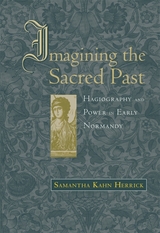 Imagining the Sacred Past: Hagiography and Power in Early Normandy
Samantha Kahn Herrick
Harvard University Press, 2007 In 911, the French king ceded land along the river Seine to Rollo the Viking, on condition that he convert to Christianity. Over the next century and a half, Rollo and his descendants would become powerful and pious Christian rulers of the mighty European territory, Normandy. In 1066, Rollo's descendant William would conquer England, with papal sanction.
Investigating the role of religious tradition in the legitimation of power and the establishment of identity, Samantha Kahn Herrick illuminates the often murky early history of the duchy of Normandy. Central to this religious heritage stood the region's traditional saints, whose deeds, recorded in Latin lives, were celebrated regularly. Herrick focuses on the neglected figures Taurinus of Evreux, Vigor of Bayeux, and Nicasius of Rouen, saints with particular resonance in areas central to the Norman dukes' territorial ambitions. In elaborating a vision of the past that helped explain the present, the saints' stories sanctioned the dukes' rule.
Innovative in its historical use of hagiographical literature, this work advances our understanding of early Normandy and the Vikings' transformation from pagan raiders to Christian princes. It also sheds light on the intersection of religious tradition, identity, and power.
 Imagining the Tropics: Women, Romance, and the Making of Modern Tourism
Elizabeth S. Manley
Rutgers University Press, 2025 Imagining the Tropics is a history of the development of tourism in the Caribbean from the 1910s through the 1970s that focuses on the ways women’s labors of hospitality, writing, and advocacy built the industry and its ubiquitous imagery of tropical island relaxation, escape, and romance. By examining a range of sources, engaging an array of women protagonists, and looking broadly across multiple Caribbean island-states including Jamaica, Cuba, the Bahamas, Barbados, the Dominican Republic, Haiti, Puerto Rico, Trinidad and Tobago, and the U.S. and British Virgin Islands, it seeks to understand how the region came to be sold as a romantic escape from the “troubles” of the modern world. By putting women at the center of Caribbean tourism history—as both its ambassadors and objects of desire—it seeks to explain some of the complicated contradictions that plague the business of pleasure but also to point toward ways of building alternative models to its present and past extractive realities.
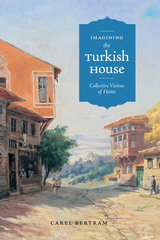 Imagining the Turkish House: Collective Visions of Home
By Carel Bertram
University of Texas Press, 2008 "Houses can become poetic expressions of longing for a lost past, voices of a lived present, and dreams of an ideal future." Carel Bertram discovered this truth when she went to Turkey in the 1990s and began asking people about their memories of "the Turkish house." The fondness and nostalgia with which people recalled the distinctive wooden houses that were once ubiquitous throughout the Ottoman Empire made her realize that "the Turkish house" carries rich symbolic meaning. In this delightfully readable book, Bertram considers representations of the Turkish house in literature, art, and architecture to understand why the idea of the house has become such a potent signifier of Turkish identity. Bertram's exploration of the Turkish house shows how this feature of Ottoman culture took on symbolic meaning in the Turkish imagination as Turkey became more Westernized and secular in the early decades of the twentieth century. She shows how artists, writers, and architects all drew on the memory of the Turkish house as a space where changing notions of spirituality, modernity, and identity—as well as the social roles of women and the family—could be approached, contested, revised, or embraced during this period of tumultuous change.
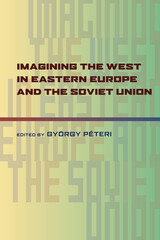 Imagining the West in Eastern Europe and the Soviet Union
Gyorgy Peteri
University of Pittsburgh Press, 2010
This volume presents work from an international group of writers who explore conceptualizations of what defined “East” and “West” in Eastern Europe, imperial Russia, and the Soviet Union. The contributors analyze the effects of transnational interactions on ideology, politics, and cultural production. They reveal that the roots of an East/West cultural divide were present many years prior to the rise of socialism and the cold war.
The chapters offer insights into the complex stages of adoption and rejection of Western ideals in areas such as architecture, travel writings, film, music, health care, consumer products, political propaganda, and human rights. They describe a process of mental mapping whereby individuals “captured and possessed” Western identity through cultural encounters and developed their own interpretations from these experiences. Despite these imaginaries, political and intellectual elites devised responses of resistance, defiance, and counterattack to defy Western impositions.
Socialists believed that their cultural forms and collectivist strategies offered morally and materially better lives for the masses and the true path to a modern society. Their sentiments toward the West, however, fluctuated between superiority and inferiority. But in material terms, Western products, industry, and technology, became the ever-present yardstick by which progress was measured. The contributors conclude that the commodification of the necessities of modern life and the rise of consumerism in the twentieth century made it impossible for communist states to meet the demands of their citizens. The West eventually won the battle of supply and demand, and thus the battle for cultural influence.
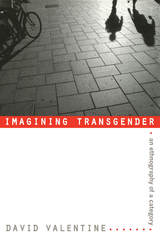 Imagining Transgender: An Ethnography of a Category
David Valentine
Duke University Press, 2007 Imagining Transgender is an ethnography of the emergence and institutionalization of transgender as a category of collective identity and political activism. Embraced by activists in the early 1990s to advocate for gender-variant people, the category quickly gained momentum in public health, social service, scholarly, and legislative contexts. Working as a safer-sex activist in Manhattan during the late 1990s, David Valentine conducted ethnographic research among mostly male-to-female transgender-identified people at drag balls, support groups, cross-dresser organizations, clinics, bars, and clubs. However, he found that many of those labeled “transgender” by activists did not know the term or resisted its use. Instead, they self-identified as “gay,” a category of sexual rather than gendered identity and one rejected in turn by the activists who claimed these subjects as transgender. Valentine analyzes the reasons for and potential consequences of this difference, and how social theory is implicated in it. Valentine argues that “transgender” has been adopted so rapidly in the contemporary United States because it clarifies a model of gender and sexuality that has been gaining traction within feminism, psychiatry, and mainstream gay and lesbian politics since the 1970s: a paradigm in which gender and sexuality are distinct arenas of human experience. This distinction and the identity categories based on it erase the experiences of some gender-variant people—particularly poor persons of color—who conceive of gender and sexuality in other terms. While recognizing the important advances transgender has facilitated, Valentine argues that a broad vision of social justice must include, simultaneously, an attentiveness to the politics of language and a recognition of how social theoretical models and broader political economies are embedded in the day-to-day politics of identity.
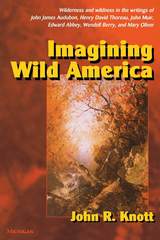 Imagining Wild America
John Knott
University of Michigan Press, 2002 At a time when the idea of wilderness is being challenged by both politicians and intellectuals, Imagining Wild America examines writing about wilderness and wildness and makes a case for its continuing value. The book focuses on works by John James Audubon, Henry David Thoreau, John Muir, Edward Abbey, Wendell Berry, and Mary Oliver, as each writer illustrates different stages and dimensions of the American fascination with wild nature. John Knott traces the emergence of a visionary tradition that embraces values consciously understood to be ahistorical, showing that these writers, while recognizing the claims of history and the interdependence of nature and culture, also understand and attempt to represent wild nature as something different, other.
A contribution to the growing literature of eco-criticism, the book is a response to and critique of recent arguments about the constructed nature of wilderness. Imagining Wild America demonstrates the richness and continuing importance of the idea of wilderness, and its attraction for American writers.
John R. Knott is Professor of English, University of Michigan. His previous books include The Huron River: Voices from the Watershed, coedited with Keith Taylor.
 Imagining Wild Bill: James Butler Hickok in War, Media, and Memory
Paul Ashdown and Edward Caudill
Southern Illinois University Press, 2020 Wild Bill’s ever-evolving legend
When it came to the Wild West, the nineteenth-century press rarely let truth get in the way of a good story. James Butler “Wild Bill” Hickok’s story was no exception. Mythologized and sensationalized, Hickok was turned into the deadliest gunfighter of all, a so-called moral killer, a national phenomenon even while he was alive.
Rather than attempt to tease truth from fiction, coauthors Paul Ashdown and Edward Caudill investigate the ways in which Hickok embodied the culture of glamorized violence Americans embraced after the Civil War and examine the process of how his story emerged, evolved, and turned into a viral multimedia sensation full of the excitement, danger, and romance of the West.
Journalists, the coauthors demonstrate, invented “Wild Bill” Hickok, glorifying him as a civilizer. They inflated his body count and constructed his legend in the midst of an emerging celebrity culture that grew up around penny newspapers. His death by treachery, at a relatively young age, made the story tragic, and dime-store novelists took over where the press left off. Reimagined as entertainment, Hickok’s legend continued to enthrall Americans in literature, on radio, on television, and in the movies, and it still draws tourists to notorious Deadwood, South Dakota.
American culture often embraces myths that later become accepted as popular history. By investigating the allure and power of Hickok’s myth, Ashdown and Caudill explain how American journalism and popular culture have shaped the way Civil War–era figures are remembered and reveal how Americans have embraced violence as entertainment.
Imago Dei
Thomas Albert Howard
Catholic University of America Press, 2013 Imago Dei will serve as an indispensable resource for those wishing to deepen their grasp of the theological bases for Christian views of human dignity, as well as for those who believe that Christ's words "that they be one" (John 17:21) remain a theological imperative today
Imago Musicae: Volume I
Tilman Seebass, ed.
Duke University Press Each volume in this series for the study of pictorial documents on musical subjects contains articles, a catalog (published in installments) devoted to the complete documentation of specific sources, and an annual bibliography that bridges the gap between the bibliographies in art history and musicology.
Imago Musicae, Volume III
Tilman Seebass, ed.
Duke University Press, 1987 Each volume in this series for the study of pictorial documents on musical subjects contains articles, a catalog (published in installments) devoted to the complete documentation of specific sources, and an annual bibliography that bridges the gap between the bibliographies in art history and musicology.
Imago Musicae, Volume IV
Tilman Seebass, ed.
Duke University Press, 1988 Each volume in this series for the study of pictorial documents on musical subjects contains articles, a catalog (published in installments) devoted to the complete documentation of specific sources, and an annual bibliography that bridges the gap between the bibliographies in art history and musicology.
Imago Musicae, Volume V
Tilman Seebass, ed.
Duke University Press Each volume in this series for the study of pictorial documents on musical subjects contains articles, a catalog (published in installments) devoted to the complete documentation of specific sources, and an annual bibliography that bridges the gap between the bibliographies in art history and musicology.
Imams in Western Europe: Developments, Transformations, and Institutional Challenges
Edited by Khalid Hajji, Mohammed Hashas, Jan Jaap de Ruiter and Niels Valdemar Vindin
Amsterdam University Press, 2018 As European Muslims and Muslims in the Middle East diverge, imams in Europe have emerged as major agents of religious authority who shape Islam’s presence in Western societies. This volume examines the theoretical and practical questions concerning the evolving role of imams in Europe. To what extent do imams act as intermediaries between European states and Muslim communities? Do states subsidise imam training? How does institutionalisation of Islam differ between European states?
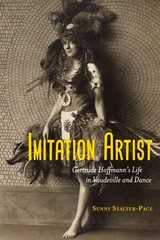 Imitation Artist: Gertrude Hoffmann’s Life in Vaudeville and Dance
Sunny Stalter-Pace
Northwestern University Press, 2020 Gertrude Hoffmann made her name in the early twentieth century as an imitator, copying highbrow performances staged in Europe and popularizing them for a broader American audience. Born in San Francisco, Hoffmann started working as a ballet girl in pantomime spectacles during the Gay Nineties. She performed through the heyday of vaudeville and later taught dancers and choreographed nightclub revues. After her career ended, she reflected on how vaudeville’s history was represented in film and television.
Drawn from extensive archival research, Imitation Artist shows how Hoffmann’s life intersected with those of central figures in twentieth-century popular culture and dance, including Florenz Ziegfeld, George M. Cohan, Isadora Duncan, and Ruth St. Denis. Sunny Stalter-Pace discusses the ways in which Hoffmann navigated the complexities of performing gender, race, and national identity at the dawn of contemporary celebrity culture. This book is essential reading for those interested in the history of theater and dance, modernism, women’s history, and copyright.
 Imitation of Life
Fannie Hurst
Duke University Press, 2004 A bestseller in 1933, and subsequently adapted into two beloved and controversial films, Imitation of Life has played a vital role in ongoing conversations about race, femininity, and the American Dream. Bea Pullman, a white single mother, and her African American maid, Delilah Johnston, also a single mother, rear their daughters together and become business partners. Combining Bea’s business savvy with Delilah’s irresistible southern recipes, they build an Aunt Jemima-like waffle business and an international restaurant empire. Yet their public success brings them little happiness. Bea is torn between her responsibilities as a businesswoman and those of a mother; Delilah is devastated when her light-skinned daughter, Peola, moves away to pass as white. Imitation of Life struck a chord in the 1930s, and it continues to resonate powerfully today. The author of numerous bestselling novels, a masterful short story writer, and an outspoken social activist, Fannie Hurst was a major celebrity in the first half of the twentieth century. Daniel Itzkovitz’s introduction situates Imitation of Life in its literary, biographical, and cultural contexts, addressing such topics as the debates over the novel and films, the role of Hurst’s one-time secretary and great friend Zora Neale Hurston in the novel’s development, and the response to the novel by Hurst’s friend Langston Hughes, whose one-act satire, “Limitations of Life” (which reverses the races of Bea and Delilah), played to a raucous Harlem crowd in the late 1930s. This edition brings a classic of popular American literature back into print.
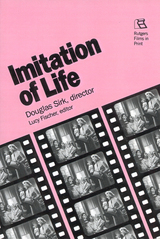 Imitation of Life: Douglas Sirk, Director
Fischer, Lucy
Rutgers University Press, 1991 Douglas Sirk (Claus Detler Sierck) was born in Hamburg, Germany, in 1900. He made nine films before fleeing Nazi Germany, eventually coming to America. His best-known films, made during the 1950s—all of them melodramas—were Magnificent Obsession, All That Heaven Allows, The Tarnished Angels, Written on the Wind, and Imitation of Life (made in 1958, released in 1959). Because of the special stamp he put on his melodramas, Sirk's best works transcend the constraints of their genre. In them, he both exemplified and critiqued postwar, conservative, materialistic life and its false value systems. There is much in Sirk, particularly in Imitation of Life, that is of interest to us today. The time seems to be right for a new look at the film, its reception amidst scandal over the affairs of its star—Lana Turner—the relationships between its mothers and daughters, the tensions between its men and its women, the friendships between its black and white women, and the ambiguous, controversial approach of Sirk to his material. This volume includes the complete continuity script of the film, critical commentary and published reviews, interviews with the director, and a filmography and bibliography. It also includes an excellent introduction by Lucy Fischer.
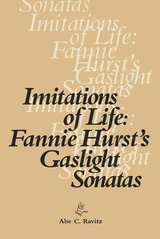 Imitations of Life: Fannie Hurst’s Gaslight Sonatas
Abe C. Ravitz
Southern Illinois University Press, 2009 In the early 1920s, Fannie Hurst’s enormous popularity made her the highest-paid writer in America. She conquered the literary scene at the same time the silent movie industry began to emerge as a tremendously profitable and popular form of entertainment. Abe C. Ravitz parallels Hurst’s growing acclaim with the evolution of silent films, from which she borrowed ideas and techniques that furthered her career. Ravitz notes that Hurst was amazingly adept at anticipating what the public wanted. Sensing that the national interest was shifting from rural to urban subjects, Hurst set her immigrant tales and her "woiking goil" tales in urban America. In her early stories, she tried to bridge the gap between Old World and New World citizens, each somewhat fearful and suspicious of the other. She wrote of love and ethnicity—bringing the Jewish Mother to prominence—of race relations and prejudice, of the woman alone in her quest for selfhood. Ravitz argues, in fact, that her socially oriented tales and her portraits of women in the city clearly identify her as a forerunner of contemporary feminism. Ravitz brings to life the popular culture from 1910 through the 1920s, tracing the meteoric rise of Hurst and depicting the colorful cast of characters surrounding her. He reproduces for the first time the Hurst correspondence with Theodore Dreiser, Charles and Kathleen Norris, and Gertrude Atherton. Fellow writers Rex Beach and Vachel Lindsay also play important roles in Ravitz’s portrait of Hurst, as does Zora Neale Hurston, who awakened Hurst’s interest in the Harlem Renaissance and in race relations, as shown in Hurst’s novel Imitation of Life.
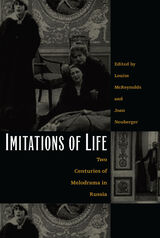 Imitations of Life: Two Centuries of Melodrama in Russia
Louise McReynolds and Joan Neuberger, eds.
Duke University Press, 2002 Imitations of Life views Russian melodrama from the eighteenth century to today as an unexpectedly hospitable forum for considering social issues. The contributors follow the evolution of the genre through a variety of cultural practices and changing political scenarios. They argue that Russian audiences have found a particular type of comfort in this mode of entertainment that invites them to respond emotionally rather than politically to social turmoil. Drawing on a wide variety of sources, including plays, lachrymose novels, popular movies, and even highly publicized funerals and political trials, the essays in Imitations of Life argue that melodrama has consistently offered models of behavior for times of transition, and that contemporary televised versions of melodrama continue to help Russians cope with national events that they understand implicitly but are not yet able to articulate. In contrast to previous studies, this collection argues for a reading that takes into account the subtle but pointed challenges to national politics and to gender and class hierarchies made in melodramatic works from both the nineteenth and twentieth centuries. Collectively, the contributors shift and cross borders, illustrating how the cultural dismissal of melodrama as fundamentally escapist and targeted primarily at the politically disenfranchised has subverted the drama’s own intrinsically subversive virtues. Imitations of Life will interest students and scholars of contemporary Russia, and Russian history, literature, and theater. Contributors. Otto Boele, Julie Buckler, Julie Cassiday, Susan Costanzo, Helena Goscilo, Beth Holmgren, Lars Lih, Louise McReynolds, Joan Neuberger, Alexander Prokhorov, Richard Stites
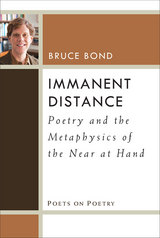 Immanent Distance: Poetry and the Metaphysics of the Near at Hand
Bruce Bond
University of Michigan Press, 2015 In these essays, Bruce Bond interrogates the commonly accepted notion that all poetry since modernism tends toward one of two traditions: that of a more architectural sensibility with its resistance to metaphysics, and that of a latter-day Romantic sensibility, which finds its authority in a metaphysics authenticated by the individual imagination. Poetry, whether self-consciously or not, has always thrived on the paradox of the distant in the immanent and the other in the self; as such, it is driven by both a metaphysical hunger and a resistance to metaphysical certainty. Hidden resources of being animate the language of the near, just as near things beckon from an elusive and inarticulate distance. Bond revalidates the role of poetry and, more broadly, of the poetic imagination as both models for and embodiments of a transfigurative process, an imperfectly mimetic yet ontological engendering of consciousness at the limits of a language that must—if cognizant of its psychological, ethical, and epistemological summons—honor that which lies beyond it.
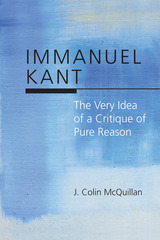 Immanuel Kant: The Very Idea of a Critique of Pure Reason
J. Colin McQuillan
Northwestern University Press, 2016 Immanuel Kant: The Very Idea of a Critique of Pure Reason is a study of the background, development, exposition, and justification of Kant's Critique of Pure Reason. Instead of examining Kant's arguments for the transcendental ideality of space and time, his deduction of the pure concepts of the understanding, or his account of the dialectic of human reason, J. Colin McQuillan focuses on Kant's conception of critique. By surveying the different ways the concept of critique was used during the eighteenth century, the relationship between Kant's critique and his pre-critical experiments with different approaches to metaphysics, the varying definitions of a critique of pure reason Kant offers in the prefaces and introductions to the first Critique, and the way Kant responds to objections, McQuillan is able to highlight an aspect of Kant's critical philosophy that is too often overlooked—the reason that philosophy is critical.
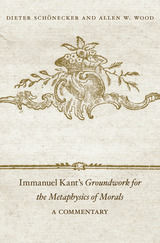 Immanuel Kant’s Groundwork for the Metaphysics of Morals: A Commentary
Dieter Schönecker and Allen W. Wood
Harvard University Press, 2014 A defining work of moral philosophy, Kant’s Groundwork for the Metaphysics of Morals has been influential to an extent far beyond what its modest length (roughly 75 pages) might suggest. It is also a famously difficult work, concerned with propounding universal principles rather than answering practical questions. As even professional philosophers will admit, first-time readers are not alone in finding some of its arguments perplexing.
Offering an introduction that is accessible to students and relevant to specialized scholars, Dieter Schönecker and Allen Wood make luminously clear the ways the Groundwork for the Metaphysics of Morals forms the basis of our modern moral outlook: that all human beings have equal dignity as ends in themselves; that every rational being is a self-governing agent whose morality freely derives from his or her own will; and that all rational beings constitute an ideal community, bound only by the moral laws they have agreed upon. Schönecker and Wood explain key Kantian concepts of duty, the good will, and moral worth, as well as the propositions Kant uses to derive his conception of the moral law. How the law relates to freedom, and the significance of the free will within Kant’s overall philosophy are rigorously interrogated. Where differing interpretations of Kant’s claims are possible, the authors provide alternative options, giving arguments for each. This critical introduction will help readers of the Groundwork gain an informed understanding of Kant’s challenging but central philosophical work.
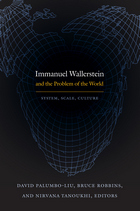 Immanuel Wallerstein and the Problem of the World: System, Scale, Culture
David Palumbo-Liu, Bruce Robbins, and Nirvana Tanoukhi, eds.
Duke University Press, 2011 In this collection of essays, leading cultural theorists consider the meaning and implications of world-scale humanist scholarship by engaging with Immanuel Wallerstein’s world-systems analysis. The renowned sociologist developed his influential critical framework to explain the historical and continuing exploitation of the rest of the world by the West. World-systems analysis reflects Wallerstein’s conviction that understanding global inequality requires thinking on a global scale. Humanists have often criticized his theory as insufficiently attentive to values and objects of knowledge such as culture, agency, difference, subjectivity, and the local. The editors of this collection do not deny the validity of those criticisms; instead, they offer Wallerstein’s world-systems analysis as a well-developed vision of the world scale for humanists to think with and against. Scholars of comparative literature, gender, geography, history, law, race, and sociology consider what thinking on the world scale might mean for particular disciplinary practices, knowledge formations, and objects of study. Several essays offer broader reflections on what is at stake for the study of culture in decisions to adopt or reject world-scale thinking. In a brief essay, Immanuel Wallerstein situates world-systems analysis vis-à-vis the humanities. Contributors. Gopal Balakrishnan, Tani E. Barlow, Neil Brenner, Richard E. Lee, Franco Moretti, David Palumbo-Liu, Bruce Robbins, Helen Stacy, Nirvana Tanoukhi, Immanuel Wallerstein, Kären Wigen
Immaterial Archives: An African Diaspora Poetics of Loss
Jenny Sharpe
Northwestern University Press, 2020 In this innovative study, Jenny Sharpe moves beyond the idea of art and literature as an alternative archive to the historical records of slavery and its aftermath. Immaterial Archives explores instead the intangible phenomena of affects, spirits, and dreams that Caribbean artists and writers introduce into existing archives. Through the works of Frantz Zéphirin, Edouard Duval-Carrié, M. NourbeSe Philip, Erna Brodber, and Kamau Brathwaite, Immaterial Archives examines silences as black female spaces, Afro-Creole sacred worlds as diasporic cartographies, and the imaginative conjoining of spirits with industrial technologies as disruptions of enlightened modernity.
The Immaterial Book: Reading and Romance in Early Modern England
Sarah Wall-Randell
University of Michigan Press, 2013 In romances—Renaissance England’s version of the fantasy novel—characters often discover books that turn out to be magical or prophetic, and to offer insights into their readers’ selves. The Immaterial Book examines scenes of reading in important romance texts across genres: Spenser’s Faerie Queene, Shakespeare’s Cymbeline and The Tempest, Wroth’s Urania, and Cervantes’ Don Quixote. It offers a response to “material book studies” by calling for a new focus on imaginary or “immaterial” books and argues that early modern romance authors, rather than replicating contemporary reading practices within their texts, are reviving ancient and medieval ideas of the book as a conceptual framework, which they use to investigate urgent, new ideas about the self and the self-conscious mind.
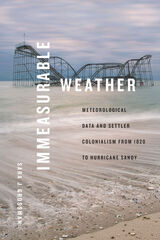 Immeasurable Weather: Meteorological Data and Settler Colonialism from 1820 to Hurricane Sandy
Sara J. Grossman
Duke University Press, 2023 In Immeasurable Weather Sara J. Grossman explores how environmental data collection has been central to the larger project of settler colonialism in the United States. She draws on an extensive archive of historical and meteorological data spanning two centuries to show how American scientific institutions used information about the weather to establish and reinforce the foundations of a white patriarchal settler society. Grossman outlines the relationship between climate data and state power in key moments in the history of American weather science, from the nineteenth-century public data-gathering practices of settler farmers and teachers and the automation of weather data during the Dust Bowl to the role of meteorological satellites in data science’s integration into the militarized state. Throughout, Grossman shows that weather science reproduced the natural world as something to be measured, owned, and exploited. This data gathering, she contends, gave coherence to a national weather project and to a notion of the nation itself, demonstrating that weather science’s impact cannot be reduced to a set of quantifiable phenomena.
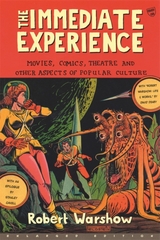 The Immediate Experience: Movies, Comics, Theatre, and Other Aspects of Popular Culture
Robert WarshowWith an introduction by Lionel Trilling and a new preface by Stanley Cavell
Harvard University Press, 2001 This collection of essays, which originally appeared as a book in 1962, is virtually the complete works of an editor of Commentary magazine who died, at age 37, in 1955. Long before the rise of Cultural Studies as an academic pursuit, in the pages of the best literary magazines of the day, Robert Warshow wrote analyses of the folklore of modern life that were as sensitive and penetrating as the writings of James Agee, George Orwell, and Walter Benjamin. Some of these essays--notably "The Westerner," "The Gangster as Tragic Hero," and the pieces on the New Yorker, Mad Magazine, Arthur Miller's The Crucible, and the Rosenberg letters--are classics, once frequently anthologized but now hard to find.
Along with a new preface by Stanley Cavell, The Immediate Experience includes several essays not previously published in the book--on Kafka and Hemingway--as well as Warshow's side of an exchange with Irving Howe.
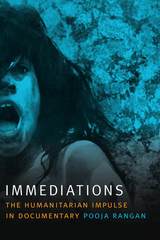 Immediations: The Humanitarian Impulse in Documentary
Pooja Rangan
Duke University Press, 2017 Endangered life is often used to justify humanitarian media intervention, but what if suffering humanity is both the fuel and outcome of such media representations? Pooja Rangan argues that this vicious circle is the result of immediation, a prevailing documentary ethos that seeks to render human suffering urgent and immediate at all costs. Rangan interrogates this ethos in films seeking to “give a voice to the voiceless,” an established method of validating the humanity of marginalized subjects, including children, refugees, autistics, and animals. She focuses on multiple examples of documentary subjects being invited to demonstrate their humanity: photography workshops for the children of sex workers in Calcutta; live eyewitness reporting by Hurricane Katrina survivors; attempts to facilitate speech in nonverbal autistics; and painting lessons for elephants. These subjects are obliged to represent themselves using immediations—tropes that reinforce their status as the “other” and reproduce definitions of the human that exclude non-normative modes of thinking, being, and doing. To counter these effects, Rangan calls for an approach to media that aims not to humanize but to realize the full, radical potential of giving the camera to the other.
 The Immemorial: The Subject and Its Doubles
Andrea Cavalletti
Seagull Books, 2025 A thought-provoking exploration of the fragility of bourgeois identity.
Vienna, 1825. News of a sickly, listless boy is making the rounds. In broad daylight, he falls into deep sleep and his personality changes dramatically. While sleeping, he reads, writes, plays cards, challenges his doctors with amusement, and accomplishes the most astonishing of exercises with his eyes closed. A new subject has appeared, a second “I” has now supplanted the first.
Andrea Cavalletti carefully registers the disquieting appearances of this second “I” in the literature and psychology of the past two centuries. In a context dominated by amnesia and somnambulism, hallucinations and wakeful dreams, the bourgeois subject, whose identity seemed so stable, turns out to be inhabited by masks that elude every grasp, at the mercy of a doubling that can no longer be recomposed. Personalities multiply and do battle, as even life and death exchange roles. And, ultimately, the identity of the Western subject reveals itself as a shade-like, constitutively double figure, that only lives in its weakness and forgetting, in its losses and distractions.
The Immensity of Being Singular: Approaching Migrant Lives in São Paulo through Resonance
Simone Toji
HAU, 2023 In this powerful new work, Simone Toji reconsiders ethnography as a form of appreciation of the contradictions inherent in the making of life itself. Recovering Bronislaw Malinowski’s idea of the “imponderabilia of actual life” as an inspiring ethnographic attitude, she shows how lives are composed through moments of indecision, opacity, and incongruity that make them irreducibly open ended. The singular lives of four migrants, from Paraguay, South Korea, and Bolivia, are rendered as journeys across the city of São Paulo, interspersed with resonant explorations of the power of life’s invention and reinvention as part of the human condition. This important new book is a major contribution to migration studies, social and cultural anthropology, and the social sciences as a whole, and will appeal to readers from the undergraduate level through the doctoral.
 Immersion: A Writer's Guide to Going Deep
Ted Conover
University of Chicago Press, 2016 Over three and a half decades, Ted Conover has ridden the rails with hoboes, crossed the border with Mexican immigrants, guarded prisoners in Sing Sing, and inspected meat for the USDA. His books and articles chronicling these experiences, including the award-winning Newjack: Guarding Sing Sing, have made him one of the premier practitioners of immersion reporting.
In immersion reporting—a literary cousin to ethnography, travel writing, and memoir—the writer fully steps into a new world or culture, participating in its trials, rites, and rituals as a member of the group. The end results of these firsthand experiences are familiar to us from bestsellers such as Nickel and Dimed and Behind the Beautiful Forevers. But in a world of wary strangers, where does one begin?
Conover distills decades of knowledge into an accessible resource aimed at writers of all levels. He covers how to “get into” a community, how to conduct oneself once inside, and how to shape and structure the stories that emerge. Conover is also forthright about the ethics and consequences of immersion reporting, preparing writers for the surprises that often surface when their piece becomes public. Throughout, Conover shares anecdotes from his own experiences as well as from other well-known writers in this genre, including Alex Kotlowitz, Anne Fadiman, and Sebastian Junger. It’s a deep-in-the-trenches book that all aspiring immersion writers should have in hand as they take that first leap into another world.
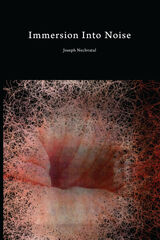 Immersion Into Noise
Joseph Nechvatal
Michigan Publishing, 2011 The noise factor is the ratio of signal to noise of an input signal to that of the output signal. Noise can block or interfere with the meaning of a message in both human and electronic communication. But in Information Theory, noise is still considered to be information.
By refining the definition of noise as that which addresses us outside of our preferred comfort zone, Joseph Nechvatal's Immersion Into Noise investigates multiple aspects of cultural noise by applying the audio understanding of noise to the visual, architectural and cognitive domains. Nechvatal expands and extends our understanding of the function of cultural noise by taking the reader through the immersive and phenomenal aspects of noise into algorithmic and network contexts, beginning with his experience in the Abside of the Grotte de Lascaux.
Immersion Into Noise is intended as a conceptual handbook useful for the development of a personal-political-visionary art of noise. On a planet that is increasingly technologically linked and globally mediated, how might noises break and re-connect in distinctive and productive ways within practices located in the world of art and thought? Joseph Nechvatal explores this intriguing question in Immersion Into Noise.
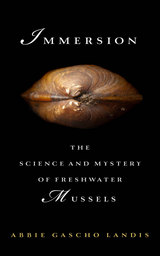 Immersion: The Science and Mystery of Freshwater Mussels
Abbie Gascho Landis
Island Press, 2017 "This is nature writing at its best." —E.O. Wilson
"Eloquent treatise...Landis's book is as much call to action as paean to mesmerizing molluscs." —Nature
"Rich, accurate, and moving." —New Scientist
"A lyrical love letter to the imperiled freshwater mussel." —Science
Abbie Gascho Landis first fell for freshwater mussels while submerged in an Alabama creek, her pregnant belly squeezed into a wetsuit. After an hour of fruitless scanning, a mussel materialized from the rocks—a little spectaclecase, herself pregnant, filtering the river water through a delicate body while her gills bulged with offspring. In that moment of connection, Landis became a mussel groupie, obsessed with learning more about the creatures’ hidden lives. She isn’t the only fanatic; the shy mollusks, so vital to the health of rivers around the world, have a way of inspiring unusual devotion.
In Immersion, Landis brings readers to a hotbed of mussel diversity, the American Southeast, to seek mussels where they eat, procreate, and, too often, perish. Accompanied often by her husband, a mussel scientist, and her young children, she learned to see mussels on the creekbed, to tell a spectaclecase from a pigtoe, and to worry what vanishing mussels—70 percent of North American species are imperiled—will mean for humans and wildlife alike. In Immersion, Landis shares this journey, traveling from perilous river surveys to dry streambeds and into laboratories where endangered mussels are raised one precious life at a time.
Mussels have much to teach us about the health of our watersheds if we step into the creek and take a closer look at their lives. In the tradition of writers like Terry Tempest Williams and Sy Montgomery, Landis gracefully chronicles these untold stories with a veterinarian’s careful eye and the curiosity of a naturalist. In turns joyful and sobering, Immersion is an invitation to see rivers from a mussel’s perspective, a celebration of the wild lives visible to those who learn to search.
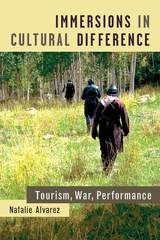 Immersions in Cultural Difference: Tourism, War, Performance
Natalie Alvarez
University of Michigan Press, 2018 In a time of intensifying xenophobia and anti-immigration measures, this book examines the impulse to acquire a deeper understanding of cultural others. Immersions in Cultural Difference takes readers into the heart of immersive simulations, including a simulated terrorist training camp in Utah; mock Afghan villages at military bases in Canada and the UK; a fictional Mexico-US border run in Hidalgo, Mexico; and an immersive tour for settlers at a First Nations reserve in Manitoba, Canada. Natalie Alvarez positions the phenomenon of immersive simulations within intersecting cultural formations: a neoliberal capitalist interest in the so-called “experience economy” that operates alongside histories of colonization and a heightened state of xenophobia produced by War on Terror discourse. The author queries the ethical stakes of these encounters, including her own in relation to the field research she undertakes. As the book moves from site to site, the reader discovers how these immersions function as intercultural rehearsal theaters that serve a diverse set of strategies and pedagogical purposes: they become a “force multiplier” within military strategy, a transgressive form of dark tourism, an activist strategy, and a global, profit-generating practice for a neoliberal capitalist marketplace.
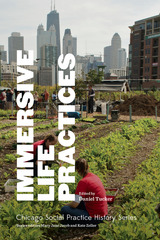 Immersive Life Practices
Edited by Daniel Tucker
School of the Art Institute of Chicago, 2014 Much ink has been spilled on how art intersects with the experiences of everyday life. But what about art grappling with how to live differently? Artists occupy an exceptional space where their livelihood permeates all aspects of life, eroding boundaries between the personal, the professional, and the political. This raises a little-analyzed question: Beyond making a living, how are artists making life?
Immersive Life Practices talks to Chicago-based artists and authors about life as an art practice and art as a life practice. The contributors explore a range of concerns, from how to be holistic, ethical, or practical; to how to balance life and work; to formal questions of how to represent a never-ending project. Some speak fondly of long-term collaborative relationships that sustain their work, while others place emphasis on the physical space in and outside the city as necessary to keep them grounded. Engaging and honest, the essays and interviews in this collection will resonate with anyone working to create a life—and an art—worth living.
Immersive Life Practices is part of the new Chicago Social Practice History series, edited by Mary Jane Jacob and Kate Zeller in the Department of Exhibitions and Exhibition Studies at the School of the Art Institute of Chicago (SAIC).
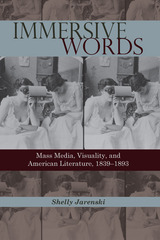 Immersive Words: Mass Media, Visuality, and American Literature, 1839–1893
Shelly Jarenski
University of Alabama Press, 2015 In Immersive Words, Michelle Jarenski demonstrates that the contemporary challenge that visual images and virtual environments in cinema and photography, on the web, and in video games pose to reading and writing are not uniquely contemporary developments but equally exercised the imaginations, anxieties, and works of nineteenth-century authors.
The middle of the nineteenth century witnessed the emergence of numerous visual technologies and techniques: the daguerreotype, immersive exhibition spaces such as cycloramas and panoramas, mechanized tourism, and large-scale exhibitions and spectacles such as the World’s Fair. In closely argued chapters devoted to these four visual forms, Jarenski demonstrates that the popularity of these novelties catalyzed a shift by authors of the period beyond narratives that merely described images to ones that invoked aesthetic experiences.
Jarenski describes how Herman Melville adapts the aesthetic of the daguerreotype through his use of dramatic point-of-view and unexpected shifts that disorient readers. Frederick Douglass is shown to appropriate a panoramic aesthetic that severs spatial and temporal narratives from standard expectations. Jarenski traces how Nathaniel Hawthorne’s The Marble Faun found success as a travel guide to Rome, though intended as a work of serious fiction. Finally, Sarah Orne Jewett is shown to simulate the interactivity of the World Columbian Exposition to promote racialized and gendered forms of aesthetic communication. These techniques and strategies drawn from visual forms blur the just-so boundary critics and theorists have traditionally drawn between text and image.
In the mid-nineteenth century, the national identity of the United States remained fluid and hinged upon matters of gender, sexuality, and, crucially, race. Authors both reflected that evolving identity and contributed to its ongoing evolution. In demonstrating how the aesthetic and visual technologies of the nineteenth century changed the fundamental aesthetics of American literature, the importance of Immersive Words goes far beyond literary criticism.
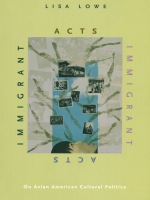 Immigrant Acts: On Asian American Cultural Politics
Lisa Lowe
Duke University Press, 1996 In Immigrant Acts, Lisa Lowe argues that understanding Asian immigration to the United States is fundamental to understanding the racialized economic and political foundations of the nation. Lowe discusses the contradictions whereby Asians have been included in the workplaces and markets of the U.S. nation-state, yet, through exclusion laws and bars from citizenship, have been distanced from the terrain of national culture.
Lowe argues that a national memory haunts the conception of Asian American, persisting beyond the repeal of individual laws and sustained by U.S. wars in Asia, in which the Asian is seen as the perpetual immigrant, as the “foreigner-within.” In Immigrant Acts, she argues that rather than attesting to the absorption of cultural difference into the universality of the national political sphere, the Asian immigrant—at odds with the cultural, racial, and linguistic forms of the nation—displaces the temporality of assimilation. Distance from the American national culture constitutes Asian American culture as an alternative site that produces cultural forms materially and aesthetically in contradiction with the institutions of citizenship and national identity. Rather than a sign of a “failed” integration of Asians into the American cultural sphere, this critique preserves and opens up different possibilities for political practice and coalition across racial and national borders.
In this uniquely interdisciplinary study, Lowe examines the historical, political, cultural, and aesthetic meanings of immigration in relation to Asian Americans. Extending the range of Asian American critique, Immigrant Acts will interest readers concerned with race and ethnicity in the United States, American cultures, immigration, and transnationalism.
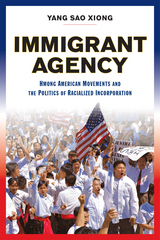 Immigrant Agency: Hmong American Movements and the Politics of Racialized Incorporation
Yang Sao Xiong
Rutgers University Press, 2022 Through a sociological analysis of Hmong former refugees’ grassroots movements in the United States between the 1990s and 2000s, Immigrant Agency shows how Hmong, despite being one of America’s most economically impoverished ethnic groups, were able to make sustained claims on and have their interests represented in public policies. The author, Yang Sao Xiong argues that the key to understanding how immigrants incorporate themselves politically is to understand how they mobilize collective action and make choices in circumstances far from racially neutral. Immigrant groups, in response to political threats or opportunities or both, mobilize collective action and make strategic choices about how to position themselves vis-à-vis other minority groups, how to construct group identities, and how to deploy various tactics in order to engage with the U.S. political system and influence policy. In response to immigrants’ collective claims, the racial state engages in racialization which undermines immigrants’ political standing and perpetuates their marginalization.
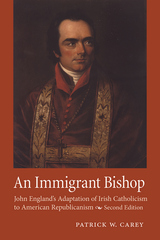 An Immigrant Bishop: John England's Adaptation of Irish Catholicism to American Republicanism, Second Edition
Patrick W. Carey
Catholic University of America Press, 2022 An Immigrant Bishop is a revised examination of the Irish intellectual roots of Bishop John England’s American pastoral works in the diocese of Charleston, South Carolina (1820-1842). The text focuses on his political philosophy and his theology of the Church, both of which were influenced by the Enlightenment and a theological, not a political, Gallicanism. As the study demonstrates, we now know more about England’s intellectual life prior to his immigration than we do about any other Catholic immigrant from Ireland. Neither Peter Guilday’s monumental two-volume biography (1927) of England nor any subsequent scholarly study of England has uncovered and analyzed, as this book does, England’s many unpublished and published writings in Ireland—his explicitly authored texts, his published speeches before the Cork Aggregate meetings, and his pseudonymous articles in the Cork Mercantile Chronicle between 1808, when he was ordained, and 1820, when he emigrated to the United States.
John England (1786-1842), the first Catholic bishop of Charleston, was the foremost national spokesman for Catholicism in the United States during the years of his episcopacy and the primary apologist for the compatibility of Catholicism and American republicanism. He was also the first Catholic bishop to speak before the United States Congress and the first American to receive a papal appointment as an Apostolic Delegate to a foreign country (in this case to negotiate a concordat with President Jean Pierre Boyer of Haiti). He is considered the father of the Baltimore Provincial Councils and the nineteenth-century American Catholic conciliar tradition. He was also the only bishop in American history to develop a constitutional form of diocesan government and administration. Among other things he was the first cleric to establish a diocesan newspaper that had something of a national distribution. England’s contribution to the early formation of an American Catholicism has been told many times before, but he has the kind of creative mind and episcopal leadership that demands repeated re-considerations.
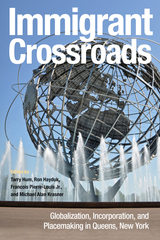 Immigrant Crossroads: Globalization, Incorporation, and Placemaking in Queens, New York
Edited by Tarry Hum, Ron Hayduk, Francois Pierre-Louis Jr., and Michael Alan Krasner
Temple University Press, 2021 Nearly half the 2.3 million residents of Queens, New York are foreign-born. Immigrants in Queens hail from more than 120 countries and speak more than 135 languages. As an epicenter of immigrant diversity, Queens is an urban gateway that exemplifies opportunities and challenges in shaping a multi-racial democracy. The editors and contributors to Immigrant Crossroads examine the social, spatial, economic, and political dynamics that stem from this fast-growing urbanization. The interdisciplinary chapters examine residential patterns and neighborhood identities, immigrant incorporation and mobilizations, and community building and activism. Essays combine qualitative and quantitative research methods to address globalization and the unprecedented racial and ethnic diversity as a result of international migration. Chapters on incorporation focus on immigrant participation and representation in electoral politics, and advocacy for immigrant inclusion in urban governance and service provision. A section of Immigrant Crossroads concerns placemaking, focusing on the production of neighborhood spaces and identities as well as immigrant activism and community development and control. Based on engaged and robust analysis, Immigrant Crossroads highlights the dynamics of this urban gateway.
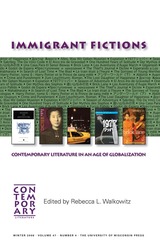 Immigrant Fictions: Contemporary Literature in an Age of Globalization
Rebecca L. Walkowitz
University of Wisconsin Press, 2007 Immigrant Fictions is a groundbreaking collection that brings together studies of world literature, book history, narrative theory, and the contemporary novel to challenge methods of critical reading based on national models of literary culture. Contributors suggest that contemporary novels by immigrant writers need to be read across several geographies of production, circulation, and translation. Analyzing work by David Peace, George Lamming, Caryl Phillips, Iva Pekarkova, Yan Geling, Theresa Hak Kyung Cha, Anchee Min, and Monica Ali, these essays take up a range of critical topics, including the transnational book and the migrant writer, the comparative reception history of postcolonial fiction, transnational criticism and Asian-American literature in the U. S., mobility and feminism in translation, linguistic mediation and immigrating fictions, migration and the politics of narrative form.
Immigrant Identity and the Politics of Citizenship: A Collection of Articles from the Journal of American Ethnic History
John J Bukowczyk
University of Illinois Press, 2016 The next volume in the Common Threads book series, Immigrant Identity and the Politics of Citizenship assembles fourteen articles from the Journal of American Ethnic History . The chapters discuss the divisions and hierarchies confronted by immigrants to the United States, and how these immigrants shape, and are shaped by, the social and cultural worlds they enter. Drawing on scholarship of ethnic groups from around the globe, the articles illuminate the often fraught journey many migrants undertake from mistrusted Other to sometimes welcomed citizen. Contributors: James R. Barrett, Douglas C. Baynton, Vibha Bhalla, Julio Capó, Jr., Robert Fleegler, Gunlög Fur, Hidetaka Hirota, Karen Leonard, Willow Lung-Amam, Raymond A. Mohl, Mark Overmyer-Velázquez, Lara Putnam, David Reimers, David Roediger, and Allison Varzally.
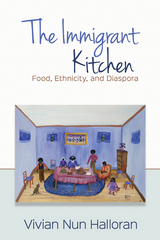 The Immigrant Kitchen: Food, Ethnicity, and Diaspora
Vivian Nun Halloran
Ohio State University Press, 2016 In The Immigrant Kitchen: Food, Ethnicity, and Diaspora, Vivian Nun Halloran examines food memoirs by immigrants and their descendants and reveals how their treatment of food deeply embeds concerns about immigrant identity in the United States. Halloran argues that by offering a glimpse into the authors’ domestic lives through discussions of homemade food, these memoirs demystify the processes of immigration, assimilation, acculturation, and expatriation—ultimately examining what it means to live as naturalized citizens of the United States. Having grown up hearing about their parents’ often fraught experiences of immigration, these authors examine the emotional toll these stories took and how such stories continue to affect their view of themselves as Americans. Halloran covers a wide swathe of immigrant food memoirs, moving seamlessly between works by authors such as Austin Clarke, Madhur Jaffrey, Kim Sunée, Diana Abu-Jaber, Eduardo Machado, Colette Rossant, Maya Angelou, and Jonathan Safran Foer.
The Immigrant Kitchen describes how these memoirs function as a complex and engaging mass media genre that caters to multiple reading constituencies. Specifically, they entertain readers with personal anecdotes and recollections, teach new culinary skills through recipes, share insight into different cultural mores through ethnographic and reportorial discussions of life in other countries, and attest to the impact that an individual’s legal immigration into the United States continues to have down through the generations of his or her American-born families.
 Immigrant Minds, American Identities: Making the United States Home, 1870-1930
Orm Overland
University of Illinois Press, 2000 Focusing on a period of American history marked by a sharp division between Anglo-Americans ("Americans") and non-Anglo European immigrants ("foreigners"), Orm Øverland examines the creation and dissemination of "homemaking myths": stories that weave immigrants into the basic fabric of America by linking them to the pivotal events and ideas of their new homeland.
Devised by middle-class ethnic leaders and spread through ethnic media, banquets, and rallies, homemaking myths uncovered a role for immigrants in the nation's founding, a place of honor in the nation's wars, and traces of American democratic political ideology in the immigrants' ethnic past. These stories proclaim that immigrants, in the person of their ancestors, disembarked from Christopher Columbus's ships, fought for victory over the Axis, and brought American values of freedom and democracy from their native lands. By virtue of their ethnic group's contributions, these myths maintain, non-Anglo European immigrants came to America not as foreigners but as ready-made ideal citizens of the Republic.
Øverland shows that the plots and themes of homemaking myths share so many characteristics that they must be considered an American phenomenon rather than one peculiar to an individual ethnic group. As a symbol of the immigrant's insider status, these stories have played a crucial role in forming American ethnic identities and in carving out a place for immigrants in an Anglo-dominated society.
Immigrant Model
Mihaela Moscaliuc
University of Pittsburgh Press, 2015 The poems in Immigrant Model explore issues of individual and communal identity in the face of conflict, conflicting "truths" or histories, and uprootedness. They explore the notion of homeland as it relates to one's roots, adopted space, psychological terrain, gendered body. If the book reads as a collage of voices or shards rather than as a book with an identifiable arc, it's because that's the only way the poet has managed to answer, so far, the question, "What is it like to be of this world and this world and this world, while also of the elsewhere skirting these worlds?"
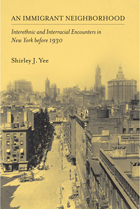 An Immigrant Neighborhood: Interethnic and Interracial Encounters in New York before 1930
Shirley Yee
Temple University Press, 2011 Examining race and ethnic relations through an intersectional lens, Shirley Yee's An Immigrant Neighborhoodinvestigates the ways that race, class, and gender together shaped concepts of integration and assimilation as well as whiteness and citizenship in lower Manhattan during the late nineteenth and early twentieth-centuries. In contrast to accounts of insulated neighborhoods and ethnic enclaves, Yee unearths the story of working class urban dwellers of various ethnic groups—Chinese, Jews, Italians, and Irish—routinely interacting in social and economic settings. Yee's numerous, fascinating anecdotes—such as one about an Irishman who served as the only funeral director for Chinese for many years—recount the lived experiences of these neighborhoods, detailing friendships, business relationships, and sexual relationships that vividly counter the prevailing idea that different ethnic groups did not mix except in ways marked by violence and hostility.
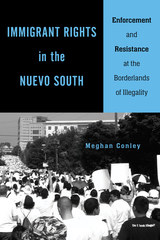 Immigrant Rights in the Nuevo South: Enforcement and Resistance at the Borderlands of Illegality
Meghan Conley
Temple University Press, 2020 Every day, undocumented immigrants are rendered vulnerable through policies and practices that illegalize them. Moreover, they are socially constructed into dangerous criminals and taxpayer burdens who are undeserving of rights, dignity, and respect. Meghan Conley’s timely book, Immigrant Rights in the Nuevo South, seeks to expose and challenge these dehumanizing ideas and practices byexamining the connections between repression and resistance for unauthorized immigrants in communities across the American Southeast. Conley uses on-the-ground interviews to describe fear and resistance from the perspective of those most affected by it. She shows how, for example, the Illegal Immigration Reform and Enforcement Act in Georgia prompted marches and an action that became “a day of non-compliance.” Likewise, an “enforcement lottery” that created unpredictable threats of arrest and deportation in the region mobilized immigrants to organize and demonstrate. However, as immigrant rights activists mobilize in opposition to the criminalization of undocumented people, they may unintentionally embrace stories of who deserves to be in the United States and who does not. Immigrant Rights in the Nuevo South explores these paradoxes while offering keen observations about the nature and power of Latinx resistance.
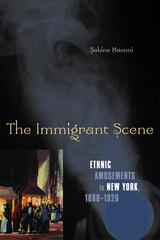 The Immigrant Scene: Ethnic Amusements in New York, 1880–1920
Sabine Haenni
University of Minnesota Press, 2008 Explores the relationship between immigrant and national culture Yiddish melodramas about the tribulations of immigration. German plays about alpine tourism. Italian vaudeville performances. Rubbernecking tours of Chinatown. In the New York City of the late nineteenth and early twentieth centuries, these seemingly disparate leisure activities played similar roles: mediating the vast cultural, demographic, and social changes that were sweeping the nation’s largest city. In The Immigrant Scene, Sabine Haenni reveals how theaters in New York created ethnic entertainment that shaped the culture of the United States in the early twentieth century. Considering the relationship between leisure and mass culture, The Immigrant Scene develops a new picture of the metropolis in which the movement of people, objects, and images on-screen and in the street helped residents negotiate the complexities of modern times. In analyzing how communities engaged with immigrant theaters and the nascent film culture in New York City, Haenni traces the ways in which performance and cinema provided virtual mobility—ways of navigating the socially complex metropolis—and influenced national ideas of immigration, culture, and diversity in surprising and lasting ways.
 The Immigrant Threat: The Integration of Old and New Migrants in Western Europe since 1850
Leo Lucassen
University of Illinois Press, 2005 Starting in the 1980s, anti-immigrant discourse shifted away from the "color" of immigrants to their religion and culture. It focused in particular on newcomers from Muslim countries—people feared both as terrorists and as products of tribal societies with values opposed to those of secular Western Europe. Leo Lucassen tackles the question of whether the integration process of these recent immigrants will fundamentally differ in the long run (over multiple generations) from the experiences of similar immigrant groups in the past. For comparison, Lucassen focuses on "large and problematic groups" from Western Europe's past (the Irish in the United Kingdom, the Poles in Germany, and the Italians in France) and demonstrates a number of structural similarities in the way migrants and their descendants integrated into these nation states. Lucassen emphasizes that the geographic sources of the "threat" have changed and that contemporaries tend to overemphasize the threat of each successive wave of immigrants, in part because the successfully incorporated immigrants of the past have become invisible in national histories.
Immigrant Voices: New Lives in America, 1773-2000
Edited by Thomas Dublin
University of Illinois Press, 2014 A classroom staple, Immigrant Voices: New Lives in America, 1773-2000 has been updated with writings that reflect trends in immigration to the United States through the turn of the twenty-first century. New chapters include a selection of letters from Irish immigrants fleeing the famine of the 1840s, writings from an immigrant who escaped the civil war in Liberia during the 1980s, and letters that crossed the U.S.-Mexico border during the late 1980s and early '90s. With each addition editor Thomas Dublin has kept to his original goals, which was to show the commonalities of the U.S. immigrant experience across lines of gender, nation of origin, race, and even time.
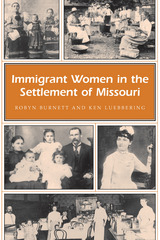 Immigrant Women in the Settlement of Missouri
Robyn Burnett & Ken Luebbering
University of Missouri Press, 2005 Robyn Burnett and Ken Luebbering first looked at how immigration has affected Missouri’s cultural landscape in their popular book German Settlement in Missouri: New Land, Old Ways. Now they tell the stories of women from all across Europe who left the Old World for Missouri. Drawing heavily on the women’s own stories, Immigrant Women in the Settlement of Missouri illustrates common elements of their lives without minimizing the diversity and complexity of each individual’s experience.
The book begins with descriptions culled from diaries, letters, and memoirs documenting preparations for the journey, the perilous Atlantic crossing, and the sometimes equally long and arduous trip from the port of entry to Missouri. Burnett and Luebbering go on to examine how women, once in Missouri, coped with the problems of daily life in an unfamiliar and occasionally hostile environment. Whether it was the hardships of the frontier, the harsh realities of urban life, childbirth, the deaths of family members, isolation, or prejudice, their new lives brought numerous challenges. Many found success and contentment, as well, and the book also documents their joys and triumphs: physical survival, economic prosperity, thriving families, friendships, and community celebrations.
Because it examines the lives of women from many social classes and ethnic backgrounds, Immigrant Women in the Settlement of Missouri does much to explain the rich cultural diversity Missouri enjoys today. The photographs and narratives relating to Czech, French, German, Hungarian, Irish, Italian, and Polish life will remind descendants of immigrants that many customs and traditions they grew up practicing have roots in their home countries and will also promote understanding of the customs of other cultures. In addition to the ethnic and class differences that affected these women’s lives, the book also notes the impact of the various eras in which they lived, their education, the circumstances of their migrations, and their destinations across Missouri.
With their engaging and straightforward narrative, Burnett and Luebbering take the reader chronologically through the history of the state from the colonial period to the Civil War and industrialization. Like all Missouri Heritage Readers, this one is presented in an accessible format with abundant illustrations, and it is sure to please both general readers and those engaged in immigrant and women’s studies.
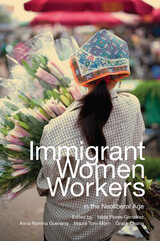 Immigrant Women Workers in the Neoliberal Age
Edited by Nilda Flores-Gonzalez, Anna Romina Guevarra, Maura Toro-Morn, and Grace Chang
University of Illinois Press, 2013 To date, most research on immigrant women and labor forces has focused on the participation of immigrant women on formal labor markets. In this study, contributors focus on informal economies such as health care, domestic work, street vending, and the garment industry, where displaced and undocumented women are more likely to work. Because such informal labor markets are unregulated, many of these workers face abusive working conditions that are not reported for fear of job loss or deportation. In examining the complex dynamics of how immigrant women navigate political and economic uncertainties, this collection highlights the important role of citizenship status in defining immigrant women's opportunities, wages, and labor conditions. Contributors are Pallavi Banerjee, Grace Chang, Margaret M. Chin, Jennifer Jihye Chun, Héctor R. Cordero-Guzmán, Emir Estrada, Lucy Fisher, Nilda Flores-González, Ruth Gomberg-Munoz, Anna Romina Guevarra, Shobha Hamal Gurung, Pierrette Hondagneu-Sotelo, María de la Luz Ibarra, Miliann Kang, George Lipsitz, Lolita Andrada Lledo, Lorena Muñoz, Bandana Purkayastha, Mary Romero, Young Shin, Michelle Téllez, and Maura Toro-Morn.
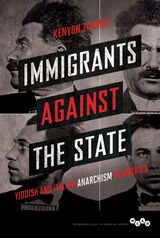 Immigrants against the State: Yiddish and Italian Anarchism in America
Kenyon Zimmer
University of Illinois Press, 2015 From the 1880s through the 1940s, tens of thousands of first- and second-generation immigrants embraced the anarchist cause after arriving on American shores. Kenyon Zimmer explores why these migrants turned to anarchism, and how their adoption of its ideology shaped their identities, experiences, and actions.
Zimmer focuses on Italians and Eastern European Jews in San Francisco, New York City, and Paterson, New Jersey. Tracing the movement's changing fortunes from the pre–World War I era through the Spanish Civil War, Zimmer argues that anarchists, opposed to both American and Old World nationalism, severed all attachments to their nations of origin but also resisted assimilation into their host society. Their radical cosmopolitan outlook and identity instead embraced diversity and extended solidarity across national, ethnic, and racial divides. Though ultimately unable to withstand the onslaught of Americanism and other nationalisms, the anarchist movement nonetheless provided a shining example of a transnational collective identity delinked from the nation-state and racial hierarchies.
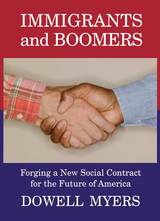 Immigrants and Boomers: Forging a New Social Contract for the Future of America
Dowell Myers
Russell Sage Foundation, 2007 "This story of hope for both immigrants and native-born Americans is a well-researched, insightful, and illuminating study that provides compelling evidence to support a policy of homegrown human investment as a new priority. A timely, valuable addition to demographic and immigration studies. Highly recommended." —Choice Virtually unnoticed in the contentious national debate over immigration is the significant demographic change about to occur as the first wave of the Baby Boom generation retires, slowly draining the workforce and straining the federal budget to the breaking point. In this forward-looking new book, noted demographer Dowell Myers proposes a new way of thinking about the influx of immigrants and the impending retirement of the Baby Boomers. Myers argues that each of these two powerful demographic shifts may hold the keys to resolving the problems presented by the other. Immigrants and Boomers looks to California as a bellwether state—where whites are no longer a majority of the population and represent just a third of residents under age twenty—to afford us a glimpse into the future impact of immigration on the rest of the nation. Myers opens with an examination of the roots of voter resistance to providing social services for immigrants. Drawing on detailed census data, Myers demonstrates that long-established immigrants have been far more successful than the public believes. Among the Latinos who make up the bulk of California's immigrant population, those who have lived in California for over a decade show high levels of social mobility and use of English, and 50 percent of Latino immigrants become homeowners after twenty years. The impressive progress made by immigrant families suggests they have the potential to pick up the slack from aging boomers over the next two decades. The mass retirement of the boomers will leave critical shortages in the educated workforce, while shrinking ranks of middle-class tax payers and driving up entitlement expenditures. In addition, as retirees sell off their housing assets, the prospect of a generational collapse in housing prices looms. Myers suggests that it is in the boomers' best interest to invest in the education and integration of immigrants and their children today in order to bolster the ranks of workers, taxpayers, and homeowners America they will depend on ten and twenty years from now. In this compelling, optimistic book, Myers calls for a new social contract between the older and younger generations, based on their mutual interests and the moral responsibility of each generation to provide for children and the elderly. Combining a rich scholarly perspective with keen insight into contemporary political dilemmas, Immigrants and Boomers creates a new framework for understanding the demographic challenges facing America and forging a national consensus to address them.
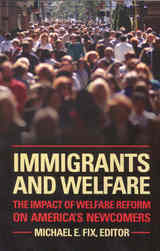 Immigrants and Welfare: The Impact of Welfare Reform on America's Newcomers
Michael E. Fix
Russell Sage Foundation, 2009 The lore of the immigrant who comes to the United States to take advantage of our welfare system has a long history in America's collective mythology, but it has little basis in fact. The so-called problem of immigrants on the dole was nonetheless a major concern of the 1996 welfare reform law, the impact of which is still playing out today. While legal immigrants continue to pay taxes and are eligible for the draft, welfare reform has severely limited their access to government supports in times of crisis. Edited by Michael Fix, Immigrants and Welfare rigorously assesses the welfare reform law, questions whether its immigrant provisions were ever really necessary, and examines its impact on legal immigrants' ability to integrate into American society. Immigrants and Welfare draws on fields from demography and law to developmental psychology. The first part of the volume probes the politics behind the welfare reform law, its legal underpinnings, and what it may mean for integration policy. Contributor Ron Haskins makes a case for welfare reform's ultimate success but cautions that excluding noncitizen children (future workers) from benefits today will inevitably have serious repercussions for the American economy down the road. Michael Wishnie describes the implications of the law for equal protection of immigrants under the U.S. Constitution. The second part of the book focuses on empirical research regarding immigrants' propensity to use benefits before the law passed, and immigrants' use and hardship levels afterwards. Jennifer Van Hook and Frank Bean analyze immigrants' benefit use before the law was passed in order to address the contested sociological theories that immigrants are inclined to welfare use and that it slows their assimilation. Randy Capps, Michael Fix, and Everett Henderson track trends before and after welfare reform in legal immigrants' use of the major federal benefit programs affected by the law. Leighton Ku looks specifically at trends in food stamps and Medicaid use among noncitizen children and adults and documents the declining health insurance coverage of noncitizen parents and children. Finally, Ariel Kalil and Danielle Crosby use longitudinal data from Chicago to examine the health of children in immigrant families that left welfare. Even though few states took the federal government's invitation with the 1996 welfare reform law to completely freeze legal immigrants out of the social safety net, many of the law's most far-reaching provisions remain in place and have significant implications for immigrants. Immigrants and Welfare takes a balanced look at the politics and history of immigrant access to safety-net supports and the ongoing impacts of welfare. Copublished with the Migration Policy Institute
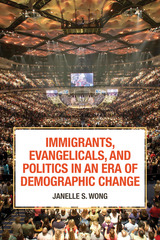 Immigrants, Evangelicals, and Politics in an Era of Demographic Change
Janelle S. Wong
Russell Sage Foundation, 2018 As immigration from Asia and Latin America reshapes the demographic composition of the U.S., some analysts have anticipated the decline of conservative white evangelicals’ influence in politics. Yet, Donald Trump captured a larger share of the white evangelical vote in the 2016 election than any candidate in the previous four presidential elections. Why has the political clout of white evangelicals persisted at a time of increased racial and ethnic diversity? In Immigrants, Evangelicals, and Politics in an Era of Demographic Change, political scientist Janelle Wong examines a new generation of Asian American and Latino evangelicals and offers an account of why demographic change has not contributed to a political realignment.
Asian Americans and Latinos currently constitute 13 percent of evangelicals, and their churches are among the largest, fastest growing organizations in their communities. While evangelical identity is associated with conservative politics, Wong draws from national surveys and interviews to show that non-white evangelicals express political attitudes that are significantly less conservative than those of their white counterparts. Black, Asian American, and Latino evangelicals are much more likely to support policies such as expanded immigration rights, increased taxation of the wealthy, and government interventions to slow climate change. As Wong argues, non-white evangelicals’ experiences as members of racial or ethnic minority groups often lead them to adopt more progressive political views compared to their white counterparts.
However, despite their growth in numbers, non-white evangelicals—particularly Asian Americans and Latinos—are concentrated outside of swing states, have lower levels of political participation than white evangelicals, and are less likely to be targeted by political campaigns. As a result, white evangelicals dominate the evangelical policy agenda and are overrepresented at the polls. Also, many white evangelicals have adopted even more conservative political views in response to rapid demographic change, perceiving, for example, that discrimination against Christians now rivals discrimination against racial and ethnic minorities.
Wong demonstrates that immigrant evangelicals are neither “natural” Republicans nor “natural” Democrats. By examining the changing demographics of the evangelical movement, Immigrants, Evangelicals, and Politics in an Era of Demographic Change sheds light on an understudied constituency that has yet to find its political home.
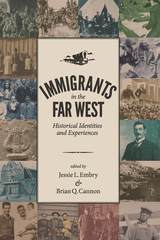 Immigrants in the Far West: Historical Identities and Experiences
Jessie L. Embry
University of Utah Press, 2014 This book is a collection of essays showcasing cutting-edge research and innovative approaches that a new generation of scholars is bringing to the study of immigration in the American West. Often overlooked in general studies of immigration, the western United States has been and is an important destination for immigrants. The unique combination of ethnicities and races in the West, combined with political and economic peculiarities, has given the region an immigration narrative that departs significantly from that of the East and Midwest. This volume explores facets of this narrative with case studies that reveal how immigration in the American West has influenced the region’s development culturally, economically, socially, and politically. Contributors offer historical narrative and theory to illuminate factors that have galvanized immigration and the ways that agency, cultural resources, institutions, and societal attitudes have shaped immigrant experiences. With chapters written by scholars from multiple fields, the book’s interdisciplinary framework will make it of interest to readers from a variety of backgrounds.
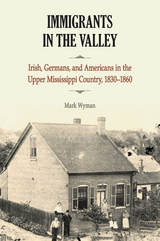 Immigrants in the Valley: Irish, Germans, and Americans in the Upper Mississippi Country, 1830-1860
Mark Wyman
Southern Illinois University Press, 1984 Thousands of newcomers flocked into the Upper Mississippi country in the decades leading up to the Civil War. Illinois, Wisconsin, Iowa, Missouri, and Minnesota received immigrants from most areas of Europe, as well as Americans from the Upper South, New England, and the Middle Atlantic states. They all carried with them religious beliefs, experiences, and expectations that differed widely, attitudes and opinions which often threw them into conflict with each other. Drawing extensively on family letters sent home to Europe, missionary reports, employment records, and other diverse materials from 1830 to 1860, Wyman shows the interplay between the major groups traveling the roads and waterways of the Upper Mississippi Valley during those crucial decades. The result is a lively, richly illustrated account that will help Americans everywhere better understand their diverse heritage and the environment in which their family trees took root. A new preface to this paperback edition helps to bring the scholarship up to date.
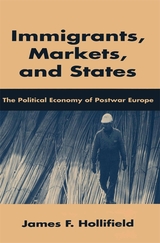 Immigrants, Markets, and States: The Political Economy of Postwar Europe
James F. Hollifield
Harvard University Press, 1992 This timely study of the recent migration tides explores the political and economic factors that have influenced the rise of immigration in postwar Europe and the United States. It seeks to explain immigration in terms of the globalization of labor markets and the expansion of civil rights for marginal groups in the liberal democracies.
Immigration raises emotional issues of nationalism and citizenship. Territorial norms of community and nationhood come into conflict with the liberal ideal of free, rational individuals seeking a better life for themselves and their families. Yet immigration has been an essential ingredient in economic growth. How then can liberal states reconcile economic pressures to maintain adequate supplies of labor with political pressures to protect citizenship and safeguard rights that are accorded, in principle, to every member of society?
Three prominent democracies—France, Germany, and the United States—are chosen for study because their experience illustrates the dilemma that liberal states must face when trying to control immigration. The author carefully distinguishes differences in the factors that influence each state’s struggle to resolve the status of the “guest” worker and the “illegal” immigrant. Yet he finds that the accretion of rights for aliens and the globalization of markets have led to a convergence of immigration policies in the industrialized West.
 Immigrants Raising Citizens: Undocumented Parents and Their Children
Hirokazu Yoshikawa
Russell Sage Foundation, 2011 An in-depth look at the challenges undocumented immigrants face as they raise children in the U.S. There are now nearly four million children born in the United States who have undocumented immigrant parents. In the current debates around immigration reform, policymakers often view immigrants as an economic or labor market problem to be solved, but the issue has a very real human dimension. Immigrant parents without legal status are raising their citizen children under stressful work and financial conditions, with the constant threat of discovery and deportation that may narrow social contacts and limit participation in public programs that might benefit their children. Immigrants Raising Citizens offers a compelling description of the everyday experiences of these parents, their very young children, and the consequences these experiences have on their children's development. Immigrants Raising Citizens challenges conventional wisdom about undocumented immigrants, viewing them not as lawbreakers or victims, but as the parents of citizens whose adult productivity will be essential to the nation's future. The book's findings are based on data from a three-year study of 380 infants from Dominican, Mexican, Chinese, and African American families, which included in-depth interviews, in-home child assessments, and parent surveys. The book shows that undocumented parents share three sets of experiences that distinguish them from legal-status parents and may adversely influence their children's development: avoidance of programs and authorities, isolated social networks, and poor work conditions. Fearing deportation, undocumented parents often avoid accessing valuable resources that could help their children's development—such as access to public programs and agencies providing child care and food subsidies. At the same time, many of these parents are forced to interact with illegal entities such as smugglers or loan sharks out of financial necessity. Undocumented immigrants also tend to have fewer reliable social ties to assist with child care or share information on child-rearing. Compared to legal-status parents, undocumented parents experience significantly more exploitive work conditions, including long hours, inadequate pay and raises, few job benefits, and limited autonomy in job duties. These conditions can result in ongoing parental stress, economic hardship, and avoidance of center-based child care—which is directly correlated with early skill development in children. The result is poorly developed cognitive skills, recognizable in children as young as two years old, which can negatively impact their future school performance and, eventually, their job prospects. Immigrants Raising Citizens has important implications for immigration policy, labor law enforcement, and the structure of community services for immigrant families. In addition to low income and educational levels, undocumented parents experience hardships due to their status that have potentially lifelong consequences for their children. With nothing less than the future contributions of these children at stake, the book presents a rigorous and sobering argument that the price for ignoring this reality may be too high to pay.
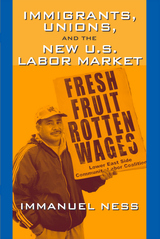 Immigrants Unions & The New Us Labor Mkt
Immanuel Ness
Temple University Press, 2005 In recent years, New Yorkers have been surprised to see workers they had taken for granted—Mexicans in greengroceries, West African supermarket deliverymen and South Asian limousine drivers—striking, picketing, and seeking support for better working conditions. Suddenly, businesses in New York and the nation had changed and were now dependent upon low-paid immigrants to fill the entry-level jobs that few native-born Americans would take. Immigrants, Unions, and the New U.S. Labor Market tells the story of these workers' struggle for living wages, humane working conditions, and the respect due to all people. It describes how they found the courage to organize labor actions at a time when most laborers have become quiescent and while most labor unions were ignoring them. Showing how unions can learn from the example of these laborers, and demonstrating the importance of solidarity beyond the workplace, Immanuel Ness offers a telling look into the lives of some of America's newest immigrants.
 Immigration
Richard A. Easterlin, Richard A. Easterlin, David Ward, William S. Bernard, and Reed Ueda
Harvard University Press, 1982 The monumental Harvard Encyclopedia of American Ethnic Groups is the most authoritative single source available on the history, culture, and distinctive characteristics of ethnic groups in the United States. The Dimensions of Ethnicity series is designed to make this landmark scholarship available to everyone in a series of handy paperbound student editions. Selections in this series will include outstanding articles that illuminate the social dynamics of a pluralistic nation or masterfully summarize the experience of key groups. Written by the best-qualified scholars in each field, Dimensions of Ethnicity titles will reflect the complex interplay between assimilation and pluralism that is a central theme of the American experience.
This concise volume recounts the social and economic characteristics of successive waves of immigrants, where they settled, and how they achieved citizenship.
 Immigration and American History: Essays in Honor of Theodore C. Blegen
Henry Steele Commager, Editor
University of Minnesota Press, 1961
Immigration and American History was first published in 1961. Minnesota Archive Editions uses digital technology to make long-unavailable books once again accessible, and are published unaltered from the original University of Minnesota Press editions.
Ten scholars noted for their studies in immigration history contribute essays to this volume. Dr. Commager surveys the course of immigration studies over the years. Oscar Handlin reappraises the role of immigration in American life. Ingrid Semmingsen, Norwegian historian, writes on the image of American in Europe. Philip D. Jordan focuses on the immigrant's view of America. John T. Flanagan discusses the immigrant in fiction. Carlton C. Qualey contributes two essays. In the first he surveys world population movements and in the second he suggests new source materials for immigration studies. Henry A. Pochmann discusses the migration of ideas—what ideas have come into America, from where, and to what end? Franklin D. Scott inquires into the value of immigration studies of nationality groups. The Reverend Colman J. Barry explores possibilities for future immigration studies. Theodore C. Blegen takes a backward glance and a forward look at immigration studies.
The volume is based on the papers given at a conference held at the University of Minnesota in honor of Dr. Blegen on his retirement from the university.
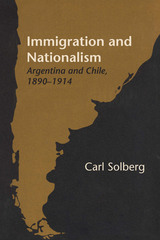 Immigration and Nationalism: Argentina and Chile, 1890–1914
By Carl Solberg
University of Texas Press, 1970 “Dirtier than the dogs of Constantinople.” “Waves of human scum thrown upon our beaches by other countries.” Such was the vitriolic abuse directed against immigrant groups in Chile and Argentina early in the twentieth century. Yet only twenty-five years earlier, immigrants had encountered a warm welcome. This dramatic change in attitudes during the quarter century preceding World War I is the subject of Carl Solberg’s study. He examines in detail the responses of native-born writers and politicians to immigration, pointing out both the similarities and the significant differences between the situations in Argentina and Chile. As attitudes toward immigration became increasingly nationalistic, the European was no longer pictured as a thrifty, industrious farmer or as an intellectual of superior taste and learning. Instead, the newcomer commonly was regarded as a subversive element, out to destroy traditional creole social and cultural values. Cultural phenomena as diverse as the emergence of the tango and the supposed corruption of the Spanish language were attributed to the demoralizing effects of immigration. Drawing his material primarily from writers of the pre–World War I period, Solberg documents the rise of certain forms of nationalism in Argentina and Chile by examining the contemporary press, journals, literature, and drama. The conclusions that emerge from this study also have obvious application to the situation in other countries struggling with the problems of assimilating minority groups.
 Immigration and Opportuntity: Race, Ethnicity, and Employment in the United States
Frank D. Bean
Russell Sage Foundation, 1999 The American dream of equal opportunity and social mobility still holds a powerful appeal for the many immigrants who arrive in this country each year. but if immigrant success stories symbolize the fulfillment of the American dream, the persistent inequality suffered by native-born African Americans demonstrates the dream's limits. Although the experience of blacks and immigrants in the United States are not directly comparable, their fates are connected in ways that are seldom recognized. Immigration and Opportunity brings together leading sociologists and demographers to present a systematic account of the many ways in which immigration affects the labor market experiences of native-born African Americans. With the arrival of large numbers of nonwhite immigrants in recent decades, blacks now represent less than 50 percent of the U.S. minority population. Immigration and Opportunity reveals how immigration has transformed relations between minority populations in the United States, creating new forms of labor market competition between native and immigrant minorities. Recent immigrants have concentrated in a handful of port-of-entry cities, breaking up established patterns of residential segregation,and, in some cases, contributing to the migration of native blacks out of these cities. Immigrants have secured many of the occupational niches once dominated by blacks and now pass these jobs on through ethnic hiring networks that exclude natives. At the same time, many native-born blacks find jobs in the public sector, which is closed to those immigrants who lack U.S. citizenship. While recent immigrants have unquestionably brought economic and cultural benefits to U.S. society, this volume makes it clear that the costs of increased immigration falls particularly heavily upon those native-born groups who are already disadvantaged. Even as large-scale immigration transforms the racial and ethnic make-up of U.S. society—forcing us to think about race and ethnicity in new ways—it demands that we pay renewed attention to the entrenched problems of racial disadvantage that still beset native-born African Americans.
Immigration and Social Systems: Collected Essays of Michael Bommes
Edited by Christina Boswell and Gianni D’Amato
Amsterdam University Press, 2012 Michael Bommes (1954–2010) was one the most brilliant and original scholars of migration studies in the twentieth and twenty-first centuries. This posthumously published collection brings together a selection of his most important essays on immigration, transnationalism, irregular migration, and migrant networks.
“In Bommes, the academy lost a scholar with penetrating analyses of migration, the welfare state and social systems where the two interact. By completing his last project, Boswell and D’Amato have done scholarship a lasting service. A major contribution to public debate and a tribute to a very great man.”—Randall Hansen, University of Toronto
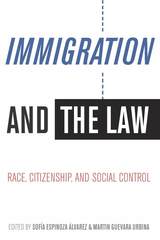 Immigration and the Law: Race, Citizenship, and Social Control
Edited by Sofía Espinoza Álvarez and Martin Guevara Urbina
University of Arizona Press, 2018 In the era of globalization, shifting political landscapes, and transnational criminal organizations, discourse around immigration is reaching unprecedented levels. Immigration and the Law is a timely and significant volume of essays that addresses the social, political, and economic contexts of migration in the United States. The contributors analyze the historical and contemporary landscapes of immigration laws, their enforcement, and the discourse surrounding these events, as well as the mechanisms, beliefs, and ideologies that govern them.
In today’s highly charged atmosphere, Immigration and the Law gives readers a grounded and broad overview of U.S. immigration law in a single book. Encompassing issues such as shifting demographics, a changing criminal justice system, and volatile political climate, the book is critically significant for academic, political, legal, and social arenas.
The contributors offer sound evidence to expose the historical legacy of violence, brutality, manipulation, oppression, marginalization, prejudice, discrimination, power, and control. Demystifying the ways that current ideas of ethnicity, race, gender, and class govern immigration and uphold the functioning and legitimacy of the criminal justice system, Immigration and the Law presents a variety of studies and perspectives that offer a pathway toward addressing long-neglected but vital topics in the discourse on immigration and the law.
Contributors
Sofía Espinoza Álvarez
Steven W. Bender
Leo R. Chávez
Arnoldo De León
Daniel Justino Delgado
Roxanne Lynn Doty
Brenda I. Gill
Ruth Gomberg-Muñoz
Peter Laufer
Lupe S. Salinas
Mary C. Sengstock
Martin Guevara Urbina
Claudio G. Vera Sánchez
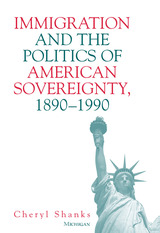 Immigration and the Politics of American Sovereignty, 1890-1990
Cheryl Shanks
University of Michigan Press, 2001 What does it mean to be an American? The United States defines itself by its legal freedoms; it cannot tell its citizens who to be. Nevertheless, where possible, it must separate citizen from alien. In so doing, it defines the desirable characteristics of its citizens in immigration policy, spelling out how many and, most importantly, what sorts of persons can enter the country with the option of becoming citizens.
Over the past century, the U.S. Congress argued first that prospective citizens should be judged in terms of race, then in terms of politics, then of ideology, then of wealth and skills. Each argument arose in direct response to a perceived foreign threat--a threat that was, in the government's eyes, racial, political, ideological, or economic. Immigration and the Politics of American Sovereignty traces how and why public arguments about immigrants changed over time, how some arguments came to predominate and shape policy, and what impact these arguments have had on how the United States defines and defends its sovereignty.
Cheryl Shanks offers readers an explanation for immigration policy that is more distinctly political than the usual economic and cultural ones. Her study, enriched by the insights of international relations theory, adds much to our understanding of the notion of sovereignty and as such will be of interest to scholars of international relations, American politics, sociology, and American history.
Cheryl Shanks is Assistant Professor of Political Science, Williams College.
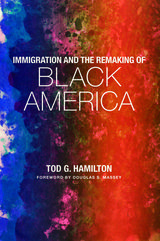 Immigration and the Remaking of Black America
Tod G. Hamilton
Russell Sage Foundation, 2019 Winner of the 2020 Otis Dudley Duncan Award for Outstanding Scholarship in Social Demography
Honorable Mention for the 2020 Thomas and Znaniecki Award from the International Migration Section of the American Sociological Association
Over the last four decades, immigration from the Caribbean and sub-Saharan Africa to the U. S. has increased rapidly. In several states, African immigrants are now major drivers of growth in the black population. While social scientists and commentators have noted that these black immigrants’ social and economic outcomes often differ from those of their native-born counterparts, few studies have carefully analyzed the mechanisms that produce these disparities. In Immigration and the Remaking of Black America, sociologist and demographer Tod Hamilton shows how immigration is reshaping black America. He weaves together interdisciplinary scholarship with new data to enhance our understanding of the causes of socioeconomic stratification among both the native-born and newcomers.
Hamilton demonstrates that immigration from the Caribbean and sub-Saharan Africa is driven by selective migration, meaning that newcomers from these countries tend to have higher educational attainment than those who stay behind. As a result, they arrive in the U.S. with some advantages over native-born blacks, and, in some cases, over whites. He also shows the importance of historical context: prior to the Civil Rights Movement, black immigrants’ socioeconomic outcomes resembled native-born blacks’ much more closely, regardless of their educational attainment in their country of origin. Today, however, certain groups of black immigrants have better outcomes than native-born black Americans—such as lower unemployment rates and higher rates of homeownership—in part because they immigrated at a time of expanding opportunities for minorities and women in general. Hamilton further finds that rates of marriage and labor force participation among native-born blacks that move away from their birth states resemble those of many black immigrants, suggesting that some disparities within the black population stem from processes associated with migration, rather than from nativity alone.
Hamilton argues that failing to account for this diversity among the black population can lead to incorrect estimates of the social progress made by black Americans and the persistence of racism and discrimination. He calls for future research on racial inequality to disaggregate different black populations. By richly detailing the changing nature of black America, Immigration and the Remaking of Black America helps scholars and policymakers to better understand the complexity of racial disparities in the twenty-first century.
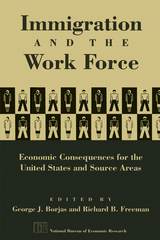 Immigration and the Work Force: Economic Consequences for the United States and Source Areas
Edited by George J. Borjas and Richard B. Freeman
University of Chicago Press, 1992 Since the 1970s, the striking increase in immigration to the United States has been accompanied by a marked change in the composition of the immigrant community, with a much higher percentage of foreign-born workers coming from Latin America and Asia and a dramatically lower percentage from Europe.
This timely study is unique in presenting new data sets on the labor force, wage rates, and demographic conditions of both the U.S. and source-area economies through the 1980s. The contributors analyze the economic effects of immigration on the United States and selected source areas, with a focus on Puerto Rico and El Salvador. They examine the education and job performance of foreign-born workers; assimilation, fertility, and wage rates; and the impact of remittances by immigrants to family members on the overall gross domestic product of source areas.
A revealing and original examination of a topic of growing importance, this book will stand as a guide for further research on immigration and on the economies of developing countries.
Immigration Cinema in the New Europe
Isolina Ballesteros
Intellect Books, 2015 Immigration Cinema in the New Europe examines a variety of films from the early 1990s that depict and address the lives and identities of both first-generation immigrants and children of the diaspora in Europe. Whether they are authored by immigrants themselves or by white Europeans who use the resources and means of production of dominant cinema to politically engage with the immigrants’ predicaments, these films, Isolina Ballesteros shows, are unmappable—a condition resulting from immigration cinema’s recombination and deliberate blurring of filmic conventions pertaining to two or more genres. In an age of globalization and increased migration, this book theorizes immigration cinema in relation to notions such as gender, hybridity, transculturation, border crossing, transnationalism, and translation.
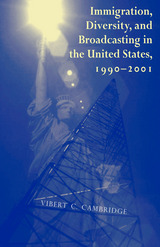 Immigration, Diversity, and Broadcasting in the United States 1990—2001
Vibert C. Cambridge
Ohio University Press, 2004 The last decade of the twentieth century brought a maturing of the new racial and ethnic communities in the United States and the emergence of diversity and multiculturalism as dominant fields of discourse in legal, educational, and cultural contexts. Immigration, Diversity, and Broadcasting in the United States, 1990—2001 is a contribution to our understanding of the web of relationships that existed at the intersection of immigration, race, ethnicity, and broadcasting in America during this period. Professor Vibert C. Cambridge investigates and questions how broadcasting in the United States responded to the changing racial and ethnic composition of the society. What patterns could be drawn from these responses? What roles were served? What roles are currently being served? What stimulated the changing of roles? Ultimately, Immigration, Diversity, and Broadcasting in the United States evaluates the performance of the American broadcasting industry. The answers to this book’s core questions provide insights into how the American broadcasting industry responded to freedom, equality, diversity, information quality, social order, and solidarity at century’s end.
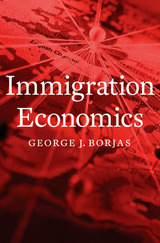 Immigration Economics
George J. Borjas
Harvard University Press, 2014 Millions of people—nearly 3 percent of the world’s population—no longer live in the country where they were born. Every day, migrants enter not only the United States but also developed countries without much of a history of immigration. Some of these nations have switched in a short span of time from being the source of immigrants to being a destination for them. International migration is today a central subject of research in modern labor economics, which seeks to put into perspective and explain this historic demographic transformation.
Immigration Economics synthesizes the theories, models, and econometric methods used to identify the causes and consequences of international labor flows. Economist George Borjas lays out with clarity and rigor a full spectrum of topics, including migrant worker selection and assimilation, the impact of immigration on labor markets and worker wages, and the economic benefits and losses that result from immigration.
Two important themes emerge: First, immigration has distributional consequences: some people gain, but some people lose. Second, immigrants are rational economic agents who attempt to do the best they can with the resources they have, and the same holds true for native workers of the countries that receive migrants. This straightforward behavioral proposition, Borjas argues, has crucial implications for how economists and policymakers should frame contemporary debates over immigration.
Immigration in Singapore
Edited by Norman Vasu, Yeap Su Yin, and Chan Wen Ling
Amsterdam University Press, 2015 This study traces the socio-political effects of immigration on Singapore and its population, a topic that has been the subject of intense debate in the nation as its population grows increasingly diverse. Beyond the logic of economic imperatives, the book aims to explore the larger consequences of taking in large number of immigrants, and its analysis should appeal to scholars of migration, social change, and public policy.
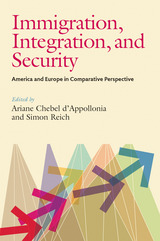 Immigration, Integration, and Security: America and Europe in Comparative Perspective
Ariane Chebel d'Appollonia
University of Pittsburgh Press, 2008 Recent acts of terrorism in Britain and Europe and the events of 9/11 in the United States have greatly influenced immigration, security, and integration policies in these countries. Yet many of the current practices surrounding these issues were developed decades ago, and are ill-suited to the dynamics of today's global economies and immigration patterns.
At the core of much policy debate is the inherent paradox whereby immigrant populations are frequently perceived as posing a potential security threat yet bolster economies by providing an inexpensive workforce. Strict attention to border controls and immigration quotas has diverted focus away from perhaps the most significant dilemma: the integration of existing immigrant groups. Often restricted in their civil and political rights and targets of xenophobia, racial profiling, and discrimination, immigrants are unable or unwilling to integrate into the population. These factors breed distrust, disenfranchisement, and hatred-factors that potentially engender radicalization and can even threaten internal security.
The contributors compare policies on these issues at three relational levels: between individual EU nations and the U.S., between the EU and U.S., and among EU nations. What emerges is a timely and critical examination of the variations and contradictions in policy at each level of interaction and how different agencies and different nations often work in opposition to each other with self-defeating results. While the contributors differ on courses of action, they offer fresh perspectives, some examining significant case studies and laying the groundwork for future debate on these crucial issues.
 Immigration Law and the U.S.–Mexico Border: ¿Sí se puede?
Kevin R. Johnson and Bernard Trujillo
University of Arizona Press, 2011 Americans from radically different political persuasions agree on the need to “fix” the “broken” US immigration laws to address serious deficiencies and improve border enforcement. In Immigration Law and the US–Mexico Border, Kevin Johnson and Bernard Trujillo focus on what for many is at the core of the entire immigration debate in modern America: immigration from Mexico.
In clear, reasonable prose, Johnson and Trujillo explore the long history of discrimination against US citizens of Mexican ancestry in the United States and the current movement against “illegal aliens”—persons depicted as not deserving fair treatment by US law. The authors argue that the United States has a special relationship with Mexico by virtue of sharing a 2,000-mile border and a “land-grab of epic proportions” when the United States “acquired” nearly two-thirds of Mexican territory between 1836 and 1853.
The authors explain US immigration law and policy in its many aspects—including the migration of labor, the place of state and local regulation over immigration, and the contributions of Mexican immigrants to the US economy. Their objective is to help thinking citizens on both sides of the border to sort through an issue with a long, emotional history that will undoubtedly continue to inflame politics until cooler, and better-informed, heads can prevail. The authors conclude by outlining possibilities for the future, sketching a possible movement to promote social justice. Great for use by students of immigration law, border studies, and Latino studies, this book will also be of interest to anyone wondering about the general state of immigration law as it pertains to our most troublesome border.
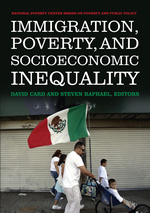 Immigration, Poverty, and Socioeconomic Inequality
David Card
Russell Sage Foundation, 2013 The rapid rise in the proportion of foreign-born residents in the United States since the mid-1960s is one of the most important demographic events of the past fifty years. The increase in immigration, especially among the less-skilled and less-educated, has prompted fears that the newcomers may have depressed the wages and employment of the native-born, burdened state and local budgets, and slowed the U.S. economy as a whole. Would the poverty rate be lower in the absence of immigration? How does the undocumented status of an increasing segment of the foreign-born population impact wages in the United States? In Immigration, Poverty, and Socioeconomic Inequality, noted labor economists David Card and Steven Raphael and an interdisciplinary team of scholars provide a comprehensive assessment of the costs and benefits of the latest era of immigration to the United States Immigration, Poverty, and Socioeconomic Inequality rigorously explores shifts in population trends, labor market competition, and socioeconomic segregation to investigate how the recent rise in immigration affects economic disadvantage in the United States. Giovanni Peri analyzes the changing skill composition of immigrants to the United States over the past two decades to assess their impact on the labor market outcomes of native-born workers. Despite concerns over labor market competition, he shows that the overall effect has been benign for most native groups. Moreover, immigration appears to have had negligible impacts on native poverty rates. Ethan Lewis examines whether differences in English proficiency explain this lack of competition between immigrant and native-born workers. He finds that parallel Spanish-speaking labor markets emerge in areas where Spanish speakers are sufficiently numerous, thereby limiting the impact of immigration on the wages of native-born residents. While the increase in the number of immigrants may not necessarily hurt the job prospects of native-born workers, low-skilled migration appears to suppress the wages of immigrants themselves. Michael Stoll shows that linguistic isolation and residential crowding in specific metropolitan areas has contributed to high poverty rates among immigrants. Have these economic disadvantages among low-skilled immigrants increased their dependence on the U.S. social safety net? Marianne Bitler and Hilary Hoynes analyze the consequences of welfare reform, which limited eligibility for major cash assistance programs. Their analysis documents sizable declines in program participation for foreign-born families since the 1990s and suggests that the safety net has become less effective in lowering child poverty among immigrant households. As the debate over immigration reform reemerges on the national agenda, Immigration, Poverty, and Socioeconomic Inequality provides a timely and authoritative review of the immigrant experience in the United States. With its wealth of data and intriguing hypotheses, the volume is an essential addition to the field of immigration studies. A Volume in the National Poverty Center Series on Poverty and Public Policy
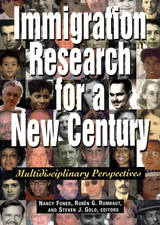 Immigration Research for a New Century: Multidisciplinary Perspectives
Nancy Foner
Russell Sage Foundation, 2000 The rapid rise in immigration over the past few decades has transformed the American social landscape, while the need to understand its impact on society has led to a burgeoning research literature. Predominantly non-European and of varied cultural, social, and economic backgrounds, the new immigrants present analytic challenges that cannot be wholly met by traditional immigration studies. Immigration Research for a New Century demonstrates how sociology, anthropology, history, political science, economics, and other disciplines intersect to answer questions about today's immigrants. In Part I, leading scholars examine the emergence of an interdisciplinary body of work that incorporates such topics as the social construction of race, the importance of ethnic self-help and economic niches, the influence of migrant-homeland ties, and the types of solidarity and conflict found among migrant populations. The authors also explore the social and national origins of immigration scholars themselves, many of whom came of age in an era of civil rights and ethnic reaffirmation, and may also be immigrants or children of immigrants. Together these essays demonstrate how social change, new patterns of immigration, and the scholars' personal backgrounds have altered the scope and emphases of the research literature, allowing scholars to ask new questions and to see old problems in new ways. Part II contains the work of a new generation of immigrant scholars, reflecting the scope of a field bolstered by different disciplinary styles. These essays explore the complex variety of the immigrant experience, ranging from itinerant farmworkers to Silicon Valley engineers. The demands of the American labor force, ethnic, racial, and gender stereotyping, and state regulation are all shown to play important roles in the economic adaptation of immigrants.The ways in which immigrants participate politically, their relationships among themselves, their attitudes toward naturalization and citizenship, and their own sense of cultural identity are also addressed. Immigration Research for a New Century examines the complex effects that immigration has had not only on American society but on scholarship itself, and offers the fresh insights of a new generation of immigration researchers.
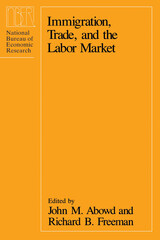 Immigration, Trade, and the Labor Market
Edited by John M. Abowd and Richard B. Freeman
University of Chicago Press, 1991 Are immigrants squeezing Americans out of the work force? Or is competition wth foreign products imported by the United States an even greater danger to those employed in some industries? How do wages and unions fare in foreign-owned firms? And are the media's claims about the number of illegal immigrants misleading?
Prompted by the growing internationalization of the U.S. labor market since the 1970s, contributors to Immigration, Trade, and the Labor Market provide an innovative and comprehensive analysis of the labor market impact of the international movements of people, goods, and capital. Their provocative findings are brought into perspective by studies of two other major immigrant-recipient countries, Canada and Australia. The differing experiences of each nation stress the degree to which labor market institutions and economic policies can condition the effect of immigration and trade on economic outcomes
Contributors trace the flow of immigrants by comparing the labor market and migration behavior of individual immigrants, explore the effects of immigration on wages and employment by comparing the composition of the work force in local labor markets, and analyze the impact of trade on labor markets in different industries. A unique data set was developed especially for this study—ranging from an effort to link exports/imports with wages and employment in manufacturing industries, to a survey of illegal Mexican immigrants in the San Diego area—which will prove enormously valuable for future research.
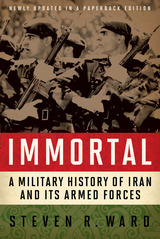 Immortal: A Military History of Iran and Its Armed Forces
Steven R. Ward
Georgetown University Press, 2009 Immortal is the only single-volume English-language survey of Iran’s military history. CIA analyst Steven R. Ward shows that Iran’s soldiers, from the famed “Immortals” of ancient Persia to today’s Revolutionary Guard, have demonstrated through the centuries that they should not be underestimated. This history also provides background on the nationalist, tribal, and religious heritages of the country to help readers better understand Iran and its security outlook. Immortal begins with the founding of ancient Persia’s empire under Cyrus the Great and continues through the Iran-Iraq War (1980–1988) and up to the present. Drawing on a wide range of sources including declassified documents, the author gives primary focus to the modern era to relate the build-up of the military under the last Shah, its collapse during the Islamic revolution, its fortunes in the Iran-Iraq War, and its rise from the ashes to help Iran become once again a major regional military power. He shows that, despite command and supply problems, Iranian soldiers demonstrate high levels of bravery and perseverance and have enjoyed surprising tactical successes even when victory has been elusive. These qualities and the Iranians’ ability to impose high costs on their enemies by exploiting Iran’s imposing geography bear careful consideration today by potential opponents.
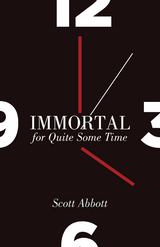 Immortal for Quite Some Time
Scott Abbott
University of Utah Press, 2016 Winner of the Utah Arts Council's Original Writing Competition Book Manuscript Prize in Creative Nonfiction
Winner of the 15 Bytes Book Award for Creative Nonfiction
“This is not a memoir. Rather, this is a fraternal meditation on the question: ‘Are we friends, my brother?’ The story is uncertain, the characters are in flux, the voices are plural, the photographs are as troubled as the prose. This is not a memoir.”
Thus Scott Abbott introduces the reader to his exploration of the life of his brother John, a man who died of AIDS in 1991 at the age of forty. Writing about his brother, he finds he is writing about himself and about the warm-hearted, educated, and homophobic LDS family that forged the core of his identity.
Images and quotations are interwoven with the reflections, as is a critical female voice that questions his assertions and ridicules his rhetoric. The book moves from the starkness of a morgue’s autopsy through familial disintegration and adult defiance to a culminating fraternal conversation. This exquisitely written work will challenge notions of resolution and wholeness.
 Immortal River: The Upper Mississippi in Ancient and Modern Times
Calvin R. Fremling
University of Wisconsin Press, 2005 This engaging and well-illustrated primer to the Upper Mississippi River presents the basic natural and human history of this magnificent waterway. Immortal River is written for the educated lay-person who would like to know more about the river's history and the forces that shape as well as threaten it today. It melds complex information from the fields of geology, ecology, geography, anthropology, and history into a readable, chronological story that spans some 500 million years of the earth's history.
Like the Mississippi itself, Immortal River often leaves the main channel to explore the river's backwaters, floodplain, and drainage basin. The book's focus is the Upper Mississippi, from Minneapolis, Minnesota, to Cairo, Illinois. But it also includes information about the river's headwaters in northern Minnesota and about the Lower Mississippi from Cairo south to the river's mouth ninety miles below New Orleans. It offers an understanding of the basic geology underlying the river's landscapes, ecology, environmental problems, and grandeur.
Immortal Sofa
Maura Stanton
University of Illinois Press, 2008 In accessible poems full of rich detail and painterly images, Maura Stanton looks under the surface of the ordinary, hoping to find the magic spark below the visible. In poems both humorous and elegaic, she gathers strange facts, odd events, and overlooked stories to construct her own vision of immortality, one made up of fragments of history and geography and the illusions of yearning human beings. From elephants in Ceylon to Nazi prisoners in Ireland, from Beowulf to Jane Austen, from sonnets to prose poems to blank verse, Immortal Sofa conjures our complex existence in all its sorrowful but astonishing variety.
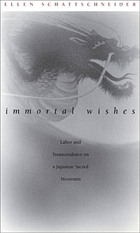 Immortal Wishes: Labor and Transcendence on a Japanese Sacred Mountain
Ellen Schattschneider
Duke University Press, 2003 Immortal Wishes is a powerful ethnographic rendering of religious experiences of landscape, healing, and self-fashioning on a northern Japanese sacred mountain. Working at the intersection of anthropology, religion, and Japan studies, Ellen Schattschneider focuses on Akakura Mountain Shrine, a popular Shinto institution founded by a rural woman in the 1920s. For decades, local spirit mediums and worshipers, predominantly women, have undertaken extended periods of shugyo (ascetic discipline) within the shrine and on the mountain's slopes. Schattschneider argues that their elaborate, transforming repertoire of ritual practice and ascetic discipline has been generated by complex social and historical tensions largely emerging out of the uneasy status of the surrounding area within the modern nation's industrial and postindustrial economies. Schattschneider shows how, through dedicated work at the shrine including demanding ascents up the sacred mountain, the worshipers come to associate the rugged mountain landscape with their personal biographies, the life histories of certain exemplary predecessors and ancestors, and the collective biography of the extended congregation. She contends that this body of ritual practice presents worshipers with fields of imaginative possibilities through which they may dramatize or reflect upon the nature of their relations with loved ones, ancestors, and divinities. In some cases, worshipers significantly redress traumas in their own lives or in those of their families. In other instances, these ritualized processes lead to deepening crises of the self, the accelerated fragmentation of local households, and apprehension of possession by demons or ancestral forces. Immortal Wishes reveals how these varied practices and outcomes have over time been incorporated into the changing organization of ritual, space, and time on the mountainscape. For more information about this book and to read an excerpt, please click here.
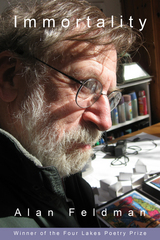 Immortality
Alan Feldman
University of Wisconsin Press, 2015 “Drop the personal,” Alan Feldman’s best friend advises. But what else does he have? Feldman takes his title from Zhivago’s interpretations of the afterlife: “Your soul, your immortality, your life in others.”
In a collection where the dead do speak, Feldman’s poems in his first segment, “Self-Portraits,” are more likely to be about others than about himself. The segment “Partners” reflects on marriage and divorce, the latter an “uncontested victor over marriage, / the way the flood is champion over the flood plain.” In the section “Offshore” Feldman writes about travel to Uruguay, his impractical love of sailing, and his wonder at Walter Cronkite’s obtuseness about Vietnam. In his final segment, “What Now?,” he asks about meaning itself. Babysitting his tiny granddaughter, he thinks of sailing—hours of boredom punctuated by moments of terror—and wonders if even this suggests something world-encompassing he’s “still hoping to find a name for. / If it isn’t joy.”
Winner of the Mass Book Award for Poetry, Massachusetts Center for the Book
Immortality and the Cosmic Process
Shailer Mathews
Harvard University Press If we are immortal, or if we become immortal, it will not be because we want to or because it is indispensable for morality, but because in a universe like ours we can no more help it than we can help feeling warm before a fire. So considered, personal immortality can be treated as any other alleged fact. Dr Mathews examines it in the light of physiology, biology, and psychology; and through the keenness of his reasoning reaches a conception of the survival of personality that will forcefully commend itself to thinking people.
Immortality and the Present Mood
Julius Seelye Bixler
Harvard University Press The current Ingersoll Lecture discusses the dilemma caused by modern man’s yearning, in spite of all his pose of adaptation to reality, for a significance for his values greater than that which mortal life affords, coupled with his complete inability to imagine immortal existence or to see how his values could be conserved by indefinite continuance through time. It is suggested that the way out may be through a recognition of the fact that timeless values are achieved in the aesthetic and mystical detachment, the logical critical judgment, and the devoted, disinterested activity of which humanity is capable. These mark the ends of spirit as distinct from those of life, and point to a goal which has more intrinsic worth than that of survival itself.
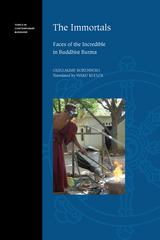 The Immortals: Faces of the Incredible in Buddhist Burma
Guillaume Rozenberg, translated by Ward Keeler
University of Hawaii Press, 2015 In 1952 a twenty-six-year-old man living in a village in Central Burma was possessed by weikza—humans with extraordinary powers, including immortality. Key figures in Burmese Buddhism, weikza do not die but live on in an invisible realm. From there they re-enter the world through possession to care for people’s temporal and spiritual needs while protecting and propagating Buddhism. A cult quickly formed around the young peasant, the chosen medium for four weikza ranging in age from 150 to 1000 years. In addition, these weikza appeared regularly in the flesh. The Immortals plunges us into the midst of this cult, which continues to attract followers from all over the country who seek to pay homage to the weikza, receive their teaching, and benefit from their power. The cult of the four weikza raises a number of classic anthropological issues, particularly for of religion: the nature of the supernatural and of belief; the relations among religion, magic, and science; the experience of possession. It also provides a window on contemporary Burmese society. To contemplate both, the author adopts an unconventional approach, which itself reflects how anthropology uses description and the interpretations description occasions to make sense of what it studies. The writing makes clear both the indigenous take on reality and the work of anthropological understanding as it is being elaborated, along with the ties that connect the latter to the former. Mixing narration of the incredible with reflection on the forms religious experience takes, The Immortals offers us a way to accompany the author into the field and to grasp—to take up and make our own—the anthropologist’s interpretations and the realities to which they pertain.
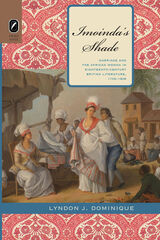 Imoinda’s Shade: Marriage and the African Woman in Eighteenth-Century British Literature, 1759–1808
Lyndon J. Dominique
Ohio State University Press, 2012 As the eighteenth century is entirely bereft of narratives written by African women, one might assume that these women had little to no impact on British literature and the national psyche of the period. Yet these kinds of assumptions are belied by the influence of one prominent African woman featured in the period’s literary texts. Imoinda’s Shade examines the ways in which British writers utilize the most popular African female figure in eighteenth-century fiction and drama to foreground the African woman’s concerns and interests as well as those of a British nation grappling with the problems of slavery and abolition. Imoinda, the fictional phenomenon initially conceived by Aphra Behn and subsequently popularized by Thomas Southerne, has an influence that extends well beyond the Oroonoko novella and drama that established her as a formidable presence during the late Restoration period. This influence is palpably discerned in the characterizations of African women drawn up in novels and dramas written by late-eighteenth-century British writers. Through its examinations of the textual instances from 1759–1808 when Imoinda and her involvement in the Oroonoko marriage plot are being transformed and embellished for politicized ends, Imoinda’s Shade demonstrates how this period’s fictional African women were deliberately constructed by progressive eighteenth-century writers to popularize issues of rape, gynecological rebellion, and miscegenation. Moreover, it shows how these specific African female concerns influence British antislavery, abolitionist, and post-slavery discourse in heretofore unheralded, unusual, and sometimes radical ways.
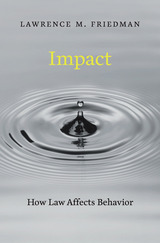 Impact: How Law Affects Behavior
Lawrence M. Friedman
Harvard University Press, 2016 Laws and regulations are ubiquitous, touching on many aspects of individual and corporate behavior. But under what conditions are laws and rules actually effective? A huge amount of recent work in political science, sociology, economics, criminology, law, and psychology, among other disciplines, deals with this question. But these fields rarely inform one another, leaving the state of research disjointed and disorganized. Lawrence M. Friedman finds order in this cacophony. Impact gathers recent findings into one overarching analysis and lays the groundwork for a cohesive body of work in what Friedman labels “impact studies.”
The first important factor that has a bearing on impact is communication. A rule or law has no effect if it never reaches its intended audience. The public’s fund of legal knowledge, the clarity of the law, and the presence of information brokers all influence the flow of information from lawmakers to citizens. After a law is communicated, subjects sometimes comply, sometimes resist, and sometimes adjust or evade. Three clusters of motives help shape which reaction will prevail: first, rewards and punishments; second, peer group influences; and third, issues of conscience, legitimacy, and morality. When all of these factors move in the same direction, law can have a powerful impact; when they conflict, the outcome is sometimes unpredictable.
The Impact of Aristotelianism on Modern Philosophy
Riccardo Pozzo
Catholic University of America Press, 2019 This volume provides the first extensive assessment of the impact of Aristotelianism on the history of philosophy from the Renaissance to the end of the twentieth century. The contributors have considered Aristotelian issues in late scholastic, Renaissance, and early modern philosophers such as Vernia, Nifo, Barbaro, Cajetan, Piccolomini, Patrizzi, Zabarella, Campanella, Galileo, Sémery, Leibniz, Rousseau, Kant, Hegel, Nietzsche, Husserl, Heidegger, Wittgenstein, and Gadamer. Specific attention is given to the role of the five intellectual virtues set forth by Aristotle in book VI of the Nicomachean Ethics, namely art, prudence, science, wisdom, and intellect.
The Impact of Cognition on Radar Technology
Alfonso Farina
The Institution of Engineering and Technology, 2018 Cognitive dynamic systems are inspired by the computational capability of the brain and the viewpoint that cognition is a supreme form of computation. The key idea behind this new paradigm is to mimic the human brain as well as that of other mammals with echolocation capabilities which continuously learn and react to stimulations according to four basic processes: perception-action cycle, memory, attention, and intelligence.
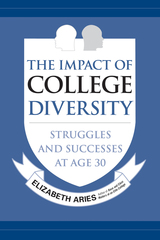 The Impact of College Diversity: Struggles and Successes at Age 30
Elizabeth Aries
Temple University Press, 2023 In 2005, Elizabeth Aries chronicled what 58 Amherst College freshman—Black and white, affluent and lower-income—learned from racial and class diversity. Her study emphasized the value of campus diversity at elite colleges. Four years later, Aries interviewed the same students about their diversity experiences as they graduated. Now, eight years later, she re-interviews her participants to see how and to what extent race and class continue to play a role as they move into adulthood.
The Impact of College Diversity details how exposure to diversity in college helped shape Black and white graduates process issues of economic and racial privilege and inequality at age 30. She investigates how college diversity experiences also facilitate the attainment of upward social mobility in lower-income students and the role that mobility played in their relationships with family and friends in their home communities. Aries further examines how interactions with peers of another race and class influenced development of citizenship skills and civic engagement, as well as Black students’ ability to cope with the challenges they faced in the professional world.
Aries concludes her study with a discussion of why elite colleges have been beneficial in promoting upward mobility in lower-income students, and the importance of achieving equity and inclusion in making diversity initiatives successful.
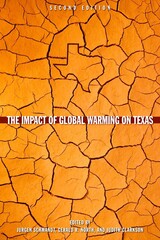 The Impact of Global Warming on Texas: Second edition
Edited by Jurgen Schmandt, Gerald R. North, and Judith Clarkson
University of Texas Press, 2011 When The Impact of Global Warming on Texas was first published in 1995, it discussed climate change as a likely future phenomenon, predicted by scientific studies. This entirely rewritten second edition presents evidence that early climate change impacts can now be observed and identifies the threats climate change will pose to Texas through the year 2050. It also offers the hopeful message that corrective action, if taken now, can avert unmanageable consequences. The book begins with a discussion of climate science and modeling and the information that can be derived from these sources for Texas. The authors follow this with an analysis of actual climate trends in the various Texas climate regions, including a predicted rise in temperatures of 5.4 degrees F (plus or minus 1.8 F) by the end of the century. This could lead to less rainfall and higher evaporation, especially in regions that are already dry. Other important effects include possible changes in El Niño (climate variability) patterns and hurricane behaviors. Taking into account projected population growth, subsequent chapters explore likely trends with respect to water availability, coastal impacts, and biodiversity. The authors then look at the issues from a policy perspective, focusing on Texas's importance to the national economy as an energy producer, particularly of oil and gas. They recommend that Texas develop its own climate change policy to serve the goals of reducing greenhouse gas emissions, increasing energy independence, ensuring regional security, and improving management of water, air, land, and wildlife.
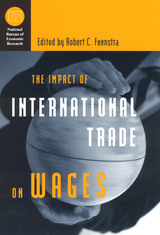 The Impact of International Trade on Wages
Edited by Robert C. Feenstra
University of Chicago Press, 2000 Since the early 1980s, the U.S. economy has experienced a growing wage differential: high-skilled workers have claimed an increasing share of available income, while low-skilled workers have seen an absolute decline in real wages. How and why this disparity has arisen is a matter of ongoing debate among policymakers and economists. Two competing theories have emerged to explain this phenomenon, one focusing on international trade and labor market globalization as the driving force behind the devaluation of low-skill jobs, and the other focusing on the role of technological change as a catalyst for the escalation of high-skill wages.
This collection brings together innovative new ideas and data sources in order to provide more satisfying alternatives to the trade versus technology debate and to assess directly the specific impact of international trade on U.S. wages. This timely volume offers a thorough appraisal of the wage distribution predicament, examining the continued effects of technology and globalization on the labor market.
The Impact of Losing Your Job: Unemployment and Influences from Market, Family, and State on Economic Well-Being in the US and Germany
Martin Ehlert
Amsterdam University Press, 2016 Losing a job has always been understood as one of the most important causes of downward social mobility in modern societies. And it's only gotten worse in recent years, as the weakening position of workers has made re-entering the labour market even tougher. The Impact of Losing Your Job builds on findings from life course sociology to show clearly just what effects job loss has on income, family life, and future prospects. Key to Ehlert's analysis is a comparative look at the United States and Germany that enables him to show how different approaches to welfare state policies can ameliorate the effects of job loss-but can at the same time make labour insecurity more common.
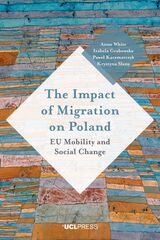 Impact of Migration on Poland: EU Mobility and Social Change
Anne White, Izabela Grabowska, Pawel Kaczmarczyk, and Krystyna Slany
University College London, 2018 How has the international mobility of Polish citizens intertwined with other influences to shape society, culture, politics, and economics in contemporary Poland?
The Impact of Migration on Poland offers a new approach for understanding how migration affects sending countries and provides a wide-ranging analysis of how Poland has changed, and continues to change, since accession to the European Union in 2004. The authors explore an array of social trends and their causes before using in-depth interview data to illustrate how migration contributes to those causes. They address fundamental questions about whether and how Polish society is becoming more equal and more cosmopolitan, arguing that for particular segments of society migration does make a difference. While the book focuses mainly on those who have stayed in Poland, and their contacts with Poles in other countries, it also analyzes Polish society abroad, a concept that is a far more accurate description than “community” in countries such as the UK.
The Impact of Mindfulness Meditation Programs on Performance-Related Outcomes: Implications for the U.S. Army
Kimberly A. Hepner
RAND Corporation, 2022 This report presents results from a systematic review and meta-analyses of research examining how mindfulness meditation affects 13 performance-related outcomes of interest to the U.S. Army and broader military. The authors supplemented the systematic review by examining how mindfulness meditation could support stress management and exploring characteristics of selected mindfulness programs.
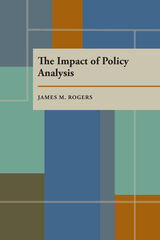 The Impact of Policy Analysis
James M. Rogers
University of Pittsburgh Press, 1988
Government agencies spend billions of dollars each year for policy analysis with the expectation that improved policy will follow. Although civil servants conduct some analysis themselves, more frequently they contract with research organizations to assess the probable consequences of new social policies and to answer other policy questions.
Jams M. Rogers develops a theory that explains and predicts the impact of policy analysis. He illustrates his theory through welfare reform, where policy analysis is caught in political warfare and has little chance to improve actual policy.
During the 1960s and 1970s over $108 million was spent on four unprecedented social scientific experiments to test the effectiveness of a major proposal to reform the welfare system. Now out of favor, the negative income tax was thn considered to be an appealing alternative to welfare. Starting in New Jersey and Pennsylvania during the Johnson administration, the experimental research continued through Carter's term and helped to keep reform proposal and research organizations alive. This book examines the results of these experiments and their effect on Carter's reform attempt—the Program for Better Jobs and Income.
One of the author's main conclusions concerns the role of value conflict. If there is strong disagreement within society over the goals of policy, analysis will seldom change the minds of decision makers or influence policy. Policy analysis is more likely to influence thinking and policy if the issue involves low conflict.
The Impact of Research in Education: An International Perspective
Edited by Ben Levin, Jie Qi, Hilary Edelstein, and Jacqueline Sohn
Bristol University Press, 2013 Scholarly research plays an important role in shaping education policy around the world, but the process of disseminating and applying research findings remains complicated and difficult. Analyzing efforts to mobilize such knowledge in nine countries, the contributors to this volume provide an unprecedented international perspective on the way education research is produced and shared. By detailing the many factors that support or inhibit these endeavors, they identify global trends and point the way toward improvements that could increase the positive impact of research in education.
The Impact of the Civil War and Reconstruction on Arkansas: Persistence in the Midst of Ruin
Carl H. Moneyhon
University of Arkansas Press, 2002 This groundbreaking study, first published in 1994, draws on a rich variety of primary sources to describe Arkansas society before, during, and after the Civil War. While the Civil War devastated the state, this book shows how those who were powerful before the war reclaimed their dominance during Reconstruction. Most importantly, the white elite's postwar commitment to a cotton economy led them to set up a sharecropping system very much like slavery, in which workers had little control over their own labor. In arguing for both change and continuity, Moneyhon reconciles contemporary accounts of the war's effects while addressing ongoing debates within the historical literature.
 The Impact of the War on the Schools of Red Wing
Nelson Bossing
University of Minnesota Press, 1945
The Impact of the War on the Schools of Red Wing was first published in 1945. Minnesota Archive Editions uses digital technology to make long-unavailable books once again accessible, and are published unaltered from the original University of Minnesota Press editions.What happens to the American small community in periods of war and challenge, change and uncertainty? In an age of planning, why not look at the community basis for planning?With these two questions as a basis, the University of Minnesota, in 1943, began one of the most exhaustive studies of an American community undertaken in recent times. Red Wing, Minnesota, on the banks of the Mississippi River in Goodhue County was chosen as the “typical small American city.”Professors of education, economics, sociology, art, home economics, journalism, and public health joined with city officials and civic leaders in studying every aspect of the city and its people. Their findings are published in eleven bulletins, each devoted to an individual topic. The entire survey, entitled The Community Basis for Postwar Planning, was coordinated by Roland S. Vaile, former professor of economics and marketing at the University of Minnesota, and made possible by a grant from the Graduate School.The present study, The Impact of the War on the Schools Red Wing, surveys the public education system as it adapts to postwar reconstruction. The authors devote particular attention to the organization and services of schools, knowledge and attitudes of pupils about war-related matters, and impact on school curriculum and instruction.
 The Impact of Touch in Dance Movement Psychotherapy: A Body–Mind Centering Approach
Katy Dymoke
Intellect Books, 2021 A presentation of clinical outcomes that demonstrate significant new insights into the value of touch to the therapeutic process.
In this book, dance movement psychotherapist Katy Dymoke presents an in-depth case study of work with a client with a profound learning disability. The research stems from a postdoctoral thesis sponsored by the United Kingdom’s National Health Service, where Dymoke was employed at the time of the clinical outcomes relayed in this work. The volume includes transcripts of the session content; descriptions of how incidents of touch were initiated and undertaken within the process; subsequent categorizations of the incidents of touch as self-directed, passive, or reciprocal; and commentary and discussion of the therapeutic process. As we see, the incidents of touch contribute to the client’s process of mental distress, trauma, lack of capacity, and more. Finally, Dymoke includes sections on the ethical issues of this work in the NHS, on doing research with such a client group, and on the theoretical models that emerged.
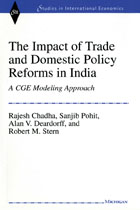 The Impact of Trade and Domestic Policy Reforms in India: A CGE Modeling Approach
Rajesh Chadha, Alan V. Deardorff, Sanjib Pohit, and Robert M. Stern
University of Michigan Press, 1998 Major economic reforms undertaken since 1991 have brought the Indian economy into a new phase of development directed toward becoming globally competitive through the opening of trade, foreign investment, and technology inflows. The private sector is expected to play a lead role, with a corresponding reduction in the role played by the public sector. This book is aimed at analyzing the comparative static effects of selected post-1991 trade and domestic policy reforms on trade, factor prices, economic welfare, and the intersectoral allocation of resources.
The study relies on a computable general equilibrium (CGE) model that has been specially designed to analyze the potential economic effects of India's policy reforms. The model was developed in a collaborative effort involving the National Council of Applied Economic Research in New Delhi and the University of Michigan. Patterned after the Michigan CGE Model of World Production and Trade that has been in use for more than two decades, the India CGE model features closer attention to special characteristics of India's economic structure, including more agricultural sector detail, allowance for state ownership, and administered pricing. The conclusions of the study suggest that the policy reforms will yield increased real returns to land, labor, and capital, and shift the terms of trade in favor of Indian agriculture. Lastly, not only are there efficiency-enhancing intersectoral shifts in resource allocation but there are notable increases in scale economies across the Indian manufacturing sectors.
Rajesh Chadha and Sanjib Pohit are Economists at the National Council of Applied Economic Research in New Delhi. Alan V. Deardorff and Robert M. Stern are Professors of Economics and Public Policy, University of Michigan.
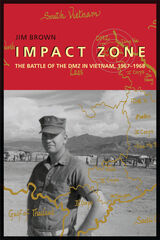 Impact Zone: The Battle of the DMZ in Vietnam, 1967–1968
Jim Brown
University of Alabama Press, 2004 In the heart of the DMZ, one Marine faced the war—and the truth behind it. Impact Zone documents Marine First Lieutenant James S. Brown's intense battle experiences, including those at Khe Sanh and Con Thien, throughout his thirteen months of service on the DMZ during 1967-68. This high-action account also reflects Brown's growing belief that the Vietnam War was mis-fought due to the unproductive political leadership of President Johnson and his administration. Brown's naiveté developed into hardening skepticism and cynicism as he faced the harsh realities of war, though he still managed to retain a sense of honor, pride, and patriotism for his country. Impact Zone is a distinctive book on the Vietnam War because it is told from the perspective of an artilleryman, and the increasingly dangerous events gain momentum as they progress from one adventure to the next. Impact Zone is not only an important historical document of the Vietnam conflict, but also a moving record of the personal and emotional costs of war.
 Impactful Community-Based Literacy Projects
Lesley S. J. Farmer
American Library Association, 2021 Foreword by Dr. Lois Bridges Inspired by the Library of Congress Literacy Awards Program and its applicants, which have showcased and disseminated innovative literacy initiatives across the country and around the world since 2013, this book provides evidence-based practice guidelines for librarians and educators. To optimize results, the projects in this book blend early literacy benefits, fundamental reading skills, and other foundational concepts with culture- or community-specific sensitivity and leveraging. They’re adaptable based on age, audience, size, resources, and budget; and most importantly, they address social inequities and foster cross-culture interactions. Inside, readers will find - detailed profiles of dozens of successful literacy projects, which include such activities as oral storytelling, the Parent-Child Home Program, a repository of multilingual children’s stories, accessible web readers, personal tutors, and many more;
- an overview of universal steps to literacy, explaining how people learn, generic reading skill development, human developmental issues, and habits of literacy;
- research-based factors for impactful literacy projects;
- discussion of the importance and role of literacy partners such as families, schools and universities, libraries, government agencies, nonprofit organizations, and for-profit entities;
- advice on project planning, including needs assessment, goals and objectives, literacy review, target audience, project personnel, resources, setting and timing, communication, support, implementation, and continuous assessment and improvement; and
- guidance on building capacity, empowering the community, and sustaining a culture of literacy.
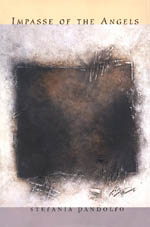 Impasse of the Angels: Scenes from a Moroccan Space of Memory
Stefania Pandolfo
University of Chicago Press, 1997 The image of the ethnographer in the field who observes his or her subjects from a distance while copiously taking notes has given way in recent years to a more critical and engaged form of anthropology. Composed as a polyphonic dialogue of texts, Stefania Pandolfo's Impasse of the Angels takes this engagement to its limit by presenting the relationship between observer and observed as one of interacting equals and mutually constituting interlocuters.
Impasse of the Angels explores what it means to be a subject in the historical and poetic imagination of a southern Moroccan society. Passionate and lyrical, ironic and tragic, the book listens to dissonant, often idiosyncratic voices—poetic texts, legends, social spaces, folktales, conversations—which elaborate in their own ways the fractures, wounds, and contradictions of the Maghribî postcolonial present. Moving from concrete details in a traditional ethnographic sense to a creative, experiential literary style, Impasse of the Angels is a tale of life and death compellingly addressing readers from anthropology, literature, philosophy, postcolonial criticism, and Middle Eastern studies.
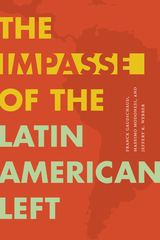 The Impasse of the Latin American Left
Franck Gaudichaud, Massimo Modonesi, and Jeffery R. Webber
Duke University Press, 2022 In The Impasse of the Latin American Left, Franck Gaudichaud, Massimo Modonesi, and Jeffery R. Webber explore the region’s Pink Tide as a political, economic, and cultural phenomenon. At the turn of the twenty-first century, Latin American politics experienced an upsurge in progressive movements, as popular uprisings for land and autonomy led to the election of left and center-left governments across Latin America. These progressive parties institutionalized social movements and established forms of state capitalism that sought to redistribute resources and challenge neoliberalism. Yet, as the authors demonstrate, these governments failed to transform the underlying class structures of their societies or challenge the imperial strategies of the United States and China. Now, as the Pink Tide has largely receded, the authors offer a portrait of this watershed period in Latin American history in order to evaluate the successes and failures of the left and to offer a clear-eyed account of the conditions that allowed for a right-wing resurgence.
Impasse Poetics at the Nordic Oil Coast: Contemporary Petrofiction from Denmark and Norway
Karl Emile Rosenbaek
West Virginia University Press, 2026 The first major study of contemporary Nordic petrofiction. Through a variety of cultural texts, including the Nordic noir mystery Smila’s Sense of Snow, Rosenbaek Reetz exposes the cultural, political, and environmental tensions in which green frontier ideas must coexist with the ongoing reliance on oil and gas and critiques the paradox of Nordic nations positioning themselves as climate leaders while remaining deeply tied to fossil fuel economies.
 Impasses of the Post-Global: Theory in the Era of Climate Change
Henry Sussman
Michigan Publishing, 2012 The diverse materials comprising Impasses of the Post-Global take as their starting point an interrelated, if seemingly endless sequence of current ecological, demographic, socio-political, economic, and informational disasters. These have impacted on the stakes and tenor of cultural criticism as much as they have on tangible relations in the contemporary world. The contributors to the Impasses struggle as valiantly with a rapidly unfolding set of new discursive and communicative preconditions as they do with the open-ended chain of current insults and injuries to the ecological, socio-political, and cultural surrounds. These in turn demand increased attentiveness on the part of culturally and politically engaged readers. If the volume claims a global, if not post-global scope in the range of its perspectives and interventions, the diversity of approaches and interests advanced and updated by its contributors is correspondingly vast. These include the contemporary discourses of deconstruction, climate change, ecological imbalance and despoilment, sustainability, security, economic bailout, auto-immunity, and globalization itself. With contributions by James H. Bunn, Rey Chow, Bruce Clarke, Tom Cohen, Randy Martin, Yates McKee, Alberto Moreiras, Haun Saussy, Tian Song, Henry Sussman, Samuel Weber, Ewa P. Ziarek, and Kryzsztof Ziarek.
 Impastoral
Brandan Griffin
Omnidawn, 2022 Poems that blur the boundaries of language and species, inviting us to imagine a new world.
The expansive reworking of language in Impastoral flies through the possible voices of outsides and insides—slug, probe, horse carriage, sewer, potted plant, lab rat, vampire, bot fly, giant cow. Language, in Brandan Griffin’s poetry, is neither human nor nonhuman, and it undoes that very idea of these distinctions, so beings—slugprobe, pottedhorsesewer, telepathybarcode, mammaltexts—morph and change in between boundaries.
Each of these poems is an organism, a collection of living connections, looped interiorities strung together in worlds tunneling through worlds. The poems’ composition becomes a decomposition of budding, breeding, and fluctuating. Reading this collection is an experience of becoming deformed and merged into the experiences of other beings; you are sea vent, microprocessor, cell gel, bug, a greenly translucent leaf typed half a sound at a time. Griffin invites us to imagine all possible beings and to hatch into a fresh world.
Impastoral won the Omnidawn Open Book contest, selected by Brian Teare.
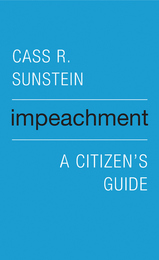 Impeachment: A Citizen’s Guide
Cass R. Sunstein
Harvard University Press, 2017 “Sunstein has written the story of impeachment every citizen needs to know. This is a remarkable, essential book.” —Doris Kearns Goodwin
As Benjamin Franklin famously put it, Americans have a republic, if we can keep it. Preserving the Constitution and the democratic system it supports is the public’s responsibility. One route the Constitution provides for discharging that duty—a route rarely traveled—is impeachment.
Cass R. Sunstein provides a succinct citizen’s guide to an essential tool of self-government. He illuminates the constitutional design behind impeachment and emphasizes the people’s role in holding presidents accountable. Despite intense interest in the subject, impeachment is widely misunderstood. Sunstein identifies and corrects a number of misconceptions. For example, he shows that the Constitution, not the House of Representatives, establishes grounds for impeachment, and that the president can be impeached for abuses of power that do not violate the law. Even neglect of duty counts among the “high crimes and misdemeanors” delineated in the republic’s foundational document. Sunstein describes how impeachment helps make sense of our constitutional order, particularly the framers’ controversial decision to install an empowered executive in a nation deeply fearful of kings.
With an eye toward the past and the future, Impeachment: A Citizen’s Guide considers a host of actual and imaginable arguments for a president’s removal, explaining why some cases are easy and others hard, why some arguments for impeachment have been judicious and others not. In direct and approachable terms, it dispels the fog surrounding impeachment so that Americans of all political convictions may use their ultimate civic authority wisely.
Impeachment: The Constitutional Problems
Raoul Berger
Harvard University Press, 1973 The little understood yet volcanic power of impeachment lodged in the Congress is dissected through history by the nation's leading legal scholar on the subject. Berger offers authoritative insight into "high crimes and misdemeanors." He sheds new light on whether impeachment is limited to indictable crimes, on whether there is jurisdiction to impeach for misconduct outside of office, and on whether impeachment must precede indictment. In an addition to the book, Berger finds firm footing in contesting the views of one-time Judge Robert Bork and President Nixon's lawyer, James St. Clair.
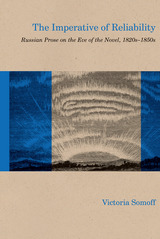 The Imperative of Reliability: Russian Prose on the Eve of the Novel, 1820s-1850s
Victoria Somoff
Northwestern University Press, 2015 The Imperative of Reliability examines the development of nineteenth-century Russian prose and the remarkably swift emergence of the Russian novel. Victoria Somoff identifies an unprecedented situation in the production and perception of the utterance that came to define nascent novelistic fictionality both in European and Russian prose, where the utterance itself—whether an oral story or a “found” manuscript—became the object of representation within the compositional format of the frame narrative. This circumstance generated a narrative perspective from which both the events and their representation appeared as concomitant in time and space: the events did not precede their narration but rather occurred and developed along with and within the narration itself. Somoff establishes this story-discourse convergence as a major factor in enabling the transition from shorter forms of Russian prose to the full-fledged realist novel.
The Imperative of Responsibility: In Search of an Ethics for the Technological Age
Hans Jonas
University of Chicago Press, 1984 A classic work of ethical philosophy that explores our options in an age of devatasting technological change
Hans Jonas here rethinks the foundations of ethics in light of the awesome transformations wrought by modern technology: the threat of nuclear war, ecological ravage, genetic engineering, and the like. Though informed by a deep reverence for human life, Jonas's ethics is grounded not in religion but in metaphysics, in a secular doctrine that makes explicit man's duties toward himself, his posterity, and the environment. Jonas offers an assessment of practical goals under present circumstances, ending with a critique of modern utopianism.
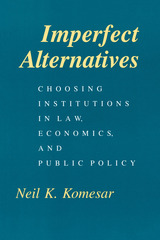 Imperfect Alternatives: Choosing Institutions in Law, Economics, and Public Policy
Neil K. Komesar
University of Chicago Press, 1994 Major approaches to law and public policy, ranging from law and economics to the fundamental rights approach to constitutional law, are based on the belief that the identification of the correct social goals or values is the key to describing or prescribing law and public policy outcomes. In this book, Neil Komesar argues that this emphasis on goal choice ignores an essential element—institutional choice. Indeed, as important as determining our social goals is deciding which institution is best equipped to implement them—the market, the political process, or the adjucative process.
Pointing out that all three institutions are massive, complex, and imperfect, Komesar develops a strategy for comparative institutional analysis that assesses variations in institutional ability. He then powerfully demonstrates the value of this analytical framework by using it to examine important contemporary issues ranging from tort reform to constitution-making.
 An Imperfect Book: What the Book of Mormon Tells Us about Itself
Earl M. Wunderli
Signature Books, 2013 My first impression in reading this text was that it was rightly named in its title. Indeed the author intends to lead the reader through an exploration of a book that he describes as an imperfect book, and does so in a way that enables the book to speak for itself. Given the fact that so many approach the Book of Mormon through lenses already adjusted to read the text for apologetic purposes, I found the author’s engagement of the Book of Mormon to be respectfully and critically refreshing. Feeling unable to rely on historians, archeologists, self-designated authorities, or others with sure knowledge of the Book of Mormon, the author turns to the book itself for what it might reveal about itself. Rather than turning to external evidences to vindicate the central claims of the Book of Mormon, the author invites the reader to explore internal evidences to be discovered in the book itself. He does this while engaging a broad range of contemporary scholarship.
Dale E. Luffman, Association for Mormon Letters
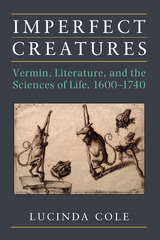 Imperfect Creatures: Vermin, Literature, and the Sciences of Life, 1600-1740
Lucinda Cole
University of Michigan Press, 2016 Lucinda Cole’s Imperfect Creatures offers the first full-length study of the shifting, unstable, but foundational status of “vermin” as creatures and category in the early modern literary, scientific, and political imagination. In the space between theology and an emergent empiricism, Cole’s argument engages a wide historical swath of canonical early modern literary texts—William Shakespeare’s Macbeth, Christopher Marlowe’s The Jew of Malta, Abraham Cowley’s The Plagues of Egypt, Thomas Shadwell’s The Virtuoso, the Earl of Rochester’s “A Ramble in St. James’s Park,” and Daniel Defoe’s Robinson Crusoe and Journal of the Plague Year—alongside other nonliterary primary sources and under-examined archival materials from the period, including treatises on animal trials, grain shortages, rabies, and comparative neuroanatomy.
As Cole illustrates, human health and demographic problems—notably those of feeding populations periodically stricken by hunger, disease, and famine—were tied to larger questions about food supplies, property laws, national identity, and the theological imperatives that underwrote humankind’s claim to dominion over the animal kingdom. In this context, Cole’s study indicates, so-called “vermin” occupied liminal spaces between subject and object, nature and animal, animal and the devil, the devil and disease—even reason and madness. This verminous discourse formed a foundational category used to carve out humankind’s relationship to an unpredictable, irrational natural world, but it evolved into a form for thinking about not merely animals but anything that threatened the health of the body politic—humans, animals, and even thoughts.
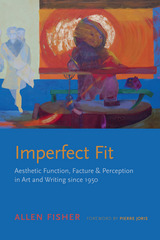 Imperfect Fit: Aesthetic Function, Facture, and Perception in Art and Writing since 1950
Allen Fisher
University of Alabama Press, 2016 Imperfect Fit: Aesthetic Function, Facture, and Perception in Art and Writing since 1950 is an expansive and incisive examination of the patterns of connectedness in contemporary art and poetry. Allen Fisher—a highly accomplished poet, painter, critic, and art historian as well as a key figure in the British poetry revival of the 1960s and 1970s—has a close and discerning connection to his subjects.
In Imperfect Fit, Fisher focuses on the role of fracturing, ruptures, and breakages in many traditional ties between art and poetry, as well as the resulting use of collage and assemblage by practitioners of those arts. Fisher addresses, among other subjects, destruction as a signifier in twentieth-century art; the poetic employment of bureaucratic vocabularies and “business speak”; and the roles of public performance and memory loss in the fashioning of human knowledge and art.
Commonplace notions of coherence, logic, and truth are reimagined and deconstructed in this study, and Fisher concludes by suggesting that contemporary culture offers a particularly robust opportunity—and even necessity—to engage in the production of art as a pragmatic act. Scholars of art, poetry, and aesthetics will be engaged and challenged by this insightful work.
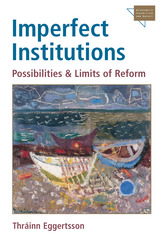 Imperfect Institutions: Possibilities and Limits of Reform
Thráinn Eggertsson
University of Michigan Press, 2005 The emergence of New Institutional Economics toward the end of the twentieth century profoundly changed our ideas about the organization of economic systems and their social and political foundations. Imperfect Institutions explores recent developments in this field and pushes the discussion forward by allowing for incomplete knowledge of social systems and unexpected system dynamics and, above all, by focusing explicitly on institutional policy. Empirical studies extending from Africa to Iceland are cited in support of the theoretical argument. In Imperfect Institutions Thráinn Eggertsson extends his attempt to integrate and develop the new field that began with his acclaimed Economic Behavior and Institutions (1990), which has been translated into six languages. This latest work analyzes why institutions that create relative economic backwardness emerge and persist and considers the possibilities and limits of institutional reform. Thráinn Eggertsson is Professor of Economics at the University of Iceland and Global Distinguished Professor of Politics at New York University. Previously published works include Economic Behavior and Institutions (1990) and Empirical Studies in Institutional Change with Lee Alston and Douglass North (1996).
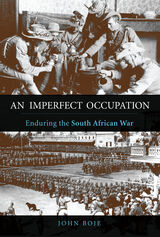 An Imperfect Occupation: Enduring the South African War
John Boje
University of Illinois Press, 2015 The South African War (1899–1902), also called the Boer War and Anglo-Boer War, began as a conventional conflict. It escalated into a savage irregular war fought between the two Boer republics and a British imperial force that adopted a scorched-earth policy and used concentration camps to break the will of Afrikaner patriots and Boer guerrillas. In An Imperfect Occupation , John Boje delves into the agonizing choices faced by Winburg district residents during the British occupation. Afrikaner men fought or evaded combat or collaborated; Afrikaner women fled over the veld or submitted to life in the camps; and black Africans weighed the life or death consequences of taking sides. Boje's sensitive analysis showcases the motives, actions, and reactions of Boers and Africans alike as initial British accommodation gave way to ruthlessness. Challenging notions of Boer unity and homogeneity, Boje illustrates the precarious tightrope of resistance, neutrality, and collaboration walked by people on all sides. He also reveals how the repercussions of the war's transformative effect on Afrikaner identity plays out in today's South Africa. Readable and compassionate, An Imperfect Occupation provides a dramatic account of the often overlooked aspects of one of the first "modern" wars.
Imperfect Present: Poems
Sharon Dolin
University of Pittsburgh Press, 2022 Imperfect Present is a book for our current moment. By confronting the urgencies of daily life, from questions of identity to sexual abuse to racial unrest to the ubiquity of plastic, these poems investigate ways to sustain ourselves in our fraught public and private lives. With her characteristic linguistic play, Sharon Dolin illuminates some of the most personal concerns that resonate throughout our culture and in ourselves, such as error, despair, uncertainty, and doubt. In sections that deploy the lens of art, the “Oblique Strategies” of Brian Eno and Peter Schmidt, and meditations on dreams and spirituality, Imperfect Present provides a panoply of approaches that grapple with the complexity of now.
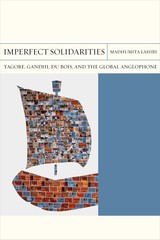 Imperfect Solidarities: Tagore, Gandhi, Du Bois, and the Global Anglophone
Madhumita Lahiri
Northwestern University Press, 2021 A century ago, activists confronting racism and colonialism—in India, South Africa, and Black America—used print media to connect with one another. Then, as now, the most effective medium for their undertakings was the English language. Imperfect Solidarities: Tagore, Gandhi, Du Bois, and the Global Anglophone tells the story of this interconnected Anglophone world. Through Rabindranath Tagore’s writings on China, Mahatma Gandhi’s recollections of South Africa, and W. E. B. Du Bois’s invocations of India, Madhumita Lahiri theorizes print internationalism. This methodology requires new terms within the worldwide hegemony of the English language (“the global Anglophone”) in order to encourage alternate geographies (such as the Global South) and new collectivities (such as people of color). The women of print internationalism feature prominently in this account. Sonja Schlesin, born in Moscow, worked with Indians in South Africa. Sister Nivedita, an Irish woman in India, collaborated with a Japanese historian. Jessie Redmon Fauset, an African American, brought the world home to young readers through her work as an author and editor. Reading across races and regions, genres and genders, Imperfect Solidarities demonstrates the utility of the neologism for postcolonial literary studies.
 Imperfection and Defeat: The Role of Aesthetic Imagination in Human Society
Virgil Nemoianu
Central European University Press, 2006 Literature is defined in a challenging way as the "science" of imperfection and defeat, or else as a type of discourse that deals with defeat, loss, uncertainty in social life, by contrast with virtually all disciplines (hard sciences or social sciences) that affirm certainties and wish to convince us of truths. If in real history most constructive attempts end up in failure, it follows that we ought to have also a field of research that examines this diversity of failures and disappointments, as well as the alternative options to historical evolution and progress. Thus literature serves an indispensable role: that of gleaning the abundance of past existence, the gratuitous and the rejected being placed here on an equal level with the useful and the successful.This provocative and unusual approach is illustrated in chapters that deal with the dialectics between literary writing and such fields as historical writing, or religious discourses, and is also illustrated by the socio-historical development of East-Central Europe.
Imperial
George Bilgere
University of Pittsburgh Press, 2014 In Imperial, George Bilgere’s sixth collection of poetry, he continues his exploration of the beauties, mysteries, and absurdities of being middle-aged and middle-class in mid-America. In poems that range from the Cold War anxieties of the 1950s to the perils and predicaments of an aging Boomer in a post-9/11 world, Bilgere’s rueful humor and slippery syntax become a trapdoor that at any moment can plunge the reader into the abyss. In Bilgere’s world a yo-yo morphs into an emblem for the atomic bomb. A spot of cancer flames into the Vietnam War. And the death of a baseball player reminds us, in this age of disbelief, of the importance—the necessity—of myth.
Imperial Affects: Sensational Melodrama and the Attractions of American Cinema
Eagle, Jonna
Rutgers University Press, 2017 Imperial Affects is the first sustained account of American action-based cinema as melodrama. From the earliest war films through the Hollywood Western and the late-century action cinema, imperialist violence and mobility have been produced as sites of both visceral pleasure and moral virtue. Suffering and omnipotence operate as twinned affects in this context, inviting identification with an American national subject constituted as both victimized and invincible—a powerful and persistent conjunction traced here across a century of cinema.
Imperial and Royal Child Brides in Byzantium and Beyond
Cecily Hennessy
Arc Humanities Press, 2025 This book focuses on the Byzantine court in Constantinople and the young females (aged fourteen or younger) who married into the royal and imperial households of Byzantium and medieval Europe to eventually become queens or empresses. Some married within their own culture, while many travelled hundreds of miles from their homes to encounter new customs, languages, and sometimes religion. Covering the period from the tenth to the fifteenth centuries, this survey addresses a range of neglected areas of study: the crucial importance of children in society in general; the key responsibilities laid on girls and the vital roles of female children in building alliances; and the promotion of political and religious agendas. It addresses both history and art, with evidence drawn from historical sources, religious foundations, manuscripts, wall paintings, ivories, and metalwork.
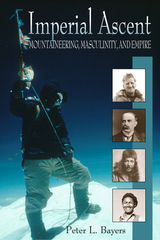 Imperial Ascent: Masculinity, Mountaineering, and Empire
Peter L. Bayers
University Press of Colorado, 2003 The thrills and chills of mountaineering literature have long attracted a devoted audience of serious climbers, adventure-seekers, and armchair enthusiasts. In recent decades, scholars have come to view these tales of prowess and fortitude as texts laden with ideological meaning. In Imperial Ascent, a comparative study of seven such twentieth-century mountaineering narratives, Peter L. Bayers articulates the multiple and varied ways mountaineering and its literature have played in the formation and maintenance of national identity. By examining such works as Belmore Browne's The Conquest of Mount McKinley and Sir John Hunt's The Ascent of Everest, Bayers contends that for American and British climbers, mountaineering is tied to imperial ideology and dominant notions of masculinity. At the same time, he demonstrates how Tiger of the Snows,, Sherpa Tenzing Norgay's account of climbing Mount Everest, undermines Western conceptions of mountaineering and imperialism. Throughout this theoretically informed critique, Bayers manages to retain the sense of awe and adventure inherent in the original works, making Imperial Ascent a highly engaging read.
 Imperial Bibles, Domestic Bodies: Women, Sexuality, and Religion in the Victorian Market
Mary Wilson Carpenter
Ohio University Press, 2003 Of the many literary phenomena that sprang up in eighteenth-century England and later became a staple of Victorian culture, one that has received little attention until now is the “Family Bible with Notes.” Published in serial parts to make it affordable, the Family Bible was designed to enhance the family’s status and sense of national and imperial identity. Imperial Bibles, Domestic Bodies reveals in its study of the production and consumption of British commercial Family Bibles startling changes in “family values.” Advertised in the eighteenth century as providing the family with access to “universal knowledge,” these Bibles suddenly shifted in the early nineteenth century to Bibles with bracketed sections marked “to be omitted from family reading” and reserved for reading “in the closet” by the “Master of the family.” These disciplinary Bibles were paralleled by Family Bibles designed to appeal to the newly important female consumer. Illustrations featured saintly women and charming children, and “family registers” with vignettes of family life emphasized the prominent role of the “angel in the house.” As Mary Wilson Carpenter documents in Imperial Bibles, Domestic Bodies, the elaborate notes and “elegant engravings” in these Bibles bring to light a wealth of detail about the English commonsense view of such taboo subjects as same-sex relations, masturbation, menstruation, and circumcision. Her reading of literary texts by Charlotte Brontë, George Eliot, and Elizabeth Barrett Browning in the context of these commercial representations of the “Authorized Version” or King James translation of the Bible indicates that when the Victorians spoke about religion, they were also frequently speaking about sex.
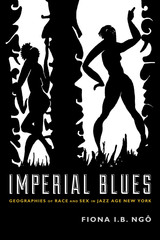 Imperial Blues: Geographies of Race and Sex in Jazz Age New York
Fiona I. B. Ngô
Duke University Press, 2013 In this pathbreaking study, Fiona I. B. Ngô examines how geographies of U.S. empire were perceived and enacted during the 1920s and 1930s. Focusing on New York during the height of the Harlem Renaissance, Ngô traces the city's multiple circuits of jazz music and culture. In considering this cosmopolitan milieu, where immigrants from the Philippines, Cuba, Puerto Rico, Mexico, Japan, and China crossed paths with blacks and white "slummers" in dancehalls and speakeasies, she investigates imperialism's profound impact on racial, gendered, and sexual formations. As nightclubs overflowed with the sights and sounds of distant continents, tropical islands, and exotic bodies, tropes of empire provided both artistic possibilities and policing rationales. These renderings naturalized empire and justified expansion, while establishing transnational modes of social control within and outside the imperial city. Ultimately, Ngô argues that domestic structures of race and sex during the 1920s and 1930s cannot be understood apart from the imperial ambitions of the United States.
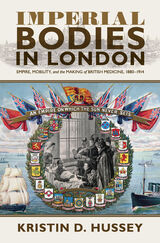 Imperial Bodies in London: Empire, Mobility, and the Making of British Medicine, 1880–1914
Kristin Hussey
University of Pittsburgh Press, 2021 Winner, 2022 Whitfield Prize for First Monograph in the Field of British and Irish History
Since the eighteenth century, European administrators and officers, military men, soldiers, missionaries, doctors, wives, and servants moved back and forth between Britain and its growing imperial territories. The introduction of steam-powered vessels, and deep-docks to accommodate them at London ports, significantly reduced travel time for colonists and imperial servants traveling home to see their families, enjoy a period of study leave, or recuperate from the tropical climate. With their minds enervated by the sun, livers disrupted by the heat, and blood teeming with parasites, these patients brought the empire home and, in doing so, transformed medicine in Britain. With Imperial Bodies in London, Kristin D. Hussey offers a postcolonial history of medicine in London. Following mobile tropical bodies, her book challenges the idea of a uniquely domestic medical practice, arguing instead that British medicine was imperial medicine in the late Victorian era. Using the analytic tools of geography, she interrogates sites of encounter across the imperial metropolis to explore how medical research and practice were transformed and remade at the crossroads of empire.
 Imperial Borderland: Bobrikov and the Attempted Russification of Finland, 1898–1904
Tuomo Polvinen
Duke University Press, 1995 In 1904 the Russian Governor-General in Helsinki, Nikolai Ivanovich Bobrikov, was assassinated by a Finnish nationalist. In this study by Finland’s leading diplomatic historian, Tuomo Polvinen examines the tense and troubled relationship of Finland to the tsarist empire and the nature of Russian nationality policy at the turn of the century.
Bobrikov’s appointment to the Grand Duchy of Finland in 1898 by Nicholas II led to a policy of intensified Russification that ended nearly a century of political equilibrium between the two states. With access to previously unavailable Russian archival material, Polvinen provides a uniquely balanced and informed view of this dramatic new phase in Russian-Finnish relations. Presenting Bobrikov in the overall context of Russian policy toward Finland, Polvinen investigates such issues as Bobrikov’s goals for Finland, the effect of Russian politics on its Finnish policy, and the influence of Russian journalists during this crucial period.
Offering insight into the workings of the Russian government and its borderland policy during a time of rising international tension, Imperial Borderland will attract readers of Baltic, Finnish, Russian, and Scandinavian history. Those with an interest in the continuing importance of nationalism and nationalities policy in this region of the world will also find this book valuable.
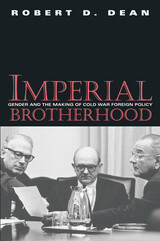 Imperial Brotherhood: Gender and the Making of Cold War Foreign Policy
Robert D. Dean
University of Massachusetts Press, 2001 This provocative book begins with a question about the Vietnam War. How is it, asks Robert D. Dean, that American policymakers—men who prided themselves on "hardheaded pragmatism" and shunned "fuzzy idealism"—could have committed the nation to such a ruinous, costly, and protracted war? The answer, he argues, lies not simply in the imperatives of anticommunist ideology or in any reasonable calculation of national interest. At least as decisive in determining the form and content of American Cold War foreign policy were the common background and shared values of its makers, especially their deeply ingrained sense of upper-class masculinity.
Dean begins by examining the institutions that shaped the members of the U.S. foreign policy establishment—all-male prep schools, Ivy League universities, collegiate secret societies, and exclusive men's clubs—that instilled stoic ideals of competition, duty, and loyalty. Service in elite military units during World War II further reinforced this pattern of socialization, eventually creating an "imperial brotherhood" imbued with a common global vision. More than that, according to Dean, the commitment to tough-minded masculinity shared by these men encouraged the pursuit of policies that were aggressively interventionist abroad and intolerant of dissent at home.
Applying his gendered analysis to the McCarthy era, Dean reveals how the purge of suspected homosexuals in the State Department not only paralleled the repression of the political left, but also reflected a bitter contest for power between the foreign policy elite and provincial Congressional conservatives. He then shows how issues of manliness similarly influenced the politics and policies of the Kennedy and Johnson administrations. Just as programs like the Peace Corps were grounded in ideals of masculine heroism, decisions about intervention in Vietnam were inextricably bound up with ideas about male strength and power. In the end, Dean makes a persuasive case that these elite constructions of male identity fundamentally shaped the course of American foreign policy during the early decades of the Cold War.
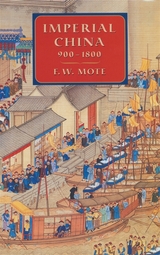 Imperial China, 900–1800
F. W. Mote
Harvard University Press, 2000 This is a history of China for the 900-year time span of the late imperial period. A senior scholar of this epoch, F. W. Mote highlights the personal characteristics of the rulers and dynasties and probes the cultural theme of Chinese adaptations to recurrent alien rule. No other work provides a similar synthesis: generational events, personalities, and the spirit of the age combine to yield a comprehensive history of the civilization, not isolated but shaped by its relation to outsiders.
This vast panorama of the civilization of the largest society in human history reveals much about Chinese high and low culture, and the influential role of Confucian philosophical and social ideals. Throughout the Liao Empire, the world of the Song, the Mongol rule, and the early Qing through the Kangxi and Qianlong reigns, culture, ideas, and personalities are richly woven into the fabric of the political order and institutions. This is a monumental work that will stand among the classic accounts of the nature and vibrancy of Chinese civilization before the modern period.
The Imperial City of Cologne: From Roman Colony to Medieval Metropolis (19 B.C.-1125 A.D.)
Joseph Huffman
Amsterdam University Press, 2018 The Imperial City of Cologne: From Roman Colony to Medieval Metropolis (19 B.C.-1125 A.D.) is an urban history of Cologne from its imperial Roman origins as a northeastern frontier military outpost to a medieval metropolis on the German Empire’s northwestern border. This first history of Cologne, available in English, challenges received notions of late Roman ethnic identities, a Dark Age collapse of urban life, devastating Viking and Magyar incursions, and the origins of medieval urban government.
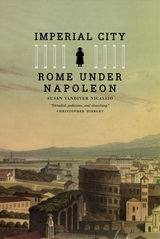 Imperial City: Rome under Napoleon
Susan Vandiver Nicassio
University of Chicago Press, 2009 In 1798, the armies of the French Revolution tried to transform Rome from the capital of the Papal States to a Jacobin Republic. For the next two decades, Rome was the subject of power struggles between the forces of the Empire and the Papacy, while Romans endured the unsuccessful efforts of Napoleon’s best and brightest to pull the ancient city into the modern world. Against this historical backdrop, Nicassio weaves together an absorbing social, cultural, and political history of Rome and its people. Based on primary sources and incorporating two centuries of Italian, French, and international research, her work reveals what life was like for Romans in the age of Napoleon.
“A remarkable book that wonderfully vivifies an understudied era in the history of Rome. . . . This book will engage anyone interested in early modern cities, the relationship between religion and daily life, and the history of the city of Rome.”—Journal of Modern History
“An engaging account of Tosca’s Rome. . . . Nicassio provides a fluent introduction to her subject.”—History Today
“Meticulously researched, drawing on a host of original manuscripts, memoirs, personal letters, and secondary sources, enabling [Nicassio] to bring her story to life.”—History
 Imperial Creatures: Humans and Other Animals in Colonial Singapore, 1819-1942
Timothy P. Barnard
National University of Singapore Press, 2019 One of the areas of fastest-growing interest in the humanities and social sciences in recent years has been the history of animals. Imperial Creatures fills a gap in that field by looking across species at animals in a urban colonial setting. If imperialism is a series of power relationships, Timothy P. Barnard argues, then it necessarily involves not only the subjugation of human communities, but also of animals. What was the relationship between those two processes in colonial Singapore? How did interactions with animals enable changes in interactions between people?
Through a multidisciplinary consideration of fauna, Imperial Creatures weaves together a series of tales to document how animals were cherished, monitored, employed, and slaughtered in a colonial society. All animals, including humans, Barnard shows, have been creatures of imperialism in Singapore. Their stories teach us lessons about the structures that upheld such a society and how it developed over time, lessons of relevance to animal historians, to historians of Singapore, and to urban historians and imperial historians with an interest in environmental themes.
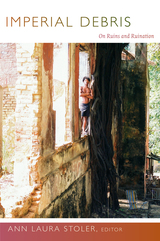 Imperial Debris: On Ruins and Ruination
Ann Laura Stoler, ed.
Duke University Press, 2013 Imperial Debris redirects critical focus from ruins as evidence of the past to "ruination" as the processes through which imperial power occupies the present. Ann Laura Stoler's introduction is a manifesto, a compelling call for postcolonial studies to expand its analytical scope to address the toxic but less perceptible corrosions and violent accruals of colonial aftermaths, as well as their durable traces on the material environment and people's bodies and minds. In their provocative, tightly focused responses to Stoler, the contributors explore subjects as seemingly diverse as villages submerged during the building of a massive dam in southern India, Palestinian children taught to envision and document ancestral homes razed by the Israeli military, and survival on the toxic edges of oil refineries and amid the remains of apartheid in Durban, South Africa. They consider the significance of Cold War imagery of a United States decimated by nuclear blast, perceptions of a swath of Argentina's Gran Chaco as a barbarous void, and the enduring resonance, in contemporary sexual violence, of atrocities in King Leopold's Congo. Reflecting on the physical destruction of Sri Lanka, on Detroit as a colonial metropole in relation to sites of ruination in the Amazon, and on interactions near a UNESCO World Heritage Site in the Brazilian state of Bahia, the contributors attend to present-day harms in the occluded, unexpected sites and situations where earlier imperial formations persist.
Contributors. Ariella Azoulay, John F. Collins, Sharad Chari, E. Valentine Daniel, Gastón Gordillo, Greg Grandin, Nancy Rose Hunt, Joseph Masco, Vyjayanthi Venuturupalli Rao, Ann Laura Stoler
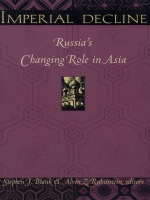 Imperial Decline: Russia’s Changing Role in Asia
Stephen J. Blank and Alvin Z. Rubinstein, eds.
Duke University Press, 1997 This collection of essays by a distinguished group of international scholars is the first to analyze current Russian policies in China, Japan, and the two Koreas. Although Russia was a rising power in Asia a century ago, historical and political events since then have diverted attention from this potential site of development. The essays in Imperial Decline describe the major changes that have occurred in Russia’s relations with China, Japan, and South Korea under Boris Yeltin’s presidency, speculating about both Russia’s future in the region and the impact this future could have on relations with the United States. Contributors to this volume demonstrate how incoherent taxation and investment, uncoordinated and contradictory economic policies, runaway inflation and currency instability, and problems of defense now constrain the possibility of Russia expanding its economic influence in the region. This book is essential for students and scholars of international relations, foreign policy, and Russian history. Contributors. Stephen J. Blank, Bruce A. Elleman, Harry Gelman, Hongchan Chun , Rajan Menon, Alvin Z. Rubinstein, Oles M. Smolansky, Henry Trofimenko, Charles E. Ziegler
 Imperial Designs, Postimperial Extremes: Studies in Interdisciplinary and Comparative History of Russia and Eastern Europe
Andrei Cusco
Central European University Press, 2023 Anchored in the Russian Empire, but not limited to it, the eight studies in this volume explore the nineteenth-century imperial responses to the challenge of modernity, the dramatic disruptions of World War I, the radical scenarios of the interwar period and post-communist endgames at the different edges of Eurasia. The book continues and amplifies the historiographic momentum created by Alfred J. Rieber’s long and fruitful scholarly career. First, the volume addresses the attempts of Russian imperial rulers and elites to overcome the economic backwardness of the empire with respect to the West. The ensuing rivalry of several interest groups (entrepreneurs, engineers, economists) created new social forms in the subsequent rounds of modernization. The studies explore the dynamics of the metamorphoses of what Rieber famously conceptualized as a “sedimentary society” in the pre-revolutionary and early Soviet settings. Second, the volume also expands and dwells on the concept of frontier zones as dynamic, mutable, shifting areas, characterized by multi-ethnicity, religious diversity, unstable loyalties, overlapping and contradictory models of governance, and an uneasy balance between peaceful co-existence and bloody military clashes. In this connection, studies pay special attention to forced and spontaneous migrations, and population politics in modern Eurasia.
 Imperial Desire: Dissident Sexualities And Colonial Literature
Philip Holden
University of Minnesota Press, 2003 Illuminates the intersections between colonial thought and homosexuality An exploration of the intersection of colonialism and homosexuality in fiction and travel writing from Robinson Crusoe to the present, this volume brings together two dynamic fields of academic inquiry: colonial discourse analysis, which considers literary texts as expressions of colonial power; and queer theory, which interrogates the representation, enforcement, and subversions of sexualities in literature and culture. These writers reexamine the work of Kipling, Conrad, Forster, Lessing, and others, ranging from male adventure stories to postcolonial novels. This volume will provoke and inform readers concerned with gender and sexuality, colonial history and literature, or with any of the works and authors revisited—and reexperienced—here. Contributors: Anjali Arondekar, U of California, Santa Cruz; John C. Beynon, California State U, Fresno; Joseph A. Boone, USC; Sarah Cole, Columbia U; Lois Cucullu, U of Minnesota; Maria Davidis, Cornell; Dennis Denisoff, Ryerson U; Mark Forrester, U of Maryland; Terry Goldie, York U; Christopher Lane, Northwestern U; Tim Middleton, Bath Spa U College, UK; Hans Turley, U of Connecticut.
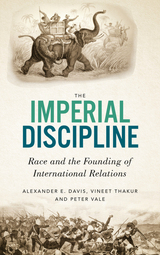 The Imperial Discipline: Race and the Founding of International Relations
Alexander E Davis
Pluto Press, 2021 This book questions the accepted origins of the field of International Relations (IR). Commonly understood to have emerged from the horrors of WW1 with the goal of bringing about world peace, the authors argue that on the contrary, IR came from a somewhat less noble tradition – that of the Round Table. The Round Table were a network of imperialists emerging in the late 1800s across five key British imperial societies: Australia, Canada, New Zealand, South Africa and India. Their aim was to improve imperial governance, placing the empire into a position to control world affairs. Although they ultimately failed to rearrange world order according to their vision, they did help to build what we now call the discipline of IR. The Round Table's 'scientific method' for the study of world affairs was rapidly subsumed into each geopolitical context. Through telling this story, the authors recover it, and interrogate its meanings for the discipline of IR today. They show the importance of the Global South to IR's foundations, and argue that IR scholarship in this period was intertwined with imperial racial thought in ways that it should not and cannot forget.
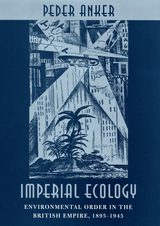 Imperial Ecology: Environmental Order in the British Empire, 1895-1945
Peder Anker
Harvard University Press, 2001 From 1895 to the founding of the United Nations in 1945, the promising new science of ecology flourished in the British Empire. Peder Anker asks why ecology expanded so rapidly and how a handful of influential scientists and politicians established a tripartite ecology of nature, knowledge, and society.
Patrons in the northern and southern extremes of the Empire, he argues, urgently needed tools for understanding environmental history as well as human relations to nature and society in order to set policies for the management of natural resources and to effect social control of natives and white settlement. Holists such as Jan Christian Smuts and mechanists such as Arthur George Tansley vied for the right to control and carry out ecological research throughout the British Empire and to lay a foundation of economic and social policy that extended from Spitsbergen to Cape Town.
The enlargement of the field from botany to human ecology required a broader methodological base, and ecologists drew especially on psychology and economy. They incorporated those methodologies and created a new ecological order for environmental, economic, and social management of the Empire.
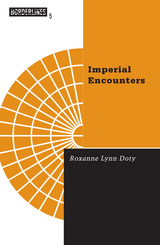 Imperial Encounters: The Politics of Representation in North-South Relations
Roxanne Doty
University of Minnesota Press, 1996 Offers a fresh perspective on power relationships in global politics. “Developed/underdeveloped,” “first world/third world,” “modern/traditional”-although there is nothing inevitable, natural, or arguably even useful about such divisions, they are widely accepted as legitimate ways to categorize regions and peoples of the world. In Imperial Encounters, Roxanne Lynn Doty looks at the way these kinds of labels influence North-South relations, reflecting a history of colonialism and shaping the way national identity is constructed today. Employing a critical, poststructuralist perspective, Doty examines two “imperial encounters” over time: between the United States and the Philippines and between Great Britain and Kenya. The history of these two relationships demonstrates that not only is the more powerful member allowed to construct “reality,” but this construction of reality bears an important relationship to actual practice. Doty is particularly interested in the way in which the South has been represented by policymakers, scholars, and journalists, and how these representations have influenced specific encounters. Doty also uses the insights of Edward Said to argue that the power dynamic that allows the North to define the global identity of nations in the South ultimately tells us more about northern powers than about their southern neighbors. Doty then considers the persistence of representational practices, particularly with regard to Northern views of human rights in the South and contemporary social science discourses on North-South relations. She ends with the argument that the discipline of international relations needs to be reformed by broadening the repertoire of theoretical and analytical tools available to scholars studying global politics. Important and timely, Imperial Encounters brings a fresh perspective to the debate over the past-and the future-of global politics.
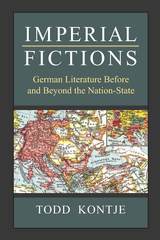 Imperial Fictions: German Literature Before and Beyond the Nation-State
Todd Kontje
University of Michigan Press, 2018 Imperial Fictions explores ways in which writers from late antiquity to the present have imagined communities before and beyond the nation-state. It takes as its point of departure challenges to the discrete nation-state posed by globalization, migration, and European integration today, but then circles back to the beginnings of European history after the fall of the Roman Empire. Unlike nationalist literary historians of the nineteenth century, who sought the tribal roots of an allegedly homogeneous people, this study finds a distant mirror of analogous processes today in the fluid mixtures and movements of peoples. Imperial Fictions argues that it is time to stop thinking about today’s multicultural present as a deviation from a culturally monolithic past. We should rather consider the various permutations of “German” identities that have been negotiated within local and imperial contexts from the early Middle Ages to the present.
Imperial Geographies in Byzantine and Ottoman Space
Sahar Bazzaz
Harvard University Press, 2012 Imperial Geographies in Byzantine and Ottoman Space opens new and insightful vistas on the nexus between empire and geography. The volume redirects attention from the Atlantic to the space of the eastern Mediterranean shaped by two empires of remarkable duration and territorial extent, the Byzantine and the Ottoman. The essays offer a diachronic and comparative account that spans the medieval and early modern periods and reaches into the nineteenth century. Methodologically rich, the essays combine historical, literary, and theoretical perspectives. Through texts as diverse as court records and chancery manuals, imperial treatises and fictional works, travel literature and theatrical adaptations, the essays explore ways in which the production of geographical knowledge supported imperial authority or revealed its precarious mastery of geography.
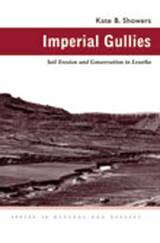 Imperial Gullies: Soil Erosion and Conservation in Lesotho
Kate B. Showers
Ohio University Press, 2005 Once the grain basket for South Africa, much of Lesotho has become a scarred and degraded landscape. The nation’s spectacular erosion and gullying have concerned environmentalists and conservationists for more than half a century. In Imperial Gullies: Soil Erosion and Conservation in Lesotho, Kate B. Showers documents the truth behind this devastation. Showers reconstructs the history of the landscape, beginning with a history of the soil. She concludes that Lesotho’s distinctive erosion chasms, called dongas—often cited as an example of destructive land-use practices by African farmers—actually were caused by colonial and postcolonial interventions. The residents of Lesotho emerge as victims of a failed technology. Their efforts to mitigate or resist implementation of destructive soil conservation engineering works were thwarted, and they were blamed for the consequences of policies promoted by international soil conservationists since the 1930s. Imperial Gullies calls for an observational, experimental, and, most important, a fully consultative and participatory approach to address Lesotho’s serious contemporary problems of soil erosion. The first book to bring to center stage the historical practice of colonial soil science—and a cautionary tale of western science in unfamiliar terrain—it will interest a broad, interdisciplinary audience in African and environmental studies, social sciences, and history.
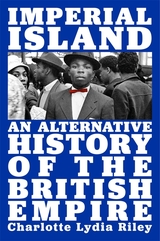 Imperial Island: An Alternative History of the British Empire
Charlotte Lydia Riley
Harvard University Press, 2024 This riveting new history tells the story of Britain’s journey from imperial power to a nation divided—one that alternately welcomes and excludes former imperial subjects and has been utterly transformed by them.
In the turbulent years since the outbreak of World War II, Britain has gone from an imperial power whose dominion extended over a quarter of the world’s population to an island nation divorced from Europe. After the war, as independence movements gained momentum, former imperial subjects started making their way to her soggy shores. Would these men and women of different races, cultures, and faiths be accepted as British, or would they forever be seen as outsiders? In this deeply intimate retelling of the United Kingdom’s transformation from empire to island nation, Charlotte Lydia Riley shows that empire haunts every aspect of life in modern Britain.
From race riots to the Notting Hill Carnival, from the Suez Crisis to the wars in Iraq and Afghanistan, from the Monday Club and Enoch Powell’s defiant calls to protect England’s racial purity to Band Aid, the Spice Girls, and Brick Lane, the imperial mindset has dominated Britain’s relationship with itself and the world. The ghosts of empire are to be found, too, in anti-immigrant rhetoric and royal memorabilia, in the pitched battles over how history should be taught in schools—and, of course, in Brexit.
Drawing on a mass of original research to capture the thoughts and feelings of ordinary British citizens, Imperial Island tells a story of people on the move and of people trapped in the past, of the end of empire and the birth of multiculturalism, a chronicle of violence and exclusion but also a testament to community. It is the story that best explains Britain today.
 Imperial Israel and the Palestinians: The Politics of Expansion
Nur Masalha
Pluto Press, 2000 This book is a history of Israel's expansionist policies, focusing on the period from the June War of 1967 to the present day. He demonstrates that imperialist tendencies in Israel run the political gamut, from Left to Right.
Masalha argues that the heart of the conflict between Zionist immigrants/settlers and the native Palestinians has always been about land, territory, demography and water. He documents how Israeli policy has made it a priority to expel the Palestinians, either by war or peaceful measures. But these imperialist tendencies are not restricted to extremist zealots. The author uncovers the expansionist policies found in Labour Zionism and Kookist ideology.
Chapters cover the Whole Land of Israel Movement, Zionist Revisionism and the Likud Party, Gush Emunim and the religious fundamentalists, parties and movements of the far right and the evolution of Israeli Jewish public attitudes since 1967.
Imperial Liquor: Poems
Amaud Johnson
University of Pittsburgh Press, 2020
Finalist, 2020 National Book Critics Circle Award
Finalist, 2021 Rilke Prize
Imperial Liquor is a chronicle of melancholy, a reaction to the monotony of racism. These poems concern loneliness, fear, fatigue, rage, and love; they hold fatherhood held against the vulnerability of the black male body, aging, and urban decay. Part remembrance, part swan song for the Compton, California of the 1980s, Johnson examines the limitations of romance to heal broken relationships or rebuild a broken city. Slow Jams, red-lit rooms, cheap liquor, like seduction and betrayal—what’s more American? This book tracks echoes, rides the residue of music “after the love is gone.”
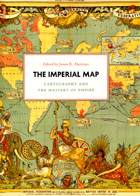 The Imperial Map: Cartography and the Mastery of Empire
Edited by James R. Akerman
University of Chicago Press, 2009 Maps from virtually every culture and period—from Babylonian world maps to Saul Steinberg’s famous New Yorker cover illustration, “View of the World from 9th Avenue”—convey our tendency to see our communities as the center of the world (if not the universe) and, by implication, as superior to anything beyond these immediate boundaries. Mapping has long been a tool by which ruling bodies could claim their entitlement to lands and peoples. It is this aspect of cartography that James R. Akerman and a group of distinguished contributors address in The Imperial Map.
Critically reflecting on elements of mapping and imperialism from the late seventeenth century to the early twentieth century, the essays discuss the nature of the imperial map through a series of case studies of empires, from the Qing dynasty of China, to the Portuguese empire in South America, to American imperial pretensions in the Pacific Ocean, among others. Collectively, the essays reveal that the relationship between mapping and imperialism, as well as the practice of political and economic domination of weak polities by stronger ones, is a rich and complex historical theme that continues to resonate in our modern day.
Imperial Material: National Symbols in the US Colonial Empire
Alvita Akiboh
University of Chicago Press, 2023 An ambitious history of flags, stamps, and currency—and the role they played in US imperialism.
In Imperial Material, Alvita Akiboh reveals how US national identity has been created, challenged, and transformed through embodiments of empire found in US territories, from the US dollar bill to the fifty-star flag. These symbolic objects encode the relationships between territories—including the Philippines, the Hawaiian Islands, Puerto Rico, and Guam—and the empire with which they have been entangled. Akiboh shows how such items became objects of local power, their original intent transmogrified. For even if imperial territories were not always front and center for federal lawmakers and administrators, their inhabitants remained continuously aware of the imperial United States, whose presence announced itself on every bit of currency, every stamp, and the local flag.
 Imperial Media: Colonial Networks and Information Technologies in the British Literary Imagination, 1857–1918
Aaron Worth
Ohio State University Press, 2014 Imperial Media: Colonial Networks and Information Technologies in the British Literary Imagination, 1857–1918 brings together two of the most dynamic and productive approaches to the study of nineteenth-century literature in recent years—media studies and colonial studies—to illuminate the rich and enduring symbiosis that developed between information technologies and Empire. Over a century before Facebook and the iPhone, Britons relied on the electric media of their day for information about their global empire—but those media, which during Victoria’s reign stretched out its tentacles to form a true “world wide web,” not only delivered information but provided conceptual frames as well, helping to shape the way their users thought. Ranging in space from the telegraph offices of Kipling’s India to the wireless transmitter on H.G. Wells’s Africanized moon, and in time from the Sepoy Rebellion to the Great War, Imperial Media reveals the extent to which British conceptions of imperial power were inflected by the new media of the nineteenth century: the telegraph, telephone, phonograph, radio, and cinema. While focusing on the fiction of Kipling, Wells, Marie Corelli, H. Rider Haggard, and John Buchan (“the last Victorian,” in Gertrude Himmelfarb’s phrase), Aaron Worth also argues that the “imperial media” of the Victorians retain much of their imaginative life and power today, informing such popular entertainments of the twenty-first century as Bollywood cinema and the BBC’s science-fiction franchise Torchwood. This is a vital, engaging study that will shape future discussions of both colonial and information systems, as well as the relationship between the two, in Victorian studies and elsewhere.
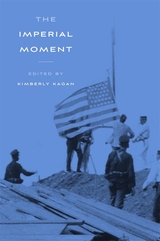 The Imperial Moment
Kimberly Kagan
Harvard University Press, 2010 In a provocative study on comparative empire, noted historians identify periods of transition across history that reveal how and why empires emerge. Loren J. Samons on Athens and Arthur Eckstein on Rome examine classical Western empires. Nicholas Canny discusses the British experience, Paul Bushkovitch analyzes the case of imperial Russia, and Pamela Kyle Crossley studies Qing China’s beginnings. Frank Ninkovich tackles the actions of the United States at the turn of the twentieth century, which many view as imperial behavior.
What were the critical characteristics that distinguished the imperial period of the state from its pre-imperial period? When did the state develop those characteristics sufficiently to be called an empire? The authors indicate the domestic political, social, economic, or military institutions that made empire formation possible and address how intentional the transition to empire was. They investigate the actions that drove imperial consolidation and consider the international environment in which the empire formed. Kimberly Kagan provides a concluding essay that probes the historical cases for insights into policymaking and the nature of imperial power.
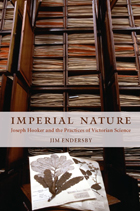 Imperial Nature: Joseph Hooker and the Practices of Victorian Science
Jim Endersby
University of Chicago Press, 2008 Joseph Dalton Hooker (1817–1911) was an internationally renowned botanist, a close friend and early supporter of Charles Darwin, and one of the first—and most successful—British men of science to become a full-time professional. He was also, Jim Endersby argues, the perfect embodiment of Victorian science. A vivid picture of the complex interrelationships of scientific work and scientific ideas, Imperial Nature gracefully uses one individual’s career to illustrate the changing world of science in the Victorian era.
By analyzing Hooker’s career, Endersby offers vivid insights into the everyday activities of nineteenth-century naturalists, considering matters as diverse as botanical illustration and microscopy, classification, and specimen transportation and storage, to reveal what they actually did, how they earned a living, and what drove their scientific theories. What emerges is a rare glimpse of Victorian scientific practices in action. By focusing on science’s material practices and one of its foremost practitioners, Endersby ably links concerns about empire, professionalism, and philosophical practices to the forging of a nineteenth-century scientific identity.
 An Imperial Path to Modernity: Yoshino Sakuzō and a New Liberal Order in East Asia, 1905–1937
Jung-Sun N. Han
Harvard University Press, 2013 An Imperial Path to Modernity examines the role of liberal intellectuals in reshaping transnational ideas and internationalist aspirations into national values and imperial ambitions in early twentieth-century Japan. Perceiving the relationship between liberalism and the international world order, a cohort of Japanese thinkers conformed to liberal ideas and institutions to direct Japan’s transformation into a liberal empire in Asia. To sustain and rationalize the imperial enterprise, these Japanese liberals sought to make the domestic political stage less hostile to liberalism. Facilitating the creation of print-mediated public opinion, liberal intellectuals attempted to enlist the new middle class as a social ally in circulating liberal ideas and practices within Japan and throughout the empire.
In tracing the interconnections between liberalism and the imperial project, Jung-Sun N. Han focuses on the ideas and activities of Yoshino Sakuzo (1878–1933), who was and is remembered as a champion of prewar Japanese liberalism and Taisho democracy. Drawing insights from intellectual history, cultural studies, and international relations, this study argues that prewar Japanese liberalism grew out of the efforts of intellectuals such as Yoshino who worked to devise a transnational institution to govern the Japanese empire.
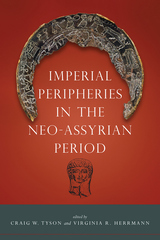 Imperial Peripheries in the Neo-Assyrian Period
Craig W. Tyson
University Press of Colorado, 2018 Though the Neo-Assyrian Empire has largely been conceived of as the main actor in relations between its core and periphery, recent work on the empire’s peripheries has encouraged archaeologists and historians to consider dynamic models of interaction between Assyria and the polities surrounding it. Imperial Peripheries in the Neo-Assyrian Period focuses on the variability of imperial strategies and local responses to Assyrian power across time and space.
An international team of archaeologists and historians draws upon both new and existing evidence from excavations, surveys, texts, and material culture to highlight the strategies that the Neo-Assyrian Empire applied to manage its diverse and widespread empire as well as the mixed reception of those strategies by subjects close to and far from the center. Case studies from around the ancient Near East illustrate a remarkable variety of responses to Assyrian aggression, economic policies, and cultural influences. As a whole, the volume demonstrates both the destructive and constructive roles of empire, including unintended effects of imperialism on socioeconomic and cultural change.
Imperial Peripheries in the Neo-Assyrian Period aligns with the recent movement in imperial studies to replace global, top-down materialist models with theories of contingency, local agency, and bottom-up processes. Such approaches bring to the foreground the reality that the development and lifecycles of empires in general, and the Neo-Assyrian Empire in particular, cannot be completely explained by the activities of the core. The book will be welcomed by archaeologists of the Ancient Near East, Assyriologists, and scholars concerned with empires and imperial power in history.
Contributors: Stephanie H. Brown, Anna Cannavò, Megan Cifarelli, Erin Darby, Bleda S. Düring, Avraham Faust, Guido Guarducci, Bradley J. Parker
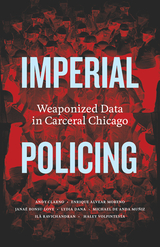 Imperial Policing: Weaponized Data in Carceral Chicago
Andy Clarno
University of Minnesota Press, 2024 Exposing the carceral webs and weaponized data that shape Chicago’s police wars
Chicago is a city with extreme concentrations of racialized poverty and inequity, one that relies on an extensive network of repressive agencies to police the poor and suppress struggles for social justice. Imperial Policing examines the role of local law enforcement, federal immigration authorities, and national security agencies in upholding the city’s highly unequal social order. Collaboratively authored by the Policing in Chicago Research Group, Imperial Policing was developed in dialogue with movements on the front lines of struggles against racist policing in Black, Latinx, and Arab/Muslim communities. It analyzes the connections between three police “wars”—on crime, terror, and immigrants—focusing on the weaponization of data and the coordination between local and national agencies to suppress communities of color and undermine social movements. Topics include high-tech, data-based tools of policing; the racialized archetypes that ground the police wars; the manufacturing of criminals and terrorists; the subversion of sanctuary city protections; and abolitionist responses to policing, such as the Erase the Database campaign. Police networks and infrastructure are notoriously impenetrable to community members and scholars, making Imperial Policing a rare, vital example of scholars working directly with community organizations to map police networks and intervene in policing practices. Engaging in a methodology designed to provide support for transformative justice organizations, the Policing in Chicago Research Group offers a critical perspective on the abolition of imperial policing, both in Chicago and around the globe.
 Imperial Rule
Alfred J. Rieber
Central European University Press, 2004 Renowned academics compare major features of imperial rule in the 19th century, reflecting a significant shift away from nationalism and toward empires in the studies of state building. The book responds to the current interest in multi-unit formations, such as the European Union and the expanded outreach of the United States. National historical narratives have systematically marginalized imperial dimensions, yet empires play an important role. This book examines the methods discerned in the creation of the Habsburg Monarchy, the Ottoman Empire, the Hohenzollern rule and Imperial Russia. It inspects the respective imperial elites in these empires, and it details the role of nations, religions and ideologies in the legitimacy of empire building, bringing the Spanish Empire into the analysis. The final part of the book focuses on modern empires, such as the German "Reich." The essays suggest that empires were more adaptive and resilient to change than is commonly thought.
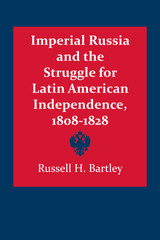 Imperial Russia and the Struggle for Latin American Independence, 1808–1828
By Russell H. Bartley
University of Texas Press, 1978 This study, the first of its kind in English, examines Russian responses to the independence movement in Latin America during the early nineteenth century. From a strictly presentist perspective, the investigation of this subject contributes to the historiography of colonialism and of Latin America's relations with the major world powers. In addition, it rounds out the story of foreign interests in the emancipation of Spanish and Portuguese America, while at the same time shedding new light on the history of Russian overseas expansion.
The study probes the major determinants of Russian responses to the struggle for independence of colonial Latin America and evaluates, from a European perspective, the actual impact of tsarist policy on the course of those historic events. Drawing on a wide range of printed materials and on hitherto unused manuscript sources from the archives and libraries of Spain, Portugal, Brazil, and the USSR, it isolates Russian New World objectives during the first decades of the nineteenth century and relates those objectives to the formulation of tsarist policy toward the insurgent Iberian colonies.
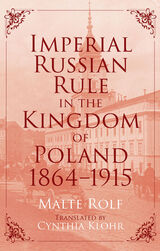 Imperial Russian Rule in the Kingdom of Poland, 1864-1915
Malte Rolf
University of Pittsburgh Press, 2021 After crushing the Polish Uprising in 1863–1864, Russia established a new system of administration and control. Imperial Russian Rule in the Kingdom of Poland, 1864–1915 investigates in detail the imperial bureaucracy’s highly variable relationship with Polish society over the next half century. It portrays the personnel and policies of Russian domination and describes the numerous layers of conflict and cooperation between the Tsarist officialdom and the local population. Presenting case studies of both modes of conflict and cooperation, Malte Rolf replaces the old, unambiguous “freedom-loving Poles vs. oppressive Russians” narrative with a more nuanced account and does justice to the complexity and diversity of encounters among Poles, Jews, and Russians in this contested geopolitical space. At the same time, he highlights the process of “provincializing the center,” the process by which the erosion of imperial rule in the Polish Kingdom facilitated the demise of the Romanov dynasty itself.
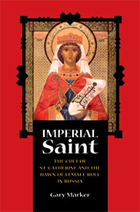 Imperial Saint: The Cult of St. Catherine and the Dawn of Female Rule in Russia
Gary Marker
Northern Illinois University Press, 2011
Historian Gary Marker traces the Russian veneration of St. Catherine of Alexandria from its beginnings in Kievan times through the onset of female rulership in the 18th century. Two narratives emerge. The first focuses on St. Catherine within Christendom and, specifically, within Russia. The second shifts attention to the second wife of Peter the Great, Catherine I, who became Russia’s first crowned female ruler. Marker then explores the evolution of divine queenship and the Catherine cult through the reigns of Elizabeth and Catherine the Great.
Russia’s cult of St. Catherine diverged from the veneration of Catherine in Western Christendom in several ways, particularly in the evolution of the Bride of Christ theme. Also, while St. Catherine became a figure of personal intercession in the West, her persona in Russia took a different path, one that valorized her regal and masculine qualities—attributes that supported her emerging role as a patron saint of the women of the ruling family.
The intersection of gender, power, and religion is a central theme of this study. Under Catherine I, the ruler’s identification with St. Catherine, her name-day saint, became critical. In ever-widening cascades of public ceremonies, Catherine was lauded as her saint’s living image, an affinity that ultimately provided the basis for establishing a distinctly female path to divinely chosen leadership.
Imperial Saint draws upon extensive and often rare sources, including service books, saints’ lives, sermons, public ceremonies, pilgrims’ accounts, laws, and personal correspondence. It also calls attention to icons, iconostases, fireworks, processionals, and other visual evidence. For readers interested in saints’ cults, the ritualization of power, and the relationship between gender and religion—as well as scholars who study St. Catherine—this stimulating study offers valuable insights.
Imperial Screen: Japanese Film Culture In The Fifteen Years War,
Peter B. High
University of Wisconsin Press, 2003 From the late 1920s through World War II, film became a crucial tool in the state of Japan. Detailing the way Japanese directors, scriptwriters, company officials, and bureaucrats colluded to produce films that supported the war effort, The Imperial Screen is a highly-readable account of the realities of cultural life in wartime Japan. Widely hailed as "epoch-making" by the Japanese press, it presents the most comprehensive survey yet published of "national policy" films, relating their montage and dramatic structures to the cultural currents, government policies, and propaganda goals of the era. Peter B. High’s treatment of the Japanese film world as a microcosm of the entire sphere of Japanese wartime culture demonstrates what happens when conscientious artists and intellectuals become enmeshed in a totalitarian regime.
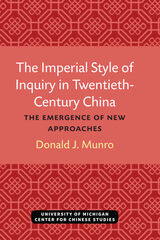 The Imperial Style of Inquiry in Twentieth-Century China: The Emergence of New Approaches
Donald J. Munro
University of Michigan Press, 1996 How have traditional Chinese ways of thinking affected problem solving in this century? The traditional, imperial style of inquiry is associated with the belief that the universe is a coherent, internally structured unity understandable through the similarly structured human mind. It involves a reliance on antecedent and authoritarian models, coupled with an introspective focus in investigations, at some cost to objective fact gathering. In contrast, emergent forms of inquiry are guided by the values of individual autonomy and new perspectives on objectivity. In the 1930s and 1940s, some liberal educators held the model of Western science in great esteem, and some scientists practicing objective inquiry helped to create an awareness in the urban areas of inquiry not directed by political values. Drawing on philosophical, social science, and popular culture materials, Donald Munro shows that the two strains coexisted in twentieth century China as mixed motives. Many important figures were motivated by a desire to act consistently with the social values associated with the premodern or received view of knowledge and inquiry. At the same time, these people often had other motives, such as utilitarian values, efficiency, and entrepreneurship. Munro argues that while many competing positions can coexist in the same person, the seeds of the positive, instrumental value of individual autonomy in Chinese inquiry are beginning to compete in both scholarly and popular culture with other, older approaches.
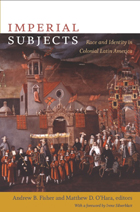 Imperial Subjects: Race and Identity in Colonial Latin America
Andrew B. Fisher and Matthew D. O Hara, eds.
Duke University Press, 2009 In colonial Latin America, social identity did not correlate neatly with fixed categories of race and ethnicity. As Imperial Subjects demonstrates, from the early years of Spanish and Portuguese rule, understandings of race and ethnicity were fluid. In this collection, historians offer nuanced interpretations of identity as they investigate how Iberian settlers, African slaves, Native Americans, and their multi-ethnic progeny understood who they were as individuals, as members of various communities, and as imperial subjects. The contributors’ explorations of the relationship between colonial ideologies of difference and the identities historical actors presented span the entire colonial period and beyond: from early contact to the legacy of colonial identities in the new republics of the nineteenth century. The volume includes essays on the major colonial centers of Mexico, Peru, and Brazil, as well as the Caribbean basin and the imperial borderlands. Whether analyzing cases in which the Inquisition found that the individuals before it were “legally” Indians and thus exempt from prosecution, or considering late-eighteenth- and early-nineteenth-century petitions for declarations of whiteness that entitled the mixed-race recipients to the legal and social benefits enjoyed by whites, the book’s contributors approach the question of identity by examining interactions between imperial subjects and colonial institutions. Colonial mandates, rulings, and legislation worked in conjunction with the exercise and negotiation of power between individual officials and an array of social actors engaged in countless brief interactions. Identities emerged out of the interplay between internalized understandings of self and group association and externalized social norms and categories. Contributors. Karen D. Caplan, R. Douglas Cope, Mariana L. R. Dantas, María Elena Díaz, Andrew B. Fisher, Jane Mangan, Jeremy Ravi Mumford, Matthew D. O’Hara, Cynthia Radding, Sergio Serulnikov, Irene Silverblatt, David Tavárez, Ann Twinam
The Imperial Sublime: A Russian Poetics of Empire
Harsha Ram
University of Wisconsin Press, 2003 The Imperial Sublime examines the rise of the Russian empire as a literary theme simultaneous with the evolution of Russian poetry between the 1730s and 1840—the century during which poets defined the main questions facing Russian literature and society. Harsha Ram shows how imperial ideology became implicated in an unexpectedly wide range of issues, from formal problems of genre, style, and lyric voice to the vexed relationship between the poet and the ruling monarch.
Imperial Texas: An Interpretive Essay in Cultural Geography
By D. W. Meinig
University of Texas Press, 1969 Imperial Texas examines the development of Texas as a human region, from the simple outline of the Spanish colony to the complex patterns of the modern state. In this study in cultural geography set into a historical framework, D. W. Meinig discusses the "various peoples of Texas, who they are, where they came from, where they settled, and how they are proportioned one to another from place to place." After examining the historical framework, he then presents detailed analyses of the major regions of modem Texas and an over-all characterization of the state and its people. He concludes that, although Texas has never been the empire that it has sometimes been called, "nevertheless... Texas is something more than just one-fourteenth of the American area, one-twentieth of the American people, and one-fiftieth of the American union."
Imperial Transformations in Sixteenth-Century Yucay, Peru
Transcribed and edited by R. Alan Covey and Donato Amado González
University of Michigan Press, 2008 In this volume, R. Alan Covey and Donato Amado González present an archaeological and historical introduction to the Yucay Valley, as well as the complete transcription of the first volume of documents in the Betancur Collection.
 Imperial White: Race, Diaspora, and the British Empire
Radhika Mohanram
University of Minnesota Press, 2007 Radhika Mohanram shows not just how British imperial culture shaped the colonies, but how the imperial rule of colonies shifted—and gave new meanings to—what it meant to be British. Imperial White looks at literary, social, and cultural texts on the racialization of the British body and investigates British whiteness in the colonies to address such questions as: How was the whiteness in Britishness constructed by the presence of Empire? How was whiteness incorporated into the idea of masculinity? Does heterosexuality have a color? And does domestic race differ from colonial race? In addition to these inquiries on the issues of race, class, and sexuality, Mohanram effectively applies the methods of whiteness studies to British imperial material culture to critically racialize the relationship between the metropole and the peripheral colonies. Considering whether whiteness, like theory, can travel, Mohanram also provides a new perspective on white diaspora, a phenomenon of the nineteenth century that has been largely absent in diaspora studies, ultimately rereading—and rethinking—British imperial whiteness. Radhika Mohanram teaches postcolonial cultural studies in the School of English, Communication and Philosophy at Cardiff University, Wales. She is the author of Black Body: Women, Colonialism, Space (Minnesota, 1999) and edits the journal Social Semiotics.
Imperialism
J. A. Hobson
University of Michigan Press, 1964 A classic 19th-century indictment of imperialism
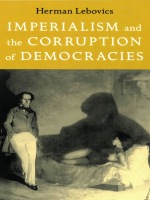 Imperialism and the Corruption of Democracies
Herman Lebovics
Duke University Press, 2006 In this important volume, Herman Lebovics, a preeminent cultural historian of France, develops a historical argument with striking contemporary relevance: empire abroad inevitably undermines democracy at home. These essays, which Lebovics wrote over the past decade, demonstrate the impressive intellectual range of his work. Focusing primarily on France and to a lesser extent on the United Kingdom, he shows how empire and its repercussions have pervaded—and corroded—Western cultural, intellectual, and social life from the mid-nineteenth century to the present. Some essays explore why modern Western democratic societies needed colonialism. Among these is an examination of the seventeenth-century philosopher John Locke’s prescient conclusion that liberalism could only control democratic forces with the promise of greater wealth enabled by empire. In other essays Lebovics considers the relation between overseas rule and domestic life. Discussing George Orwell’s tale “Shooting an Elephant” and the careers of two colonial officers (one British and one French), he contemplates the ruinous authoritarianism that develops among the administrators of empire. Lebovics considers Pierre Bourdieu’s thinking about how colonialism affected metropolitan French life, and he reflects on the split between sociology and ethnology, which was partly based on a desire among intellectuals to think one way about metropolitan populations and another about colonial subjects. Turning to the arts, Lebovics traces how modernists used the colonial “exotic” to escape the politicized and contested modernity of the urban West. Imperialism and the Corruption of Democracies is a compelling case for cultural history as a key tool for understanding the injurious effects of imperialism and its present-day manifestations within globalization.
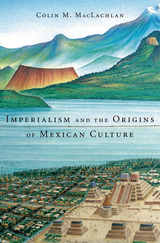 Imperialism and the Origins of Mexican Culture
Colin M. MacLachlan
Harvard University Press, 2015 With an empire stretching across central Mexico, unmatched in military and cultural might, the Aztecs seemed poised on the brink of a golden age in the early sixteenth century. But the arrival of the Spanish changed everything. Imperialism and the Origins of Mexican Culture chronicles this violent clash of two empires and shows how modern Mestizo culture evolved over the centuries as a synthesis of Old and New World civilizations.
Colin MacLachlan begins by tracing Spain and Mesoamerica’s parallel trajectories from tribal enclaves to complex feudal societies. When the Spanish laid siege to Tenochtitlán and destroyed it in 1521, the Aztecs could only interpret this catastrophe in cosmic terms. With their gods discredited and their population ravaged by epidemics, they succumbed quickly to Spanish control—which meant submitting to Christianity. Spain had just emerged from its centuries-long struggle against the Moors, and zealous Christianity was central to its imperial vision. But Spain’s conquistadors far outnumbered its missionaries, and the Church’s decision to exclude Indian converts from priesthood proved shortsighted. Native religious practices persisted, and a richly blended culture—part Indian, part Christian—began to emerge.
The religious void left in the wake of Spain’s conquests had enduring consequences. MacLachlan’s careful analysis explains why Mexico is culturally a Mestizo country while ethnically Indian, and why modern Mexicans remain largely orphaned from their indigenous heritage—the adopted children of European history.
|
|
